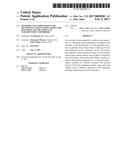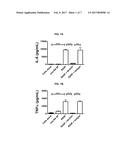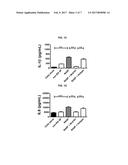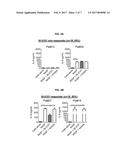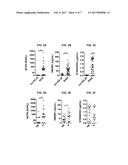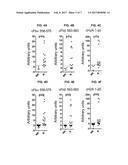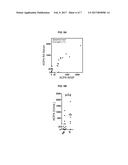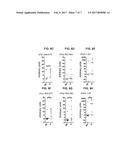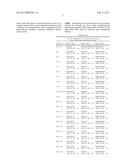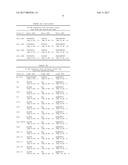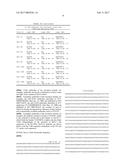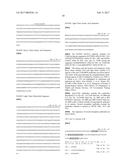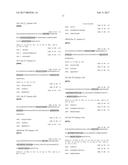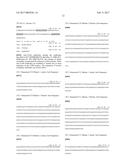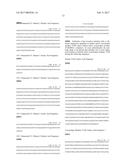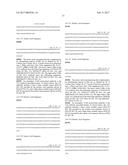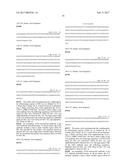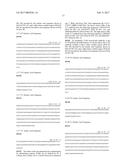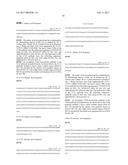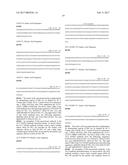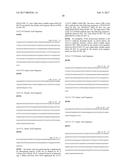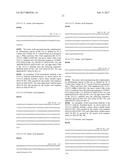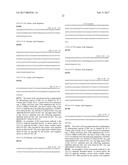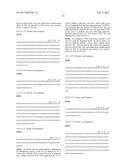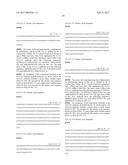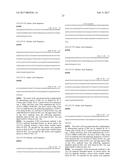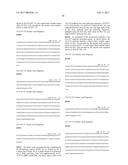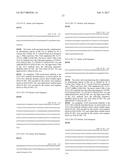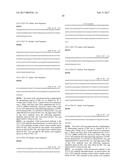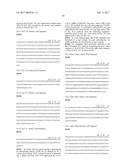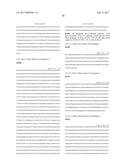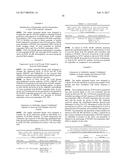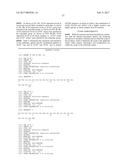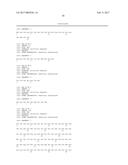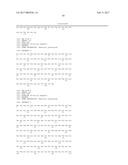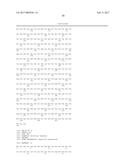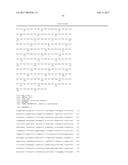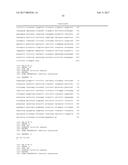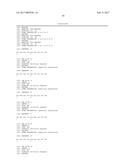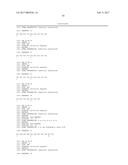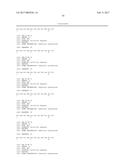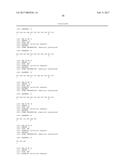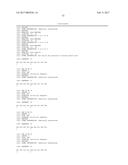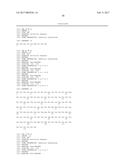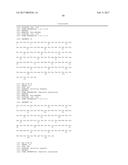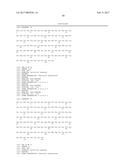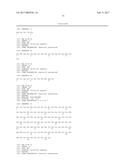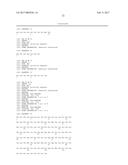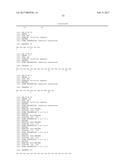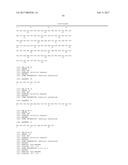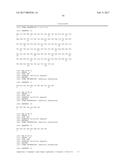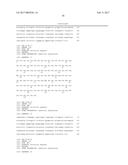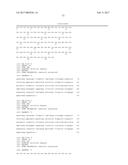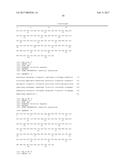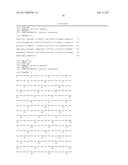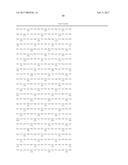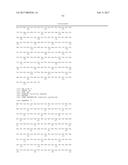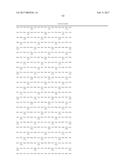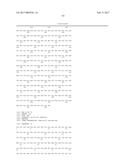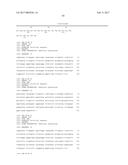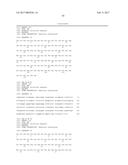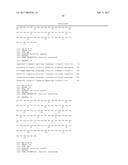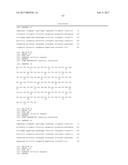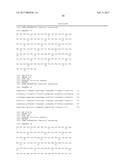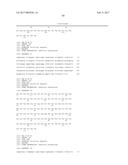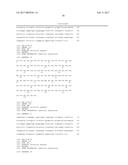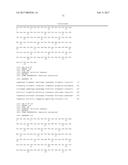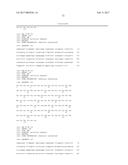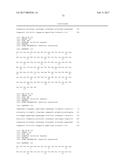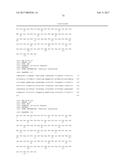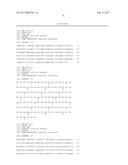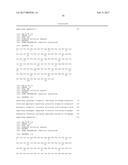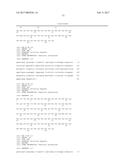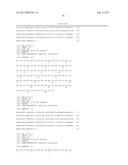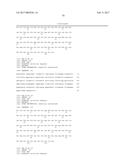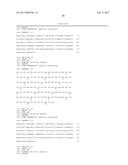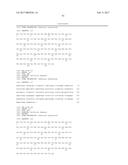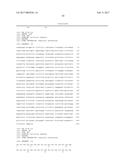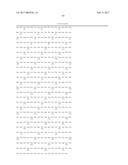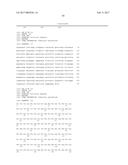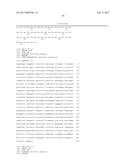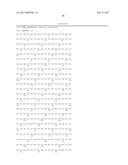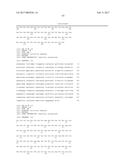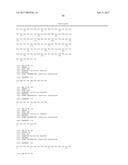Patent application title: METHODS AND COMPOSITIONS FOR IDENTIFYING PATIENT POPULATIONS FOR DIAGNOSIS AND TREATMENT OF TLR4-DEPENDENT DISORDERS
Inventors:
IPC8 Class: AG01N33564FI
USPC Class:
1 1
Class name:
Publication date: 2017-02-09
Patent application number: 20170038381
Abstract:
This invention relates generally to methods and compositions for
identifying patient populations for diagnosis and treatment of Toll-like
Receptor 4 (TLR4)-dependent disorders. In particular, the invention
relates to detecting levels of anti-citrullinated protein antibodies
(ACPA) and citrullinated peptides to identify patients having a
TLR4-dependent disease and to identify patients who are likely to respond
to anti-TLR4 therapy. The invention also relates to methods of treating,
delaying the progression of, or otherwise ameliorating a symptom of a
disorder in patients with elevated levels of ACPA and citrullinated
peptides using agents that interfere with or otherwise antagonize TLR-4
signaling, including neutralizing anti-TLR4 antibodies.Claims:
1. A method for identifying a patient suitable for therapy with an
antagonist of Toll-like Receptor 4 (TLR4) and alleviating a symptom of a
TLR4-related disorder, the method comprising detecting a level of
expression for anti-citrullinated protein antibody (ACPA) and/or at least
one antibody against specific citrullinated protein and/or peptide
comprising an amino acid sequence selected from the group consisting of
SEQ ID NO: 1, SEQ ID NO: 2, and SEQ ID NO: 3 in at least a first
biological sample from a subject, comparing the detected level of ACPA
and/or the at least one antibody against specific citrullinated protein
and/or peptide to a control level of expression, and when the detected
level is elevated, administering an anti-TLR4 antagonist in an amount
sufficient to alleviate the symptom of the TLR4-related disorder to the
subject.
2. The method of claim 1, wherein the method comprises detecting a level of expression for ACPA and/or a level of expression of an antibody against the peptide of SEQ ID NO: 1, an antibody against the peptide of SEQ ID NO: 2, an antibody against peptide of SEQ ID NO: 3, and any combinations thereof.
3. The method of claim 1, wherein the biological sample is or is derived from blood.
4. The method of claim 1, wherein the biological sample is serum.
5. The method of claim 1, wherein the biological sample is or is derived from synovial fluid.
6. The method of claim 1, wherein the method further comprises detecting a level of expression for ACPA and/or at least one antibody against a specific citrullinated peptide comprising an amino acid sequence selected from the group consisting of SEQ ID NO: 1, SEQ ID NO: 2, and SEQ ID NO: 3 in a second biological sample from the same subject.
7. The method of claim 6, wherein the first biological sample is or is derived from blood.
8. The method of claim 7, wherein the first biological sample is serum.
9. The method of claim 6, wherein the second biological sample is or is derived from synovial fluid.
10. The method of claim 1, wherein the anti-TLR4 antagonist is an anti-TLR4 antibody or immunologically active fragment thereof.
11. The method of claim 10, wherein the anti-TLR4 antibody or immunologically active fragment thereof comprises a variable heavy chain complementarity determining region 1 (VH CDR1) the amino acid sequence of GGYSWH (SEQ ID NO: 139); a VH CDR2 region comprising the amino acid sequence of YIHYSGYTDFNPSLKT (SEQ ID NO: 140); a VH CDR3 region comprising the amino acid sequence of KDPSDAFPY (SEQ ID NO: 141); a variable light chain complementarity determining region 1 (VL CDR1) region comprising the amino acid sequence of RASQSISDHLH (SEQ ID NO: 4); a VL CDR2 region comprising the amino acid sequence of YASHAIS (SEQ ID NO: 5); and a VL CDR3 region comprising the amino acid sequence of QQGHSFPLT (SEQ ID NO: 6).
12. The method of claim 10, wherein the anti-TLR4 antibody or immunologically active fragment thereof comprises the heavy chain variable amino acid sequence QVQLQESGPGLVKPSDTLSLTCAVSGYSITGGYSWHWIRQPPGKGLEWMGYIHYSGYT DFNPSLKTRITISRDTSKNQFSLKLSSVTAVDTAVYYCARKDPSDAFPYWGQGTLVTVSS (SEQ ID NO: 7) and the light chain variable amino acid sequence EIVLTQSPDFQSVTPKEKVTITCRASQSISDHLHWYQQKPDQSPKLLIKYASHAISGVPSR FSGSGSGTDFTLTINSLEAEDAATYYCQQGHSFPLTFGGGTKVEIK (SEQ ID NO: 8).
13. The method of claim 10, wherein the anti-TLR4 antibody or immunologically active fragment thereof comprises the heavy chain amino acid sequence MGWSWIFLFLLSGTAGVHCQVQLQESGPGLVKPSDTLSLTCAVSGYSITGGYSWHWIR QPPGKGLEWMGYIHYSGYTDFNPSLKTRITISRDTSKNQFSLKLSSVTAVDTAVYYCAR KDPSDAFPYWGQGTLVTVSSASTKGPSVFPLAPSSKSTSGGTAALGCLVKDYFPEPVTVS WNSGALTSGVHTFPAVLQSSGLYSLSSVVTVPSSSLGTQTYICNVNHKPSNTKVDKRVE PKSCDKTHTCPPCPAPELLGGPSVFLFPPKPKDTLMISRTPEVTCVVVDVSHEDPEVKFN WYVDGVEVHNAKTKPREEQYNSTYRVVSVLTVLHQDWLNGKEYKCKVSSKAFPAPIE KTISKAKGQPREPQVYTLPPSREEMTKNQVSLTCLVKGFYPSDIAVEWESNGQPENNYK TTPPVLDSDGSFFLYSKLTVDKSRWQQGNVFSCSVMHEALHNHYTQKSLSLSPGK (SEQ ID NO: 9) and the light chain amino acid sequence MEWSWVFLFFLSVTTGVHSEIVLTQSPDFQSVTPKEKVTITCRASQSISDHLHWYQQKPD QSPKLLIKYASHAISGVPSRFSGSGSGTDFTLTINSLEAEDAATYYCQQGHSFPLTFGGGT KVEIKRTVAAPSVFIFPPSDEQLKSGTASVVCLLNNFYPREAKVQWKVDNALQSGNSQE SVTEQDSKDSTYSLSSTLTLSKADYEKHKVYACEVTHQGLSSPVTKSFNRGEC (SEQ ID NO: 10).
14. The method of claim 1, wherein the subject is human.
15. The method of claim 1, wherein the disorder is an autoimmune or inflammatory disorder.
16. The method of claim 1, wherein the disorder is associated with aberrant TLR4 signaling, elevated TLR4 ligand expression or activity, aberrant pro-inflammatory cytokine production, and combinations thereof.
17. The method of claim 1, wherein the disorder is rheumatoid arthritis (RA).
18. A method for diagnosing a TLR4-related disorder in a subject, the method comprising detecting a level of expression for anti-citrullinated protein antibody (ACPA) and/or at least one antibody against specific citrullinated protein and/or peptide comprising an amino acid sequence selected from the group consisting of SEQ ID NO: 1, SEQ ID NO: 2, and SEQ ID NO: 3 in at least a first biological sample from a subject, comparing the detected level of ACPA and/or the at least one antibody against specific citrullinated protein and/or peptide to a control level of expression, and when the detected level is elevated, diagnosing the subject with a TLR4-related disorder.
19. The method of claim 18, wherein the method comprises detecting a level of expression for ACPA and/or a level of expression of an antibody against the peptide of SEQ ID NO: 1, an antibody against the peptide of SEQ ID NO: 2, an antibody against peptide of SEQ ID NO: 3, and any combinations thereof.
20. The method of claim 18, wherein the biological sample is or is derived from blood.
21. The method of claim 18, wherein the biological sample is serum.
22. The method of claim 18, wherein the biological sample is or is derived from synovial fluid.
23. The method of claim 18, wherein the method further comprises detecting a level of expression for ACPA and/or at least one antibody against a specific citrullinated peptide comprising an amino acid sequence selected from the group consisting of SEQ ID NO: 1, SEQ ID NO: 2, and SEQ ID NO: 3 in a second biological sample from the same subject.
24. The method of claim 23, wherein the first biological sample is or is derived from blood.
25. The method of claim 24, wherein the first biological sample is serum.
26. The method of claim 23, wherein the second biological sample is or is derived from synovial fluid.
27. The method of claim 18, wherein the subject is human.
28. The method of claim 18, wherein the TLR4-related disorder is an autoimmune or inflammatory disorder.
29. The method of claim 18, wherein the TLR4-related disorder is associated with aberrant TLR4 signaling, elevated TLR4 ligand expression or activity, aberrant pro-inflammatory cytokine production, and combinations thereof.
30. The method of claim 18, wherein the TLR4-related disorder is rheumatoid arthritis (RA).
Description:
RELATED APPLICATIONS
[0001] This application claims the benefit of U.S. Provisional Application No. 62/201,918, filed Aug. 6, 2015, the contents of which are incorporated herein by reference in their entirety.
INCORPORATION OF SEQUENCE LISTING
[0002] The contents of the text file named "NOVI041001US_ST25.txt", which was created on Aug. 5, 2016 and is 115 KB in size, are hereby incorporated by reference in their entirety.
FIELD OF THE INVENTION
[0003] This invention relates generally to methods and compositions for identifying patient populations for diagnosis and treatment of Toll-like Receptor 4 (TLR4)-dependent disorders. In particular, the invention relates to detecting levels of anti-citrullinated protein antibodies (ACPA) and/or antibodies against specific citrullinated proteins and/or peptides to identify patients having a TLR4-dependent disease and to identify patients who are likely to respond to anti-TLR4 therapy. The invention also relates to methods of treating, delaying the progression of, or otherwise ameliorating a symptom of a disorder in patients with elevated levels of ACPA and/or antibodies against specific citrullinated proteins and/or peptides using agents that interfere with or otherwise antagonize TLR-4 signaling, including neutralizing anti-TLR4 antibodies.
BACKGROUND OF THE INVENTION
[0004] Toll receptors, first discovered in Drosophila, are type I transmembrane protein having leucine-rich repeats (LRRs) in the extracellular portion of the protein, and one or two cysteine-rich domains. The mammalian homologs of the Drosophila Toll receptors are known as "Toll-like receptors" (TLRs). TLRs play a role in innate immunity by recognizing microbial particles and activating immune cells against the source of these microbial particles. In humans, eleven Toll-like receptors, TLRs 1-11, have been identified and are characterized by the homology of their intracellular domains to that of the IL-1 receptor, and by the presence of extracellular leucine-rich repeats. The different types of TLRs are activated by different types of microbial particles. For example, TLR4 is primarily activated by lipopolysaccharide (LPS). TLR4 has been shown to associate with an accessory protein, myeloid differentiation protein-2 (MD-2). This protein has been found to interact directly with TLR4, and MD-2 has the ability to enable post-translational modifications of TLR4, as well as facilitate its transport to the cell surface. TLR4 and MD-2 form a complex on the cell surface.
[0005] TLR4 has been implicated in a number of disorders; and anti-TLR4 agents are being developed as therapeutic agents. Not all patients respond to current standard of care therapies. Accordingly, there exists a need for compositions and methods for use in identifying patients that are likely candidates for a particular treatment, for example, treatment with a particular anti-TLR4 therapy.
SUMMARY OF THE INVENTION
[0006] The compositions and methods provided herein are useful in identifying or otherwise refining a patient population suffering from a disorder, where the patient has an elevated level of one or more TLR4 ligands or other TLR4-related biomarkers. These patients are identified as suitable candidates for treatment with an agent (e.g., antibodies or other polypeptide-based therapeutics, peptide-based therapeutics, small molecule inhibitors, nucleic acid-based therapeutics and derivatives thereof) that interferes with or otherwise antagonizes TLR4 signaling and neutralizes at least one biological activity of TLR4, alone or in the context of the accessory protein MD-2 as the TLR4/MD-2 complex.
[0007] In some patients suffering from or suspected of suffering from a disorder, fluids and other biological samples contain elevated levels of TLR4 ligands such as immune complexes containing ACPA and citrullinated proteins and/or peptides. These TLR4 ligands stimulate cells to produce pro-inflammatory cytokines. However, use of an anti-TLR4 antagonist that interferes with or otherwise antagonizes TLR4 signaling, e.g., a neutralizing anti-TLR4 antibody or other anti-TLR4 agent, is shown herein to block this stimulation in patients exhibiting an elevated level of expression for one or more TLR4 ligands and/or other related biomarkers. Thus, the compositions and methods are useful in treating, delaying the progression of or otherwise ameliorating a symptom of a disorder that is dependent on, driven by, or otherwise associated with TLR4 signaling, aberrant, e.g., elevated, TLR4 ligand expression and/or activity, aberrant pro-inflammatory cytokine production, and/or combinations thereof, by administering an anti-TLR4 antagonist, e.g., a neutralizing anti-TLR4 antibody or other polypeptide-based therapeutic, a peptide-based therapeutic, a small molecule inhibitor, a nucleic acid-based therapeutic and derivatives thereof, to patients exhibiting an elevated level of expression for one or more TLR4 ligands and/or related biomarkers. Patients that are likely suitable candidates for treatment with the anti-TLR4 antagonist, e.g., neutralizing anti-TLR4 antibody such as those described herein, are identified by detecting the level of one or more TLR4 ligands or other related biomarkers.
[0008] Suitable TLR4 ligands and other related biomarkers for use in identifying likely candidates include ACPA and/or antibody against one or more specific citrullinated proteins and/or peptides. In some embodiments, the citrullinated peptide is derived from citrullinated fibrinogen (cFb). In some embodiments, the citrullinated peptide is derived from citrullinated fibrinogen alpha (cFb.alpha.). In some embodiments, the citrullinated peptide is derived from citrullinated fibrinogen beta (cFb.beta.). In some embodiments, the citrullinated peptide is derived from citrullinated histone. In some embodiments, the citrullinated peptide is derived from citrullinated histone 2A.
[0009] In some embodiments, the citrullinated peptide comprises the amino acid sequence NTKESSSHHPGIAEFPS-Cit-GK (SEQ ID NO: 1), where Cit=citrulline. This peptide is referred to herein as cFb.alpha. 556-575.
[0010] In some embodiments, the citrullinated peptide comprises the amino acid sequence HHPGIAEFPS-Cit-GKSSSYSKQF (SEQ ID NO: 2), where Cit=citrulline. This peptide is referred to herein as citFb.beta. 563-583.
[0011] In some embodiments, the citrullinated peptide comprises the amino acid sequence MSG-Cit-GKQGGKA-Cit-AKAKS-Cit-SS (SEQ ID NO: 3), where Cit=citrulline. This peptide is referred to herein as citH2A 1-20.
[0012] In the methods provided herein, the level of expression of ACPA and/or antibody against one or more specific citrullinated protein and/or peptides is detected in a biological sample. In some embodiments, the level of expression of ACPA and/or antibody against one or more specific citrullinated protein and/or peptides is detected in a combination of biological samples. In some embodiments, the biological sample is synovial fluid. In some embodiments, the biological sample is blood or is derived from blood. In some embodiments, the biological sample is serum. In some embodiments, the biological sample is a combination of synovial fluid and serum samples.
[0013] Patients with elevated levels of one or more of these markers are identified as suitable candidates for therapy with one or more anti-TLR4 antagonists, e.g., a neutralizing anti-TLR4 antibody described herein. As used herein, the phrase "elevated level of expression" refers to a level of expression that is greater than a baseline level of expression of ACPA and/or antibody against one or more specific citrullinated protein and/or peptides in a sample from a patient that is not suffering from or suspected of suffering from a disorder or other control sample. In some embodiments, the elevated level of expression of ACPA and/or antibody against one or more specific citrullinated protein and/or peptides is a significant level of elevation.
[0014] Patients where treatment with an anti-TLR4 antibody was able to block, partially or totally, cytokine production in rheumatoid arthritis monocytes are identified as "responders," while patients where treatment with an anti-TLR4 antibody did not block, partially or totally, cytokine production are identified as "non-responders."
[0015] In addition to detecting the level of ACPA and/or antibody against one or more specific citrullinated protein and/or peptides, suitable patients for treatment with an anti-TLR4 antagonist can also be identified by evaluating any of a number of additional biological and clinical parameters that will improve the sensitivity and specificity of the biomarker for identifying or otherwise refining the patient population. Alternatively, these additional biological and clinical parameters can be used alone as a means for identifying patients that are suitable candidates for treatment with an anti-TLR4 antagonist or other suitable therapy. These biological and clinical parameters include, by way of non-limiting example, any of the following: rheumatoid factor levels, C-reactive protein (CRP) levels, blood cells count, presence of TLR4 receptor on blood cell subpopulations, TLR4 polymorphisms, human leukocyte antigen (HLA) polymorphisms, peptidyl arginine deiminase (PAD) enzymes and PAD enzyme polymorphisms, Fc.gamma. Receptor IIa (Fc.gamma.IIa) polymorphisms, MD-2 levels, soluble CD14 levels, baseline patient demographic data (e.g., body mass index (BMI), sex, age, etc.) and/or patient medical history (e.g., disability assessment schedule (DAS 28) at diagnosis, DAS 28 at treatment initiation, duration of disease, age at disease onset, response to prior treatments based on DAS28, American College of Rheumatology (ACR) and/or European League Against Rheumatism (EULAR) response criteria, etc.).
[0016] Disorders that are useful with the compositions and methods of the invention include any disorder where aberrant, e.g., elevated, TLR4 expression and/or activity, with aberrant TLR4/MD-2 activation and/or aberrant TLR4 ligand activity (e.g., aberrant stimulation of pro-inflammatory cytokine production such as aberrant stimulation of IL-6, TNF.alpha. and/or IL-8 production). For example, some TLR4 ligands are believed to be associated with various disorders. By way of non-limiting example, LPS is known to be associated with disorders such as sepsis, acute lung injury, and/or RA; Tenascin C is known to be associated with disorders such as arthritis, hepatic and/or cardiac ischemial reperfusion; HMGB1 is known to be associated with disorders such as RA, Osteoarthritis (OA), ischemia/reperfusion, Type 1 diabetes, islet transplantation, lupus and/or sepsis; S100A8/A9 is known to be associated with disorders such as RA, OA, juvenile idiopathic arthritis (JIA), diabetes, transplant rejection, lupus, atherosclerosis, sepsis and/or cancer; citrullinated fibrinogen is known to be associated with disorders such as RA and atherosclerosis; ACPA is known to be associated with disorders such as RA, psoriatic arthritis, systemic lupus erythematosus (SLE), Sjogren's syndrome, Alzheimer disease and/or atherosclerosis.
[0017] By way of non-limiting examples, the methods and compositions provided herein are suitable for diagnosing and/or treating disorders such as autoimmune and/or inflammatory disorders. Suitable autoimmune and/or inflammatory disorders include, by way of non-limiting example, autoimmune and/or inflammatory disorders associated with aberrant TLR4 signaling, autoimmune and/or inflammatory disorders associated with aberrant, e.g., elevated, TLR4 ligand expression and/or activity, autoimmune and/or inflammatory disorders associated with aberrant pro-inflammatory cytokine production, and combinations thereof.
[0018] In some embodiments, the disorder is an arthritis condition, including by way of non-limiting example, RA, Osteoarthritis (OA), psoriatic arthritis or juvenile idiopathic arthritis (JIA). In some embodiments, the disorder is rheumatoid arthritis (RA). In some embodiments, the disorder is cancer. In some embodiments, the disorder is inflammatory bowel disease (IBD). In some embodiments, the disorder is atherosclerosis. In some embodiments, the disorder is associated with ischemial reperfusion, including by way of non-limiting example, hepatic and/or cardiac ischemia/reperfusion. In some embodiments, the disorder is sepsis. In some embodiments, the disorder is acute lung injury. In some embodiments, the disorder is Type 1 diabetes. In some embodiments, the disorder is associated with islet transplantation. In some embodiments, the disorder is lupus. In some embodiments, the disorder is associated with transplant rejection or other disorder associated with cell, tissue and/or organ transplant. In some embodiments, the disorder is systemic lupus erythematosus (SLE). In some embodiments, the disorder is Sjogren's syndrome. In some embodiments, the disorder is Alzheimer's disease.
[0019] Once patients are identified as having an elevated level of ACPA and/or antibody against one or more specific citrullinated protein and/or peptides, they are then treated with an anti TLR4 antagonist. For example, the anti TLR4 antagonist is a neutralizing anti TLR4 antibody or an immunologically active (e.g., antigen binding) fragment thereof. Suitable neutralizing antiTLR4 antibodies include any of the anti-TLR4 antibodies described herein and other antibodies with increased affinity for Fc receptor (FcR) and/or increased avidity for cell surface binding through interaction with FcR.
[0020] In some embodiments, the antibody or immunologically active fragment thereof that binds TLR4 comprises a variable heavy chain complementarity determining region 1 (VH CDR1) comprising an amino acid sequence at least 90%, 92%, 95%, 96%, 97% 98%, 99% or more identical to the amino acid sequence of GGYSWH (SEQ ID NO: 139); a VH CDR2 region comprising an amino acid sequence at least 90%, 92%, 95%, 96%, 97% 98%, 99% or more identical to the amino acid sequence of YIHYSGYTDFNPSLKT (SEQ ID NO: 140); and a VH CDR3 region comprising an amino acid sequence at least 90%, 92%, 95%, 96%, 97% 98%, 99% or more identical to the amino acid sequence of KDPSDAFPY (SEQ ID NO: 141); a variable light chain complementarity determining region 1 (VL CDR1) region comprising an amino acid sequence at least 90%, 92%, 95%, 96%, 97% 98%, 99% or more identical to the amino acid sequence of RASQSISDHLH (SEQ ID NO: 4); a VL CDR2 region comprising an amino acid sequence at least 90%, 92%, 95%, 96%, 97% 98%, 99% or more identical to the amino acid sequence of YASHAIS (SEQ ID NO: 5); and a VL CDR3 region comprising an amino acid sequence at least 90%, 92%, 95%, 96%, 97% 98%, 99% or more identical to the amino acid sequence of QQGHSFPLT (SEQ ID NO: 6). In some embodiments, the antibody or immunologically active fragment thereof that binds TLR4 further comprises an amino acid sequence at least 90%, 92%, 95%, 96%, 97% 98%, 99% or more identical to the heavy chain variable amino acid sequence QVQLQESGPGLVKPSDTLSLTCAVSGYSITGGYSWHWIRQPPGKGLEWMGYIHYSGYT DFNPSLKTRITISRDTSKNQFSLKLSSVTAVDTAVYYCARKDPSDAFPYWGQGTLVTVSS (SEQ ID NO: 7) and an amino acid sequence at least 90%, 92%, 95%, 96%, 97% 98%, 99% or more identical to the light chain variable amino acid sequence EIVLTQSPDFQSVTPKEKVTITCRASQSISDHLHWYQQKPDQSPKLLIKYASHAISGVPSR FSGSGSGTDFTLTINSLEAEDAATYYCQQGHSFPLTFGGGTKVEIK (SEQ ID NO: 8). In some embodiments, the antibody or immunologically active fragment thereof that binds TLR4 further comprises an amino acid sequence at least 90%, 92%, 95%, 96%, 97%, 98%, 99% or more identical to the heavy chain amino acid sequence MGWSWIFLFLLSGTAGVHCQVQLQESGPGLVKPSDTLSLTCAVSGYSITGGYSWHWIR QPPGKGLEWMGYIHYSGYTDFNPSLKTRITISRDTSKNQFSLKLSSVTAVDTAVYYCAR KDPSDAFPYWGQGTLVTVSSASTKGPSVFPLAPSSKSTSGGTAALGCLVKDYFPEPVTVS WNSGALTSGVHTFPAVLQSSGLYSLSSVVTVPSSSLGTQTYICNVNHKPSNTKVDKRVE PKSCDKTHTCPPCPAPELLGGPSVFLFPPKPKDTLMISRTPEVTCVVVDVSHEDPEVKFN WYVDGVEVHNAKTKPREEQYNSTYRVVSVLTVLHQDWLNGKEYKCKVSSKAFPAPIE KTISKAKGQPREPQVYTLPPSREEMTKNQVSLTCLVKGFYPSDIAVEWESNGQPENNYK TTPPVLDSDGSFFLYSKLTVDKSRWQQGNVFSCSVMHEALHNHYTQKSLSLSPGK (SEQ ID NO: 9) and an amino acid sequence at least 90%, 92%, 95%, 96%, 97% 98%, 99% or more identical to the light chain amino acid sequence MEWSWVFLFFLSVTTGVHSEIVLTQSPDFQSVTPKEKVTITCRASQSISDHLHWYQQKPD QSPKLLIKYASHAISGVPSRFSGSGSGTDFTLTINSLEAEDAATYYCQQGHSFPLTFGGGT KVEIKRTVAAPSVFIFPPSDEQLKSGTASVVCLLNNFYPREAKVQWKVDNALQSGNSQE SVTEQDSKDSTYSLSSTLTLSKADYEKHKVYACEVTHQGLSSPVTKSFNRGEC (SEQ ID NO: 10).
[0021] In some embodiments, anti-TLR4 antibody or immunologically active fragment thereof is or is derived from an antibody as described in PCT/IB2005/004206, filed Jun. 14, 2005 and published as WO 20071110678, the contents of which are hereby incorporated by reference in their entirety.
[0022] In some embodiments, anti-TLR4 antibody or immunologically active fragment thereof is or is derived from an antibody as described in PCT application PCT/IB2008/003978, filed May 14, 2008 and published as WO 2009/101479, the contents of which are hereby incorporated by reference in their entirety.
[0023] In some embodiments, anti-TLR4 antibody or immunologically active fragment thereof is or is derived from the anti-TLR4 antibody known as HTA125, which is described, for example, in Shimazu, et al., J. Exp. Med., val. 189:1777-1782 (1999); Nijhuis et al., Clin Diag. Lab. Immunol., val. 10(4): 558-63 (2003); and Pivarcsi et al., Intl. Immunopharm., vol. 15(6):721-730 (2003), the contents of each of which are hereby incorporated by reference in their entirety.
[0024] In some embodiments, the anti-TLR4 antibody or immunologically active fragment thereof is or is derived from a domain antibody such as, for example, the domain antibodies that bind TLR4 described in PCT application PCT/EP2009/055926, filed May 15, 2009 and published as WO 2009/13848, the contents of which are hereby incorporated by reference in their entirety.
[0025] In some embodiments, the anti-TLR4 antibody or immunologically active fragment thereof is or is derived from monoclonal antibodies recognizing human and/or cynomolgus monkey TLR4/MD-2 receptor expressed on the cell surface. The antibodies are capable of blocking, e.g., neutralizing, receptor activation and subsequent intracellular signaling induced TLR4 ligands, e.g., LPS or any other TLR4 ligand described herein. Antibodies of the invention include antibodies that bind human and cynomolgus monkey TLR4/MD-2 receptor complex and also bind TLR4 independently of the presence of MD-2.
[0026] In some embodiments, the anti-TLR4 antibody or immunologically active fragment thereof interferes with or otherwise antagonizes signaling via human and/or cynomolgus monkey TLR4/MD-2 receptor expressed on the cell surface, e.g., by blocking receptor activation and subsequent intracellular signaling induced by LPS. Exemplary monoclonal antibodies of these embodiments include: 1A1, 1A6, 1B12, 1C7, 1C10, 1C12, 1D10, 1E11, 1E11 N103D, 1G12, 1E11.C1, 1E11.C2, 1E11.C3, 1E11.C4, 1E11.C5, 1E11.C6, 1E11.E1, 1E11.E2, 1E11.E3, 1E11.E4, 1E11.E5, 1E11.C2E1, 1E11.C2E3, 1E11.C2E4 and 1E11.C2E5.
[0027] These antibodies have distinct specificities. Some antibodies show specificity for both the human and cynomolgus monkey TLR4 and/or both the human and cynomolgus monkey TLR4/MD-2 receptor complex, and they have been shown to inhibit receptor activation and subsequent intracellular signaling via LPS. For example, 1C12, 1E11, 1E11 N103D, 1E11.C1, 1E11.C2, 1E11.C3, 1E11.C4, 1E11.C5, 1E11.C6, 1E11.C2E1, 1E11.C2E2, 1E11.C2E3, 1E11.C2E4 and 1E11.C2E5 bind both human and cynomolgus monkey TLR4 independently of the presence of human or cynomolgus monkey MD-2. 1A1, 1A6, 1B12, 1C7, 1C10, 1D10 and 1G12 only bind to cynomolgus monkey TLR4 independently of the presence of cynomolgus monkey MD-2. 1E11.E1, 1E11.E2, 1E11.E3, 1E11.E4 and 1E11.E5 bind only to human TLR4 independently of the presence of human MD-2.
[0028] The humanized antibodies of the invention contain a heavy chain variable region having an amino acid sequence shown herein. The humanized antibodies of the invention contain a light chain variable region having an amino acid sequence shown herein.
[0029] The three heavy chain CDRs include an amino acid sequence at least 90%, 92%, 95%, 97% 98%, 99% or more identical to a variable heavy chain complementarity determining region 1 (VH CDR1, also referred to herein as CDRH1) amino acid sequence selected from the group consisting of G(F/Y)PI(R/G/W)(Y/F/G)GYS (SEQ ID NO: 14), GYSITGGYS (SEQ ID NO: 15); GFPIRYGYS (SEQ ID NO: 16); GYPIRFGYS (SEQ ID NO: 17); GYPIRHGYS (SEQ ID NO: 18); GFPIGQGYS (SEQ ID NO: 19); GYPIWGGYS (SEQ ID NO: 20) and GYPIGGGYS (SEQ ID NO: 21), a variable heavy chain complementarity determining region 2 (VH CDR2, also referred to herein as CDRH2) amino acid sequence of IHYSGYT (SEQ ID NO: 22); and a variable heavy chain complementarity determining region 3 (VH CDR3, also referred to herein as CDRH3) amino acid sequence selected from the group consisting of ARKDSG(N/Q/D/E)X.sub.1X.sub.2PY. (SEQ ID NO: 23) where X.sub.1 and X.sub.2 are each independently any hydrophobic amino acid, ARKDSGNYFPY (SEQ ID NO: 24); ARKDSGRLLPY (SEQ ID NO: 25); ARKDSGKWLPY (SEQ ID NO: 26); ARKDSGHLMPY (SEQ ID NO: 27); ARKDSGHNYPY (SEQ ID NO: 28); ARKDSGKNFPY (SEQ ID NO: 29); ARKDSGQLFPY (SEQ ID NO: 30); ARKDSGHNLPY (SEQ ID NO: 31); ARKDSGDYFPY (SEQ ID NO: 32) and ARKDSGRYWPY (SEQ ID NO: 33). The three light chain CDRs include an amino acid sequence at least 90%, 92%, 95%, 97% 98%, 99% or more identical to a variable light chain complementarity determining region 1 (VL CDR1, also referred to herein as CDRL1) amino acid sequence of QSISDH (SEQ ID NO: 34); a variable light chain complementarity determining region 2 (VL CDR2, also referred to herein as CDRL2) amino acid sequence of YAS (SEQ ID NO: 35); and a variable light chain complementarity determining region 3 (VL CDR3, also referred to herein as CDRL3) amino acid sequence selected from the group consisting of QQG(Y/N)(D/E)(F/Y)PXT (SEQ ID NO: 36) where X is any hydrophobic amino acid, QQGHSFPLT (SEQ ID NO: 6); QQGNDFPVT (SEQ ID NO: 37); QQGYDEPFT (SEQ ID NO: 38); QQGYDFPFT (SEQ ID NO: 39); QQGYDYPFT (SEQ ID NO: 40) and QQGYEFPFT (SEQ ID NO: 41). The antibodies bind to human and cynomolgus monkey TLR4/MD-2 complex, to human and cynomolgus TLR4 when not complexed with human and cynomolgus MD-2, to human TLR4/MD-2 complex, to human TLR4 when not complexed with human MD-2, to cynomolgus monkey TLR4/MD-2 complex or cynomolgus TLR4 when not complexed with cynomolgus MD-2.
[0030] The anti-TLR4 antibodies of the invention also include antibodies that include a heavy chain variable amino acid sequence that is at least 90%, 92%, 95%, 97%, 98%, 99% or more identical an amino acid sequence shown herein, and/or a light chain variable amino acid that is at least 90%, 92%, 95%, 97%, 98%, 99% or more identical an amino acid sequence shown herein.
[0031] In some embodiments, the anti-TLR4 antibodies described herein also include at least one specific amino acid substitution within, for example, an Fc region or an FcR binding fragment thereof (e.g., a polypeptide having amino acid substitutions within an IgG constant domain) such that the modified antibody elicits alterations in antigen-dependent effector function while retaining binding to antigen as compared to an unaltered antibody. For example, the altered antibodies elicit the prevention of proinflammatory mediator release. In a preferred embodiment, the altered antibodies are human and of the IgG1 isotype.
[0032] The anti-TLR4 antibodies of the invention include an altered antibody in which at least one amino acid residue in the constant region of the Fc portion of the antibody has been modified. For example, at least one amino acid in the CH2 domain of the Fc portion has been replaced by a different residue, i.e., an amino acid substitution. In the altered antibodies described herein, one or more of the amino acid residues that correspond to residues 325, 326 and 328 is substituted with a different residue as compared to an unaltered antibody. The numbering of the residues in the gamma heavy chain is that of the EU index (see Edelman, G. M. et al., 1969; Kabat, E, A., T. T. Wu, H. M. Perry, K. S. Gottesman, and C. Foeller., 1991. Sequences of Proteins of Immunological Interest, 5th Ed. U.S. Dept. of Health and Human Services, Bethesda, Md., NIH Publication n. 91-3242). In a preferred embodiment, EU amino acid position 325 of the gamma heavy chain constant region is substituted with serine, and EU amino acid position 328 of the gamma heavy chain constant region is substituted with phenylalanine, such that the EU positions 325 to 328 of the gamma heavy chain constant region of the altered human IgG1 antibody comprise the amino acid sequence SKAF (SEQ ID NO: 13).
[0033] The present invention also provides methods of treating or preventing pathologies associated with aberrant TLR4/MD-2 activation, aberrant TLR4 signaling, aberrant, e.g., elevated, TLR4 ligand expression and/or activity, aberrant pro-inflammatory cytokine production, and combinations thereof, or alleviating a symptom associated with such pathologies, by identifying a patient suitable for therapy with a neutralizing anti-TLR4 agent, e.g., a neutralizing anti-TLR4 antibody, and administering the agent, e.g., a monoclonal antibody of the invention (e.g., a murine monoclonal or humanized monoclonal antibody) to a subject in which such treatment or prevention is desired. The subject to be treated is, e.g., human. The monoclonal antibody is administered in an amount sufficient to treat, prevent or alleviate a symptom associated with the pathology. The amount of monoclonal antibody sufficient to treat or prevent the pathology in the subject is, for example, an amount that is sufficient to reduce TLR4 ligand-induced production of one or more pro-inflammatory cytokines (e.g., IL-6, IL-8, TNF.alpha.). As used herein, the term "reduced" refers to a decreased production of a pro-inflammatory cytokine in the presence of a monoclonal antibody of the invention, wherein the production is, for example, local pro-inflammatory cytokine production (e.g., at a site of inflamed tissue) or systemic pro-inflammatory cytokine production. TLR4 ligand-induced production of a pro-inflammatory cytokine is decreased when the level of pro-inflammatory cytokine production in the presence of a monoclonal antibody of the invention is greater than or equal to 5%, 10%, 20%, 25%, 30%, 40%, 50%, 60%, 70%, 75%, 80%, 90%, 95%, 99%, or 100% lower than a control level of pro-inflammatory cytokine production (i.e., the level of pro-inflammatory cytokine production in the absence of the monoclonal antibody). Level of pro-inflammatory cytokine production is measured. Those skilled in the art will appreciate that the level of pro-inflammatory cytokine production can be measured using a variety of assays, including, for example, the methods described herein as well as commercially available ELISA kits.
[0034] Pharmaceutical compositions according to the invention can include an anti-TLR4 antibody of the invention and a carrier. These pharmaceutical compositions can be included in kits, such as, for example, diagnostic kits.
[0035] The invention also provides kits for practicing any of the methods provided herein. For example, in some embodiments, the kits include a detection reagent specific for ACPA and/or antibody against one or more specific citrullinated protein and/or peptides and a means for detecting the detection reagent.
BRIEF DESCRIPTION OF THE DRAWINGS
[0036] FIGS. 1A, 1B, 1C, and 1D are a series of graphs depicting that treatment with the anti-TLR4 antibody referred to herein as NI-0101 blocks IL-6 (A), TNF.alpha. (B), IL-10 (C) and IL-8 (D) production from pooled rheumatoid arthritis synovial fluid (RASF)-stimulated monocytes isolated from rheumatoid arthritis (RA) patients. TLR4 signaling was blocked with anti-human TLR4 monoclonal antibody, NI-0101. Representative data shown for monocytes obtained from 1 of 7 RA patient donors. Data are presented as mean+/-SEM. The Mann-Whitney's U test was performed to analyze difference among groups. ** p<0.01, *** p<0.001.
[0037] FIGS. 2A and 2B are a series of graphs depicting the heterogeneous capacity of RASF samples to stimulate cytokine production and respond to TLR4 blockade. RASF samples from patients (Pat) were classified as NI-0101 responders (R) if NI-0101 was able to block (partially or totally) RASF-induced IL6 production from RA monocytes. Others were classified as NI-0101 non-responders (NR). Representative examples of non-responders RASF (Pat#13, #35) and responders RASF (Pat#27, #18) are depicted. Of the 36 RASF samples tested, 18 were classified as NI-0101 responders (50%) and 18 as NI-0101 responders (50%). Mann-Whitney's U test was performed to analyze difference among groups. *** p<0.001, * p<0.05.
[0038] FIGS. 3A, 3B, 3C, 3D, 3E, and 3F are a series of graphs depicting the expression levels of ACPA and TLR4 ligands in the synovial fluid samples of non RA and RA patients and their correlation with NI-0101 response. A-C, Expression levels of ACPA (A), HMGB1 (B) and S100A8/A9 (C) in synovial fluids from non-RA subjects (non-RASF; n=4 samples) and RA patients (RASF; n=36 samples). D-F, Correlation of levels of ACPA (D) and TLR4 ligands (E & F) with NI-0101 response. RASF samples were classified as NI-0101 non-responders (NR) or NI-0101 responders (R) according to the definition in FIG. 2. Mann-Whitney's U test was performed to analyze difference among groups. * p<0.05, ** p<0.01.
[0039] FIGS. 4A, 4B, 4C, 4D, 4E, and 4F are a series of graphs depicting the ACPA fine specificity in the synovial fluid samples of RA patients and their correlation with NI-0101 response. Antibody reactivity against the citrullinated peptides derived from fibrinogen-.alpha. (cFb.alpha. 556-575; FIG. 4A, FIG. 4D) fibrinogen-.beta. (cFb.beta. 563-583; FIG. 4B, FIG. 4E) and histone-2A (cH2A 1-20; FIG. 4C, FIG. 4F) were determined by ELISA in synovial fluids from RA patients and correlated with response to NI-0101. FIGS. 4A-4C, RASF samples from ACPA positive RA patients. FIG. 4D-4F, RASF samples from ACPA+ and ACPA- RA patients. RASF samples were classified as NI-0101 non-responders (NR) or NI-0101 responders (R). The difference in OD (delta OD) was calculated as the immunoreactivity against citrulline peptide minus the immunoreactivity against arginine control peptide. The data are shown as arbitrary units where the delta OD for each RASF sample was normalized by the threshold calculated with non-RA SF samples (set at 1, dashed line) above which a sample is considered positive. Mann-Whitney's U test was performed to compare changes observed. *** p<0.001, ** p<0.01, * p<0.05.
[0040] FIGS. 5A, 5B, 5C, 5D, 5E, 5F, 5G, and 5H are a series of graphs depicting the ACPA fine specificity in paired sera samples of RA patients and their correlation with RASF response to NI-0101. FIG. 5A depicts the correlation between ACPA levels in paired RA sera and synovial fluids (n=22). FIG. 5B depicts the ACPA levels in paired RA sera classified according to RASF response to NI-0101 (NI-0101 non-responders (NR) or NI-0101 responders (R)). FIGS. 5C-5H) depict antibody reactivity against the citrullinated peptides derived from fibrinogen-.alpha. (cFb.alpha. 556-575; FIG. 5C, FIG. 5F), fibrinogen-.beta. (cFb.beta. 563-583; FIG. 5D, FIG. 5G) and histone-2A (cH2A 1-20; FIG. 5E, FIG. 5H) were determined by ELISA in paired sera from RA patients and correlated with response to NI-0101. C-E, Paired sera samples from ACPA positive RA patients (n=10). FIGS. 5F-5H, Paired RA sera samples from ACPA+ and ACPA- RA patients. The difference in OD (delta OD) was calculated as the immunoreactivity against citrulline peptide minus the immunoreactivity against arginine control peptide. The data are shown as arbitrary units where the delta OD for each RA sera sample was normalized by the threshold calculated with non-RA sera samples (set at 1, dashed line) above which a sample is considered positive. Mann-Whitney's U test was performed to compare changes observed. ** p<0.01, * p<0.05.
DETAILED DESCRIPTION OF THE INVENTION
[0041] The compositions and methods provided herein are useful in identifying or otherwise refining a patient population suffering from a TLR4-related disorder, where the patient has an elevated level of anti-citrullinated protein antibodies (ACPA) and/or antibody against specific citrullinated peptides. These patients are identified as suitable candidates for treatment with an agent (e.g., antibodies or other polypeptide-based therapeutics, peptide-based therapeutics, small molecule inhibitors, nucleic acid-based therapeutics and derivatives thereof) that interferes with or otherwise antagonizes TLR4 signaling and neutralizes at least one biological activity of TLR4, alone or in the context of the accessory protein MD-2 as the TLR4/MD-2 complex.
[0042] Increased expression of Toll-like receptor 4 (TLR4) and its endogenous ligands have been reported in subgroups of patients with rheumatoid arthritis (RA). However, it is yet to be elucidated whether the increased expression of TLR4 ligands drives inflammation in those patients. The studies presented herein were designed to investigate the effect of specific TLR4 activators present in synovial fluid samples from RA patients (RASF) on RASF-induced proinflammatory cytokine production using primary cells from RA patients.
[0043] Briefly, the capacity of RASF to stimulate cytokine production from RA monocytes was analyzed by ELISA. The presence of TLR4 activators in RASF was confirmed by measuring the levels of anti-citrullinated protein antibodies (ACPA), ACPA subtypes with reactivity to specific citrullinated peptides as well as other TLR4 ligands (e.g. HMGB1). Neutralization of TLR4 signaling was investigated using NI-0101, a new therapeutic antibody targeting TLR4. The correlation between TLR4 activators and neutralization was assessed.
[0044] RASF from individual RA patients revealed a heterogeneous capacity to induce production of proinflammatory cytokines by monocytes from RA patients. In a subset of RASF, the stimulation was TLR4-dependent, as NI-0101 was able to inhibit the cytokine production. Biomarker analysis demonstrated that TLR4-dependent cytokine induction positively correlated with ACPA positivity and the levels of HMGB1 in the RASF. However, a small group of ACPA+ samples induced cytokines in a TLR4-independent manner. The profiling of ACPA+ RASF as well as paired RA sera samples by their reactivity to different citrullinated peptides identified the TLR4-dependent subgroup with greater specificity.
[0045] These studies demonstrate in vitro the contribution of TLR4 to the inflammatory processes in subgroups of RA patients. Using a combination of ACPA and specific citrullinated peptide reactivity, fine profiling is used to identify patients that have a TLR4-driven disease.
[0046] In some patients suffering from or suspected of suffering from a disorder, fluids and other biological samples contain elevated levels of TLR4 ligands such as immune complexes containing ACPA and citrullinated proteins and/or peptides. These TLR4 ligands stimulate cells to produce pro-inflammatory cytokines. However, use of an anti-TLR4 antagonist that interferes with or otherwise antagonizes TLR4 signaling, e.g., a neutralizing anti-TLR4 antibody or other anti-TLR4 agent, is shown herein to block this stimulation in patients exhibiting an elevated level of expression for one or more TLR4 ligands and/or other related biomarkers. Thus, the compositions and methods are useful in treating, delaying the progression of or otherwise ameliorating a symptom of a disorder that is dependent on, driven by, or otherwise associated with TLR4 signaling, aberrant, e.g., elevated, TLR4 ligand expression and/or activity, aberrant pro-inflammatory cytokine production, and/or combinations thereof, by administering an anti-TLR4 antagonist, e.g., a neutralizing anti-TLR4 antibody or other polypeptide-based therapeutic, a peptide-based therapeutic, a small molecule inhibitor, a nucleic acid-based therapeutic and derivatives thereof, to patients exhibiting an elevated level of expression for one or more TLR4 ligands and/or related biomarkers. Patients that are likely suitable candidates for treatment with the anti-TLR4 antagonist, e.g., neutralizing anti-TLR4 antibody such as those described herein, are identified by detecting the level of one or more TLR4 ligands or other related biomarkers.
[0047] Suitable TLR4 ligands and other related biomarkers for use in identifying likely candidates include ACPA and/or antibody directed against one or more specific citrullinated proteins and/or peptides. In some embodiments, the citrullinated peptide is derived from citrullinated fibrinogen (cFb). In some embodiments, the citrullinated peptide is derived from citrullinated fibrinogen alpha (cFb.alpha.). In some embodiments, the citrullinated peptide is derived from citrullinated fibrinogen beta (cFb.beta.). In some embodiments, the citrullinated peptide is derived from citrullinated histone. In some embodiments, the citrullinated peptide is derived from citrullinated histone 2A.
[0048] In some embodiments, the citrullinated peptide comprises the amino acid sequence NTKESSSHHPGIAEFPS-Cit-GK (SEQ ID NO: 1), where Cit=citrulline. This peptide is referred to herein as cFb.alpha. 556-575.
[0049] In some embodiments, the citrullinated peptide comprises the amino acid sequence HHPGIAEFPS-Cit-GKSSSYSKQF (SEQ ID NO: 2), where Cit=citrulline. This peptide is referred to herein as citFb.beta. 563-583.
[0050] In some embodiments, the citrullinated peptide comprises the amino acid sequence MSG-Cit-GKQGGKA-Cit-AKAKS-Cit-SS (SEQ ID NO: 3), where Cit=citrulline. This peptide is referred to herein as citH2A 1-20.
[0051] In some embodiments, ACPA expression levels are detected in conjunction with one or more of the peptides of SEQ ID NO: 1, SEQ ID NO: 2, and/or SEQ ID NO: 3.
[0052] In some embodiments, ACPA expression levels are detected in conjunction with the peptides of SEQ ID NO: 2 and the peptide of SEQ ID NO: 3.
[0053] The methods provided herein use agents that neutralize TLR4 activity, e.g., TLR4-mediated signaling, and are effective to substantially or completely block pro-inflammatory cytokine production by activated cells in samples from patients suffering from or at risk for a disorder. Anti-TLR4 antagonists are considered to completely block pro-inflammatory cytokine production by activated cells when the level of pro-inflammatory cytokine production by activated cells in the presence of the anti-TLR4 is decreased by at least 95%, e.g., by 96%, 97%, 98%, 99% or 100% as compared to the level of pro-inflammatory cytokine production by activated cells in the absence of interaction, e.g., binding, with the anti-TLR4 antagonist. Anti-TLR4 antagonists are considered to partially block pro-inflammatory cytokine production by activated cells when the level of pro-inflammatory cytokine production by activated cells in the presence of the anti-TLR4 is decreased by at least 50%, e.g., 55%, 60%, 75%, 80%, 85% or 90% as compared to the level of pro-inflammatory cytokine production by activated cells in the absence of interaction, e.g., binding, with the anti-TLR4 antagonist.
[0054] Disorders that are useful with the compositions and methods of the invention include any disorder where aberrant, e.g., elevated, TLR4 expression and/or activity, with aberrant TLR4/MD-2 activation and/or aberrant TLR4 ligand activity (e.g., aberrant stimulation of pro-inflammatory cytokine production such as aberrant stimulation of IL-6, TNF.alpha. and/or IL-8 production). For example, some TLR4 ligands are believed to be associated with various disorders, such as, by way of non-limiting example, rheumatoid arthritis, osteoarthritis and other arthritic joint diseases, juvenile idiopathic arthritis (JIA), psoriatic arthritis, sepsis, acute lung injury, ischemial reperfusion such as, for example, hepatic and/or cardiac ischemial reperfusion, Type 1 diabetes, islet transplantation, lupus, transplant rejection, atherosclerosis, Sjogren's syndrome, Alzheimer disease, and/or cancer.
[0055] Neutralizing anti-TLR4 antibodies of the invention include, for example, the heavy chain complementarity determining regions (CDRs) shown below in Table 2A, the light chain CDRs shown in Table 2B, and combinations thereof.
TABLE-US-00001 TABLE 2A VH CDR sequences from antibody clones that bind and neutralize TLR4 Clone ID Heavy CDR1 Heavy CDR2 Heavy CDR3 Nl-0101 GGYSWH YIHYSGYTDFNPSLKT KDPSDAFPY (SEQ ID NO: 139) (SEQ ID NO: 140) (SEQ ID NO: 141) 1A1 GYSITGGYS IHYSGYT ARKDSGRLLPY (SEQ ID NO: 15) (SEQ ID NO: 22) (SEQ ID NO: 25) 1A6 GYSITGGYS IHYSGYT ARKDSGKWLPY (SEQ ID NO: 15) (SEQ ID NO: 22) (SEQ ID NO: 26) 1812 GYSITGGYS IHYSGYT ARKDSGHLMPY (SEQ ID NO: 15) (SEQ ID NO: 22) (SEQ ID NO: 27) 1C7 GYSITGGYS IHYSGYT ARKDSGHNYPY (SEQ ID NO: 15) (SEQ ID NO: 22) (SEQ ID NO: 28) 1C10 GYSITGGYS IHYSGYT ARKDSGKNFPY (SEQ ID NO: 15) (SEQ ID NO: 22) (SEQ ID NO: 29) 1C12 GYSITGGYS IHYSGYT ARKDSGQLFPY (SEQ ID NO: 15) (SEQ ID NO: 22) (SEQ ID NO: 30) 1010 GYSITGGYS IHYSGYT ARKDSGHNLPY (SEQ ID NO: 15) (SEQ ID NO: 22) (SEQ ID NO: 31) 1E11 GYSITGGYS IHYSGYT ARKDSGNYFPY (SEQ ID NO: 15) (SEQ ID NO: 22) (SEQ ID NO: 24) 1E11 N103D GYSITGGYS IHYSGYT ARKDSGDYFPY (SEQ ID NO: 15) (SEQ ID NO: 22) (SEQ ID NO: 32) 1G12 GYSITGGYS IHYSGYT ARKDSGRYWPY (SEQ ID NO: 15) (SEQ ID NO: 22) (SEQ ID NO: 33) 1E11.C1 GFPIRYGYS IHYSGYT ARKDSGNYFPY (SEQ ID NO: 16) (SEQ ID NO: 22) (SEQ ID NO: 24) 1E11.C2 GYPIRFGYS IHYSGYT ARKDSGNYFPY (SEQ ID NO: 17) (SEQ ID NO: 22) (SEQ ID NO: 24) 1E11.C3 GYPIRHGYS IHYSGYT ARKDSGNYFPY (SEQ ID NO: 18) (SEQ ID NO: 22) (SEQ ID NO: 24) 1E11.C4 GFPIGQGYS IHYSGYT ARKDSGNYFPY (SEQ ID NO: 19) (SEQ ID NO: 22) (SEQ ID NO: 24) 1E11.C5 GYPIWGGYS IHYSGYT ARKDSGNYFPY (SEQ ID NO: 20) (SEQ ID NO: 22) (SEQ ID NO: 24) 1E11.C6 GYPIGGGYS IHYSGYT ARKDSGNYFPY (SEQ ID NO: 21) (SEQ ID NO: 22) (SEQ ID NO: 24) 1E11.E1 GYSITGGYS IHYSGYT ARKDSGNYFPY (SEQ ID NO: 15) (SEQ ID NO: 22) (SEQ ID NO: 24) 1E11.E2 GYSITGGYS IHYSGYT ARKDSGNYFPY (SEQ ID NO: 15) (SEQ ID NO: 22) (SEQ ID NO: 24) 1E11.E3 GYSITGGYS IHYSGYT ARKDSGNYFPY (SEQ ID NO: 15) (SEQ ID NO: 22) (SEQ ID NO: 24) 1E11.E4 GYSITGGYS IHYSGYT ARKDSGNYFPY (SEQ ID NO: 15) (SEQ ID NO: 22) (SEQ ID NO: 24) 1E11.E5 GYSITGGYS IHYSGYT ARKDSGNYFPY (SEQ ID NO: 15) (SEQ ID NO: 22) (SEQ ID NO: 24) 1E11.C2E1 GYPIRFGYS IHYSGYT ARKDSGNYFPY (SEQ ID NO: 17) (SEQ ID NO: 22) (SEQ ID NO: 24) 1E11.C2E3 GYPIRFGYS IHYSGYT ARKDSGNYFPY (SEQ ID NO: 17) (SEQ ID NO: 22) (SEQ ID NO: 24) 1E11.C2E4 GYPIRFGYS IHYSGYT ARKDSGNYFPY (SEQ ID NO: 17) (SEQ ID NO: 22) (SEQ ID NO: 24) 1E11.C2E5 GYPIRFGYS IHYSGYT ARKDSGNYFPY (SEQ ID NO: 17) (SEQ ID NO: 22) (SEQ ID NO: 24)
TABLE-US-00002 TABLE 2B VL CDR sequences from antibody clones that bind and neutralize TLR4 Clone ID Light CDR1 Light CDR2 Light CDR3 Nl-0101 RASQSISDHLH YASHAIS QQGHSFPLT (SEQ ID NO: 4) (SEQ ID NO: 5) (SEQ ID NO: 6) 1A1 QSISDH YAS QQGHSFPLT (SEQ ID NO: 34) (SEQ ID NO: 35) (SEQ ID NO: 6) 1A6 QSISDH YAS QQGHSFPLT (SEQ ID NO: 34) (SEQ ID NO: 35) (SEQ ID NO: 6) 1812 QSISDH YAS QQGHSFPLT (SEQ ID NO: 34) (SEQ ID NO: 35) (SEQ ID NO: 6) 1C7 QSISDH YAS QQGHSFPLT (SEQ ID NO: 34) (SEQ ID NO: 35) (SEQ ID NO: 6) 1C10 QSISDH YAS QQGHSFPLT (SEQ ID NO: 34) (SEQ ID NO: 35) (SEQ ID NO: 6) 1C12 QSISDH YAS QQGHSFPLT (SEQ ID NO: 34) (SEQ ID NO: 35) (SEQ ID NO: 6) 1010 QSISDH YAS QQGHSFPLT (SEQ ID NO: 34) (SEQ ID NO: 35) (SEQ ID NO: 6) 1E11 QSISDH YAS QQGHSFPLT (SEQ ID NO: 34) (SEQ ID NO: 35) (SEQ ID NO: 6) 1E11 N103D QSISDH YAS QQGHSFPLT (SEQ ID NO: 34) (SEQ ID NO: 35) (SEQ ID NO: 6) 1G12 QSISDH YAS QQGHSFPLT (SEQ ID NO: 34) (SEQ ID NO: 35) (SEQ ID NO: 6) 1E11.C1 QSISDH YAS QQGHSFPLT (SEQ ID NO: 34) (SEQ ID NO: 35) (SEQ ID NO: 6) 1E11.C2 QSISDH YAS QQGHSFPLT (SEQ ID NO: 34) (SEQ ID NO: 35) (SEQ ID NO: 6) 1E11.C3 QSISDH YAS QQGHSFPLT (SEQ ID NO: 34) (SEQ ID NO: 35) (SEQ ID NO: 6) 1E11.C4 QSISDH YAS QQGHSFPLT (SEQ ID NO: 34) (SEQ ID NO: 35) (SEQ ID NO: 6) 1E11.C5 QSISDH YAS QQGHSFPLT (SEQ ID NO: 34) (SEQ ID NO: 35) (SEQ ID NO: 6) 1E11.C6 QSISDH YAS QQGHSFPLT (SEQ ID NO: 34) (SEQ ID NO: 35) (SEQ ID NO: 6) 1E11.E1 QSISDH YAS QQGNDFPVT (SEQ ID NO: 34) (SEQ ID NO: 35) (SEQ ID NO: 37) 1E11.E2 QSISDH YAS QQGYDEPFT (SEQ ID NO: 34) (SEQ ID NO: 35) (SEQ ID NO: 38) 1E11.E3 QSISDH YAS QQGYDFPLT (SEQ ID NO: 34) (SEQ ID NO: 35) (SEQ ID NO: 39) 1E11.E4 QSISDH YAS QQGYDYPLT (SEQ ID NO: 34) (SEQ ID NO: 35) (SEQ ID NO: 40) 1E11.E5 QSISDH YAS QQGYEFPLT (SEQ ID NO: 34) (SEQ ID NO: 35) (SEQ ID NO: 41) 1E11.C2E1 QSISDH YAS QQGNDFPVT (SEQ ID NO: 34) (SEQ ID NO: 35) (SEQ ID NO: 37) 1E11.C2E3 QSISDH YAS QQGYDFPLT (SEQ ID NO: 34) (SEQ ID NO: 35) (SEQ ID NO: 39) 1E11.C2E4 QSISDH YAS QQGYDYPLT (SEQ ID NO: 34) (SEQ ID NO: 35) (SEQ ID NO: 40) 1E11.C2E5 QSISDH YAS QQGYEFPLT (SEQ ID NO: 34) (SEQ ID NO: 35) (SEQ ID NO: 41)
[0056] TLR4 antibodies of the invention include, for example, antibodies having the combination of heavy chain and light chain sequences shown below.
[0057] Exemplary antibodies of the invention include, for example, the anti-TLR4 antibodies described in PCT/IB2005/004206, filed Jun. 14, 2005 and published as WO 2007/110678, the anti-TLR4 antibodies described in PCT application PCT/IB2008/003978, filed May 14, 2008 and published as WO 2009/101479, the contents of each of which are hereby incorporated by reference in their entirety, and commercially available antibodies such as HTA125.
[0058] Exemplary antibodies of the invention include, for example, the antibody referred to herein as NI-0101, which is also referred to herein and in the Figures as "hu15C1," which binds the human TLR4/MD2 complex and also binds TLR4 independently of the presence of MD-2. The sequences of the N1-0101 (hu15c1) antibody are shown below, with the CDR sequences underlined in the VH and VL amino acid sequences:
NI-0101 Heavy Chain Nucleotide Sequence:
TABLE-US-00003
[0059] (SEQ ID NO: 11) ATGGGATGGAGCTGGATCTTTCTCTTCCTCCTGTCAGGAACTGCAGGTGT ACATTGCCAGGTGCAGCTTCAGGAGTCCGGCCCAGGACTGGTGAAGCCTT CGGACACCCTGTCCCTCACCTGCGCTGTCTCTGGTTACTCCATCACCGGT GGTTATAGCTGGCACTGGATACGGCAGCCCCCAGGGAAGGGACTGGAGTG GATGGGGTATATCCACTACAGTGGTTACACTGACTTCAACCCCTCCCTCA AGACTCGAATCACCATATCACGTGACACGTCCAAGAACCAGTTCTCCCTG AAGCTGAGCTCTGTGACCGCTGTGGACACTGCAGTGTATTACTGTGCGAG AAAAGATCCGTCCGACGCCTTTCCTTACTGGGGCCAAGGGACTCTGGTCA CTGTCTCTTCCGCCTCCACCAAGGGCCCATCGGTCTTCCCCCTGGCACCC TCCTCCAAGAGCACCTCTGGGGGCACAGCGGCCCTGGGCTGCCTGGTCAA GGACTACTTCCCCGAACCGGTGACGGTGTCGTGGAACTCAGGCGCCCTGA CCAGCGGCGTGCACACCTTCCCGGCTGTCCTACAGTCCTCAGGACTCTAC TCCCTCAGCAGCGTGGTGACCGTGCCCTCCAGCAGCTTGGGCACCCAGAC CTACATCTGCAACGTGAATCACAAGCCCAGCAACACCAAGGTGGACAAGA GAGTTGAGCCCAAATCTTGTGACAAAACTCACACATGCCCACCGTGCCCA GCACCTGAACTCCTGGGGGGACCGTCAGTCTTCCTCTTCCCCCCAAAACC CAAGGACACCCTCATGATCTCCCGGACCCCTGAGGTCACATGCGTGGTGG TGGACGTGAGCCACGAAGACCCTGAGGTCAAGTTCAACTGGTACGTGGAC GGCGTGGAGGTGCATAATGCCAAGACAAAGCCGCGGGAGGAGCAGTACAA CAGCACGTACCGTGTGGTCAGCGTCCTCACCGTCCTGCACCAGGACTGGC TGAATGGCAAGGAGTACAAATGCAAGGTCTCCAGTAAAGCTTTCCCTGCC CCCATCGAGAAAACCATCTCCAAAGCCAAAGGGCAGCCCCGAGAACCACA GGTGTACACCCTGCCCCCATCCCGGGAGGAGATGACCAAGAACCAGGTCA GCCTGACCTGCCTGGTCAAAGGCTTCTATCCCAGCGACATCGCCGTGGAG TGGGAGAGCAATGGGCAGCCGGAGAACAACTACAAGACCACGCCTCCCGT GCTGGACTCCGACGGCTCCTTCTTCCTCTATAGCAAGCTCACCGTGGACA AGAGCAGGTGGCAGCAGGGGAACGTCTTCTCATGCTCCGTGATGCATGAG GCTCTGCACAACCACTACACGCAGAAGAGCCTCTCCCTGTCTCCGGGTAA ATAG
NI-0101 Heavy Chain Amino Acid Sequence:
TABLE-US-00004
[0060] (SEQ ID NO: 9) MGWSWIFLFLLSGTAGVHCQVQLQESGPGLVKPSDTLSLTCAVSGYSITG GYSWHWIRQPPGKGLEWMGYIHYSGYTDFNPSLKTRITISRDTSKNQFSL KLSSVTAVDTAVYYCARKDPSDAFPYWGQGTLVTVSSASTKGPSVFPLAP SSKSTSGGTAALGCLVKDYFPEPVTVSWNSGALTSGVHTFPAVLQSSGLY SLSSVVTVPSSSLGTQTYICNVNHKPSNTKVDKRVEPKSCDKTHTCPPCP APELLGGPSVFLFPPKPKDTLMISRTPEVTCVVVDVSHEDPEVKFNWYVD GVEVHNAKTKPREEQYNSTYRVVSVLTVLHQDWLNGKEYKCKVSSKAFPA PIEKTISKAKGQPREPQVYTLPPSREEMTKNQVSLTCLVKGFYPSDIAVE WESNGQPENNYKTTPPVLDSDGSFFLYSKLTVDKSRWQQGNVFSCSVMHE ALHNHYTQKSLSLSPGK
NI-0101 Light Chain Nucleotide Sequence:
TABLE-US-00005
[0061] (SEQ ID NO: 12) ATGGAATGGAGCTGGGTCTTTCTCTTCTTCCTGTCAGTAACTACAGGTGT CCACTCCGAAATTGTGTTGACGCAGTCTCCAGACTTTCAGTCTGTGACTC CAAAGGAAAAAGTCACCATCACCTGCAGGGCCAGTCAGAGTATCAGCGAC CACTTACACTGGTACCAACAGAAACCTGATCAGTCTCCCAAGCTCCTCAT CAAATATGCTTCCCATGCCATTTCTGGGGTCCCATCGAGGTTCAGTGGCA GTGGGTCTGGGACAGACTTCACTCTCACCATCAATAGCCTAGAGGCTGAA GATGCTGCAACGTATTACTGTCAGCAGGGTCACAGTTTTCCGCTCACTTT CGGCGGAGGGACCAAGGTGGAGATCAAACGTACGGTGGCTGCACCATCTG TCTTCATCTTCCCGCCATCTGATGAGCAGTTGAAATCTGGAACTGCCTCT GTTGTGTGCCTGCTGAATAACTTCTATCCCAGAGAGGCCAAAGTACAGTG GAAGGTGGATAACGCCCTCCAATCGGGTAACTCCCAGGAGAGTGTCACAG AGCAGGACAGCAAGGACAGCACCTACAGCCTCAGCAGCACCCTGACGCTG AGCAAAGCAGACTACGAGAAACACAAAGTCTACGCCTGCGAAGTCACCCA TCAGGGCCTGAGCTCGCCCGTCACAAAGAGCTTCAACAGGGGAGAGTGTT AG
NI-0101 Light Chain Amino Acid Sequence:
TABLE-US-00006
[0062] (SEQ ID NO: 10) MEWSWVFLFFLSVTTGVHSEIVLTQSPDFQSVTPKEKVTITCRASQSISD HLHWYQQKPDQSPKLLIKYASHAISGVPSRFSGSGSGTDFTLTINSLEAE DAATYYCQQGHSFPLTFGGGTKVEIKRTVAAPSVFIFPPSDEQLKSGTAS VVCLLNNFYPREAKVQWKVDNALQSGNSQESVTEQDSKDSTYSLSSTLTL SKADYEKHKVYACEVTHQGLSSPVTKSFNRGEC
[0063] The NI-0101 (hu15c1) antibody includes VH CDRs having the sequences GGYSWH (SEQ ID NO: 139), YIHYSGYTDFNPSLKT (SEQ ID NO: 140), and KDPSDAFPY (SEQ ID NO: 141), and VL CDRs having the sequences RASQSISDHLH (SEQ ID NO: 4), YASHAIS (SEQ ID NO: 5) and QQGHSFPLT (SEQ ID NO: 6).
[0064] The amino acid and nucleic acid sequences of the heavy chain variable (VH) and light chain variable (VL) regions of the anti-TLR4/MD2 antibodies are shown below. The amino acids encompassing the complementarity determining regions (CDR) as defined by Chothia et al. 1989, E. A. Kabat et al., 1991 are highlighted in underlined and italicized text below. (See Chothia, C, et al., Nature 342:877-883 (1989); Kabat, E A, et al., Sequences of Protein of immunological interest, Fifth Edition, US Department of Health and Human Services, US Government Printing Office (1991)).
[0065] Anti-TLR4 antibodies include the antibodies described in U.S. Pat. No. 7,312,320, filed Dec. 10, 2004 and U.S. Pat. No. 7,674,884, filed Jun. 14, 2005 and in WO 05/065015, filed Dec. 10, 2004 and 2007/110678, filed Jun. 14, 2005, each of which is hereby incorporated by reference in its entirety. Several exemplary antibodies include the antibodies referred to therein as 18H10, 1607, 15C1 and 7E3.
[0066] The sequences of several exemplary antibodies are shown below.
15C1 Hu V.sub.H Version 4-28
TABLE-US-00007
[0067] (SEQ ID NO: 42) ##STR00001## where X.sub.1 is Thr or Ser; X.sub.2 is Ile or Met; X.sub.3 is Val or Ile; and X.sub.4 is Met or Ile (SEQ ID NO: 139) CDR 1: GGYSWH (SEQ ID NO: 140) CDR 2: YIHYSGYTDFNPSLKT (SEQ ID NO: 137) CDR 3: KDPSDGFPY
15C1 Hu V.sub.H Version 3-66
TABLE-US-00008
[0068] (SEQ ID NO: 43) ##STR00002## where X.sub.1 is Ala or Val; X.sub.2 is Val or Met; and X.sub.3 is Leu or Phe. (SEQ ID NO: 139) CDR 1: GGYSWH (SEQ ID NO: 140) CDR 2: YIHYSGYTDFNPSLKT (SEQ ID NO: 137) CDR 3: KDPSDGFPY
15C1 Hu VL Version L6
TABLE-US-00009
[0069] (SEQ ID NO: 44) ##STR00003## where X.sub.1 is Lys or Tyr. (SEQ ID NO: 4) CDR1: RASQSISDHLH (SEQ ID NO: 5) CDR2: YASHAIS (SEQ ID NO: 138) CDR3: QNGHSFPLT
15C1 Hu VL Version A26
TABLE-US-00010
[0070] (SEQ ID NO: 45) ##STR00004## (SEQ ID NO: 4) CDR1: RASQSISDHLH (SEQ ID NO: 5) CDR2: YASHAIS (SEQ ID NO: 138) CDR3: QNGHSFPLT
18H10 Hu VH Version 1-69
TABLE-US-00011
[0071] (SEQ ID NO: 46) ##STR00005## where X.sub.1 is Met or Ile; X.sub.2 is Lys or Thr; and X.sub.3 is Met or Leu. (SEQ ID NO: 47) CDR1: DSYIH (SEQ ID NO: 48) CDR2: WTDPENVNSIYDPRFQG (SEQ ID NO: 49) CDR3: GYNGVYYAMDY
18H10 Hu VL Version L6
TABLE-US-00012
[0072] (SEQ ID NO: 50) ##STR00006## where X.sub.1 is Phe or Tyr. (SEQ ID NO: 51) CDR1: SASSSVIYMH (SEQ ID NO: 52) CDR2: RTYNLAS (SEQ ID NO: 53) CDR3: HQWSSFPYT
7E3 Hu VH Version 2-70
TABLE-US-00013
[0073] (SEQ ID NO: 54) ##STR00007## where X.sub.1 is Ser or Thr; X.sub.2 is Ile or Phe; and X.sub.3 is Ile or Ala. (SEQ ID NO: 55) CDR1: TYNIGVG (SEQ ID NO: 56) CDR2: HIWWNDNIYYNTVLKS (SEQ ID NO: 57) CDR3: MAEGRYDAMDY
7E3 Hu VH Version 3-66
TABLE-US-00014
[0074] (SEQ ID NO: 58) ##STR00008## where X.sub.1 is Phe or Ala; X.sub.2 is Val or Leu; X.sub.3 is Ile or Phe; X.sub.4 is Lys or Arg; X.sub.5 is Leu or Val; and X.sub.6 is Ile or Ala. (SEQ ID NO: 59) CDR1: TYNIGVG (SEQ ID NO: 60) CDR2: HIWWNDNIYYNTVLKS (SEQ ID NO: 61) CDR3: MAEGRYDAMDY
7E3 Hu VL Version L19
TABLE-US-00015
[0075] (SEQ ID NO: 62) ##STR00009## where X.sub.1 is Phe or Tyr; and X.sub.2 is Tyr or Phe. (SEQ ID NO: 63) CDR1: RASQDITNYLN (SEQ ID NO: 64) CDR2: YTSKLHS (SEQ ID NO: 65) CDR3: QQGNTFPWT
[0076] Anti-TLR4 antibodies include the antibodies described in PCT/IB2008/003978, filed May 14, 2008 (PCT Publication No. WO 2009/101479), the contents of which are hereby incorporated by reference in their entirety. These anti-TLR4 antibodies are modified to include one or more mutations in the CDR3 portion. The sequences of several exemplary antibodies are shown below.
15C1 Humanized VH Mutant 1 Amino Acid Sequence:
TABLE-US-00016
[0077] (SEQ ID NO: 7) QVQLQESGPGLVKPSDTLSLTCAVSGYSITGGYSWHWIRQPPGKGLEWMG YIHYSGYTDFNPSLKTRITISRDTSKNQFSLKLSSVTAVDTAVYYCARKD PSDAFPYWGQGTLVTVSS
15C1 Humanized VH Mutant 1 Nucleic Acid Sequence:
TABLE-US-00017
[0078] (SEQ ID NO: 66) CAGGTGCAGCTTCAGGAGTCCGGCCCAGGACTGGTGAAGCCTTCGGACAC CCTGTCCCTCACCTGCGCTGTCTCTGGTTACTCCATCACCGGTGGTTATA GCTGGCACTGGATACGGCAGCCCCCAGGGAAGGGACTGGAGTGGATGGGG TATATCCACTACAGTGGTTACACTGACTTCAACCCCTCCCTCAAGACTCG AATCACCATATCACGTGACACGTCCAAGAACCAGTTCTCCCTGAAGCTGA GCTCTGTGACCGCTGTGGACACTGCAGTGTATTACTGTGCGAGAAAAGAT CCGTCCGACGCCTTTCCTTACTGGGGCCAAGGGACTCTGGTCACTGTCTC TTCC
15C1 Humanized VH Mutant 2 Amino Acid Sequence:
TABLE-US-00018
[0079] (SEQ ID NO: 67) QVQLQESGPGLVKPSDTLSLTCAVSGYSITGGYSWHWIRQPPGKGLEWMG YIHYSGYTDFNPSLKTRITISRDTSKNQFSLKLSSVTAVDTAVYYCARKD PSEGFPYWGQGTLVTVSS
15C1 Humanized VH Mutant 2 Nucleic Acid Sequence:
TABLE-US-00019
[0080] (SEQ ID NO: 68) CAGGTGCAGCTTCAGGAGTCCGGCCCAGGACTGGTGAAGCCTTCGGACAC CCTGTCCCTCACCTGCGCTGTCTCTGGTTACTCCATCACCGGTGGTTATA GCTGGCACTGGATACGGCAGCCCCCAGGGAAGGGACTGGAGTGGATGGGG TATATCCACTACAGTGGTTACACTGACTTCAACCCCTCCCTCAAGACTCG AATCACCATATCACGTGACACGTCCAAGAACCAGTTCTCCCTGAAGCTGA GCTCTGTGACCGCTGTGGACACTGCAGTGTATTACTGTGCGAGAAAAGAT CCGTCCGAGGGATTTCCTTACTGGGGCCAAGGGACTCTGGTCACTGTCTC TTCC
15C1 Humanized VL Mutant 1 Amino Acid Sequence:
TABLE-US-00020
[0081] (SEQ ID NO: 69) EIVLTQSPDFQSVTPKEKVTITCRASQSISDHLHWYQQKPDQSPKLLIKY ASHAISGVPSRFSGSGSGTDFTLTINSLEAEDAATYYCQNSHSFPLTFGG GTKVEIK
15C1 Humanized VL Mutant 1 Nucleic Acid Sequence:
TABLE-US-00021
[0082] (SEQ ID NO: 70) GAAATTGTGTTGACGCAGTCTCCAGACTTTCAGTCTGTGACTCCAAAGGA AAAAGTCACCATCACCTGCAGGGCCAGTCAGAGTATCAGCGACCACTTAC ACTGGTACCAACAGAAACCTGATCAGTCTCCCAAGCTCCTCATCAAATAT GCTTCCCATGCCATTTCTGGGGTCCCATCGAGGTTCAGTGGCAGTGGGTC TGGGACAGACTTCACTCTCACCATCAATAGCCTAGAGGCTGAAGATGCTG CAACGTATTACTGTCAGAATAGTCACAGTTTTCCGCTCACTTTCGGCGGA GGGACCAAGGTGGAGATCAAA
15C1 Humanized VL Mutant 2 Amino Acid Sequence:
TABLE-US-00022
[0083] (SEQ ID NO: 8) EIVLTQSPDFQSVTPKEKVTITCRASQSISDHLHWYQQKPDQSPKLLIKY ASHAISGVPSRFSGSGSGTDFTLTINSLEAEDAATYYCQQGHSFPLTFGG GTKVEIK
15C1 Humanized VL Mutant 2 Nucleic Acid Sequence:
TABLE-US-00023
[0084] (SEQ ID NO: 71) GAAATTGTGTTGACGCAGTCTCCAGACTTTCAGTCTGTGACTCCAAAGGA AAAAGTCACCATCACCTGCAGGGCCAGTCAGAGTATCAGCGACCACTTAC ACTGGTACCAACAGAAACCTGATCAGTCTCCCAAGCTCCTCATCAAATAT GCTTCCCATGCCATTTCTGGGGTCCCATCGAGGTTCAGTGGCAGTGGGTC TGGGACAGACTTCACTCTCACCATCAATAGCCTAGAGGCTGAAGATGCTG CAACGTATTACTGTCAGCAGGGTCACAGTTTTCCGCTCACTTTCGGCGGA GGGACCAAGGTGGAGATCAAA
15C1 Humanized VL Mutant 3 Amino Acid Sequence:
TABLE-US-00024
[0085] (SEQ ID NO: 72) EIVLTQSPDFQSVTPKEKVTITCRASQSISDHLHWYQQKPDQSPKLLIKY ASHAISGVPSRFSGSGSGTDFTLTINSLEAEDAATYYCQNSSSFPLTFGG GTKVEIK
15C1 Humanized VL Mutant 3 Nucleic Acid Sequence:
TABLE-US-00025
[0086] (SEQ ID NO: 73) GAAATTGTGTTGACGCAGTCTCCAGACTTTCAGTCTGTGACTCCAAAGGA AAAAGTCACCATCACCTGCAGGGCCAGTCAGAGTATCAGCGACCACTTAC ACTGGTACCAACAGAAACCTGATCAGTCTCCCAAGCTCCTCATCAAATAT GCTTCCCATGCCATTTCTGGGGTCCCATCGAGGTTCAGTGGCAGTGGGTC TGGGACAGACTTCACTCTCACCATCAATAGCCTAGAGGCTGAAGATGCTG CAACGTATTACTGTCAGAATAGTAGTAGTTTTCCGCTCACTTTCGGCGGA GGGACCAAGGTGGAGATCAAA
15C1 Humanized VL Mutant 4 Amino Acid Sequence:
TABLE-US-00026
[0087] (SEQ ID NO: 74) EIVLTQSPDFQSVTPKEKVTITCRASQSISDHLHWYQQKPDQSPKLLIKY ASHAISGVPSRFSGSGSGTDFTLTINSLEAEDAATYYCQQSHSFPLTFGG GTKVEIK
15C1 Humanized VL Mutant 4 Nucleic Acid Sequence:
TABLE-US-00027
[0088] (SEQ ID NO: 75) GAAATTGTGTTGACGCAGTCTCCAGACTTTCAGTCTGTGACTCCAAAGGA AAAAGTCACCATCACCTGCAGGGCCAGTCAGAGTATCAGCGACCACTTAC ACTGGTACCAACAGAAACCTGATCAGTCTCCCAAGCTCCTCATCAAATAT GCTTCCCATGCCATTTCTGGGGTCCCATCGAGGTTCAGTGGCAGTGGGTC TGGGACAGACTTCACTCTCACCATCAATAGCCTAGAGGCTGAAGATGCTG CAACGTATTACTGTCAGCAGAGTCACAGTTTTCCGCTCACTTTCGGCGGA GGGACCAAGGTGGAGATCAAA
[0089] Antibodies of the invention interfere with or otherwise antagonize signaling via human and/or cynomolgus monkey TLR4 and/or human and/or cynomolgus monkey TLR4/MD-2 complexes. In some embodiments, the antibody binds to an epitope that includes one or more amino acid residues on human and/or cynomolgus monkey TLR4 having the following sequences:
Human TLR4 Amino Acid Sequence
TABLE-US-00028
[0090] (SEQ ID NO: 76) MMSASRLAGTLIPAMAFLSCVRPESWEPCVEVVPNITYQCMELNFYKIPD NLPFSTKNLDLSFNPLRHLGSYSFFSFPELQVLDLSRCEIQTIEDGAYQS LSHLSTLILTGNPIQSLALGAFSGLSSLQKLVAVETNLASLENFPIGHLK TLKELNVAHNLIQSFKLPEYFSNLTNLEHLDLSSNKIQSIYCTDLRVLHQ MPLLNLSLDLSLNPMNFIQPGAFKEIRLHKLTLRNNFDSLNVMKTCIQGL AGLEVHRLVLGEFRNEGNLEKFDKSALEGLCNLTIEEFRLAYLDYYLDDI IDLFNCLTNVSSFSLVSVTIERVKDFSYNFGWQHLELVNCKFGQFPTLKL KSLKRLTFTSNKGGNAFSEVDLPSLEFLDLSRNGLSFKGCCSQSDFGTTS LKYLDLSFNGVITMSSNFLGLEQLEHLDFQHSNLKQMSEFSVFLSLRNLI YLDISHTHTRVAFNGIFNGLSSLEVLKMAGNSFQENFLPDIFTELRNLTF LDLSQCQLEQLSPTAFNSLSSLQVLNMSHNNFFSLDTFPYKCLNSLQVLD YSLNHIMTSKKQELQHFPSSLAFLNLTQNDFACTCEHQSFLQWIKDQRQL LVEVERMECATPSDKQGMPVLSLNITCQMNKTIIGVSVLSVLVVSVVAVL VYKFYFHLMLLAGCIKYGRGENIYDAFVIYSSQDEDWVRNELVKNLEEGV PPFQLCLHYRDFIPGVAIAANIIHEGFHKSRKVIVVVSQHFIQSRWCIFE YEIAQTWQFLSSRAGIIFIVLQKVEKTLLRQQVELYRLLSRNTYLEWEDS VLGRHIFWRRLRKALLDGKSWNPEGTVGTGCNWQEATSI
Cynomolgus Monkey TLR4 Amino Acid Sequence 1
TABLE-US-00029
[0091] (SEQ ID NO: 77) MTSALRLAGTLIPAMAFLSCVRPESWEPCVEVVPNITYQCMELKFYKIPD NIPFSTKNLDLSFNPLRHLGSYSFLRFPELQVLDLSRCEIQTIEDGAYQS LSHLSTLILTGNPIQSLALGAFSGLSSLQKLVAVETNLASLENFPIGHLK TLKELNVAHNLIQSFKLPEYFSNLTNLEHLDLSSNKIQNIYCKDLQVLHQ MPLSNLSLDLSLNPINFIQPGAFKEIRLHKLTLRSNFDDLNVMKTCIQGL AGLEVHRLVLGEFRNERNLEEFDKSSLEGLCNLTIEEFRLTYLDCYLDNI IDLFNCLANVSSFSLVSVNIKRVEDFSYNFRWQHLELVNCKFEQFPTLEL KSLKRLTFTANKGGNAFSEVDLPSLEFLDLSRNGLSFKGCCSQSDFGTTS LKYLDLSFNDVITMSSNFLGLEQLEHLDFQHSNLKQMSQFSVFLSLRNLI YLDISHTHTRVAFNGIFDGLLSLKVLKMAGNSFQENFLPDIFTDLKNLTF LDLSQCQLEQLSPTAFDTLNKLQVLNMSHNNFFSLDTFPYKCLPSLQVLD YSLNHIMTSNNQELQHFPSSLAFLNLTQNDFACTCEHQSFLQWIKDQRQL LVEAERMECATPSDKQGMPVLSLNITCQMNKTIIGVSVFSVLVVSVVAVL VYKFYFHLMLLAGCIKYGRGENIYDAFVIYSSQDEDWVRNELVKNLEEGV PPFQLCLHYRDFIPGVAIAANIIHEGFHKSRKVIVVVSQHFIQSRWCIFE YEIAQTWQFLSSRAGIIFIVLQKVEKTLLRQQVELYRLLSRNTYLEWEDS VLGQHIFWRRLRKALLDGKSWNPEEQ
[0092] Antibodies of the invention interfere with or otherwise antagonize signaling via human and/or cynomolgus monkey TLR4 and/or human and/or cynomolgus monkey TLR4/MD-2 complexes. In some embodiments, the antibody binds to an epitope that includes one or more amino acid residues on human and/or cynomolgus monkey TLR4 between residues 289 and 375 of SEQ ID NO: 76 (human TLR4) and/or SEQ ID NO: 77 (cynomolgus TLR4). For example, TLR4 antibodies specifically bind to an epitope that includes residue 349 of SEQ ID NO: 76 (human) and/or SEQ ID NO: 77 (cynomolgus). In some embodiments, the epitope also includes additional residues, for example, residues selected from the group consisting of at least residues 328 and 329 of SEQ ID NO: 76 (human) and/or SEQ ID NO: 77 (cynomolgus); at least residue 351 of SEQ ID NO: 76 (human) and/or SEQ ID NO: 77 (cynomolgus); and at least residues 369 through 371 of SEQ ID NO: 76 (human) and/or SEQ ID NO: 77 (cynomolgus), and any combination thereof.
[0093] In some embodiments, the invention provides an isolated antibody that specifically binds Toll-like receptor 4 (TLR4), wherein the antibody binds to an epitope that includes at least residue 349 of SEQ ID NO: 76 and an epitope that includes at least residue 349 of SEQ ID NO; 76. In some embodiments, the antibody includes a heavy chain with three complementarity determining regions (CDRs) including a variable heavy chain complementarity determining region 1 (CDRH1) amino acid sequence of GYSITGGYS (SEQ ID NO: 15); a variable heavy chain complementarity determining region 2 (CDRH2) amino acid sequence of IHYSGYT (SEQ ID NO: 22); and a variable heavy chain complementarity determining region 3 (CDRH3) amino acid sequence of ARKDSG(X.sub.1)(X.sub.2)(X.sub.3)PY (SEQ ID NO: 14), where X.sub.1 is N, Q, D or E, X.sub.2 is any hydrophobic amino acid, and X.sub.3 is any hydrophobic amino acid; and a light chain with three CDRs including a variable light chain complementarity determining region 1 (CDRL1) amino acid sequence of QSISDH (SEQ ID NO: 34); a variable light chain complementarity determining region 2 (CDRL2) amino acid sequence of YAS (SEQ ID NO: 35); and a variable light chain complementarity determining region 3 (CDRL3) amino acid sequence of QQGHSFPLT (SEQ ID NO: 6). In some embodiments, the epitope further includes at least residues 328 and 329 of SEQ ID NO: 76 and SEQ ID NO: 76. In some embodiments, the epitope further includes at least residue 351 of SEQ ID NO: 76 and SEQ ID NO: 76. In some embodiments, the epitope further includes one or more residues between residues 369 through 371 of SEQ ID NO: 76 and SEQ ID NO: 76. In some embodiments, the epitope further includes at least residues 369 through 371 of SEQ ID NO: 76 and SEQ ID NO: 76. In some embodiments, the antibody specifically binds to an epitope that includes at least residues 328, 329, 349, 351 and 369 through 371 of SEQ ID NO: 76 and SEQ ID NO: 76. In some embodiments, the antibody further includes an amino acid substitution in the gamma heavy chain constant region at EU amino acid position 325 and an amino acid substitution at EU amino acid position 328. In some embodiments, the amino acid substituted at EU amino acid position 325 is serine, and wherein the amino acid substituted at EU amino acid position 328 is phenylalanine.
[0094] An exemplary TLR4 monoclonal antibody is the 1E11 antibody described herein. As shown below, the 1E11 antibody includes a heavy chain variable region (SEQ ID NO: 78) encoded by the nucleic acid sequence shown in SEQ ID NO: 79, and a light chain variable region (SEQ ID NO: 8) encoded by the nucleic acid sequence shown in SEQ ID NO: 80.
1E11 VH Nucleic Acid Sequence
TABLE-US-00030
[0095] (SEQ ID NO: 79) CAGGTGCAGCTTCAGGAGTCCGGCCCAGGACTGGTGAAGCCTTCGGACAC CCTGTCCCTCACCTGCGCTGTCTCTGGTTACTCCATCACCGGTGGTTATA GCTGGCACTGGATACGGCAGCCCCCAGGGAAGGGACTGGAGTGGATGGGG TATATCCACTACAGTGGTTACACTGACTTCAACCCCTCCCTCAAGACTCG AATCACCATATCACGTGACACGTCCAAGAACCAGTTCTCCCTGAAGCTGA GCTCTGTGACCGCTGTGGACACTGCAGTGTATTACTGTGCGAGAAAAGAT TCGGGCAACTACTTCCCTTACTGGGGCCAAGGGACTCTGGTCACTGTCTC TTCC
1E11 VH Amino Acid Sequence
TABLE-US-00031
[0096] (SEQ ID NO: 78) QVQLQESGPGLVKPSDTLSLTCAVSGYSITGGYSWHWIRQPPGKGLEWMG YIHYSGYTDFNPSLKTRITISRDTSKNQFSLKLSSVTAVDTAVYYCARKD SGNYFPYWGQGTLVTVSS
1E11 VL Nucleic Acid Sequence
TABLE-US-00032
[0097] (SEQ ID NO: 80) GAAATTGTGTTGACGCAGTCTCCAGACTTTCAGTCTGTGACTCCAAAGGA AAAAGTCACCATCACCTGCAGGGCCAGTCAGAGTATCAGCGACCACTTAC ACTGGTACCAACAGAAACCTGATCAGTCTCCCAAGCTCCTCATCAAATAT GCTTCCCATGCCATTTCTGGGGTCCCATCGAGGTTCAGTGGCAGTGGGTC TGGGACAGACTTCACTCTCACCATCAATAGCCTAGAGGCTGAAGATGCTG CAACGTATTACTGTCAGCAGGGTCACAGTTTTCCGCTCACTTTCGGCGGA GGGACCAAGGTGGAGATCAAA
1E11 VL Amino Acid Sequence
TABLE-US-00033
[0098] (SEQ ID NO: 8) EIVLTQSPDFQSVTPKEKVTITCRASQSISDHLHWYQQKPDQSPKLLIKY ASHAISGVPSRFSGSGSGTDFTLTINSLEAEDAATYYCQQGHSFPLTFGG GTKVEIK
[0099] The amino acids encompassing the complementarity determining regions (CDR) are as defined by M. P. Lefranc (See Lefranc, M.-P., Current Protocols in Immunology, J. Wiley and Sons, New York supplement 40, A1.P.1-A.1P.37 (2000) LIGM:230). The heavy chain CDRs of the 1E11 antibody have the following sequences: GYSITGGYS (SEQ ID NO: 15); IHYSGYT (SEQ ID NO: 22); and ARKDSGNYFPY (SEQ ID NO: 24). The light chain CDRs of the 1E11 antibody have the following sequences: QSISDH (SEQ ID NO: 34); YAS (SEQ ID NO: 35); and QQGHSFPLT (SEQ ID NO: 6).
[0100] An exemplary TLR4 monoclonal antibody is the 1A1 antibody described herein. As shown below, the 1A1 antibody includes a heavy chain variable region (SEQ ID NO: 82) encoded by the nucleic acid sequence shown in SEQ ID NO: 81, and a light chain variable region (SEQ ID NO: 8) encoded by the nucleic acid sequence shown in SEQ ID NO: 80.
1A1 VH Nucleic Acid Sequence
TABLE-US-00034
[0101] (SEQ ID NO: 81) CAGGTGCAGCTTCAGGAGTCCGGCCCAGGACTGGTGAAGCCTTCGGACAC CCTGTCCCTCACCTGCGCTGTCTCTGGTTACTCCATCACCGGTGGTTATA GCTGGCACTGGATACGGCAGCCCCCAGGGAAGGGACTGGAGTGGATGGGG TATATCCACTACAGTGGTTACACTGACTTCAACCCCTCCCTCAAGACTCG AATCACCATATCACGTGACACGTCCAAGAACCAGTTCTCCCTGAAGCTGA GCTCTGTGACCGCTGTGGACACTGCAGTGTATTACTGTGCGAGAAAAGAT TCCGGCCGCCTCCTCCCTTACTGGGGCCAAGGGACTCTGGTCACTGTCTC TTCC
1A1 VH Amino Acid Sequence
TABLE-US-00035
[0102] (SEQ ID NO: 82) QVQLQESGPGLVKPSDTLSLTCAVSGYSITGGYSWHWIRQPPGKGLEWMG YIHYSGYTDFNPSLKTRITISRDTSKNQFSLKLSSVTAVDTAVYYCARKD SGRLLPYWGQGTLVTVSS
1A1 VL Nucleic Acid Sequence
TABLE-US-00036
[0103] (SEQ ID NO: 80) GAAATTGTGTTGACGCAGTCTCCAGACTTTCAGTCTGTGACTCCAAAGGA AAAAGTCACCATCACCTGCAGGGCCAGTCAGAGTATCAGCGACCACTTAC ACTGGTACCAACAGAAACCTGATCAGTCTCCCAAGCTCCTCATCAAATAT GCTTCCCATGCCATTTCTGGGGTCCCATCGAGGTTCAGTGGCAGTGGGTC TGGGACAGACTTCACTCTCACCATCAATAGCCTAGAGGCTGAAGATGCTG CAACGTATTACTGTCAGCAGGGTCACAGTTTTCCGCTCACTTTCGGCGGA GGGACCAAGGTGGAGATCAAA
1A1 VL Amino Acid Sequence
TABLE-US-00037
[0104] (SEQ ID NO: 8) EIVLTQSPDFQSVTPKEKVTITCRASQSISDHLHWYQQKPDQSPKLLIKY ASHAISGVPSRFSGSGSGTDFTLTINSLEAEDAATYYCQQGHSFPLTFGG GTKVEIK
[0105] The amino acids encompassing the complementarity determining regions (CDR) are as defined by M. P. Lefranc (See Lefranc, M.-P., Current Protocols in Immunology, J. Wiley and Sons, New York supplement 40, A1.P.1-A.1P.37 (2000) LIGM:230). The heavy chain CDRs of the 1A1 antibody have the following sequences: GYSITGGYS (SEQ ID NO: 15); IHYSGYT (SEQ ID NO: 22); and ARKDSGRLLPY (SEQ ID NO: 25). The light chain CDRs of the 1A1 antibody have the following sequences: QSISDH (SEQ ID NO: 34); YAS (SEQ ID NO: 35); and QQGHSFPLT (SEQ ID NO: 6).
[0106] An exemplary TLR4 monoclonal antibody is the 1A6 antibody described herein. As shown below, the 1A6 antibody includes a heavy chain variable region (SEQ ID NO: 84) encoded by the nucleic acid sequence shown in SEQ ID NO: 83, and a light chain variable region (SEQ ID NO: 8) encoded by the nucleic acid sequence shown in SEQ ID NO: 80.
1A6 VH Nucleic Acid Sequence
TABLE-US-00038
[0107] (SEQ ID NO: 83) CAGGTGCAGCTTCAGGAGTCCGGCCCAGGACTGGTGAAGCCTTCGGACAC CCTGTCCCTCACCTGCGCTGTCTCTGGTTACTCCATCACCGGTGGTTATA GCTGGCACTGGATACGGCAGCCCCCAGGGAAGGGACTGGAGTGGATGGGG TATATCCACTACAGTGGTTACACTGACTTCAACCCCTCCCTCAAGACTCG AATCACCATATCACGTGACACGTCCAAGAACCAGTTCTCCCTGAAGCTGA GCTCTGTGACCGCTGTGGACACTGCAGTGTATTACTGTGCGAGAAAAGAT AGCGGCAAGTGGTTGCCTTACTGGGGCCAAGGGACTCTGGTCACTGTCTC TTCC
1A6 VH Amino Acid Sequence
TABLE-US-00039
[0108] (SEQ ID NO: 84) QVQLQESGPGLVKPSDTLSLTCAVSGYSITGGYSWHWIRQPPGKGLEWMG YIHYSGYTDFNPSLKTRITISRDTSKNQFSLKLSSVTAVDTAVYYCARKD SGKWLPYWGQGTLVTVSS
1A6 VL Nucleic Acid Sequence
TABLE-US-00040
[0109] (SEQ ID NO: 80) GAAATTGTGTTGACGCAGTCTCCAGACTTTCAGTCTGTGACTCCAAAGGA AAAAGTCACCATCACCTGCAGGGCCAGTCAGAGTATCAGCGACCACTTAC ACTGGTACCAACAGAAACCTGATCAGTCTCCCAAGCTCCTCATCAAATAT GCTTCCCATGCCATTTCTGGGGTCCCATCGAGGTTCAGTGGCAGTGGGTC TGGGACAGACTTCACTCTCACCATCAATAGCCTAGAGGCTGAAGATGCTG CAACGTATTACTGTCAGCAGGGTCACAGTTTTCCGCTCACTTTCGGCGGA GGGACCAAGGTGGAGATCAAA
1A6 VL Amino Acid Sequence
TABLE-US-00041
[0110] (SEQ ID NO: 8) EIVLTQSPDFQSVTPKEKVTITCRASQSISDHLHWYQQKPDQSPKLLIKY ASHAISGVPSRFSGSGSGTDFTLTINSLEAEDAATYYCQQGHSFPLTFGG GTKVEIK
[0111] The amino acids encompassing the complementarity determining regions (CDR) are as defined by M. P. Lefranc (See Lefranc, M.-P., Current Protocols in Immunology, J. Wiley and Sons, New York supplement 40, A1.P.1-A.IP.37 (2000) LIGM:230). The heavy chain CDRs of the 1A6 antibody have the following sequences: GYSITGGYS (SEQ ID NO: 15); IHYSGYT (SEQ ID NO: 22); and ARKDSGKWLPY (SEQ ID NO: 26). The light chain CDRs of the 1A6 antibody have the following sequences: QSISDH (SEQ ID NO: 34); YAS (SEQ ID NO: 35); and QQGHSFPLT (SEQ ID NO: 6).
[0112] An exemplary TLR4 monoclonal antibody is the 1B12 antibody described herein. As shown below, the 1B12 antibody includes a heavy chain variable region (SEQ ID NO: 86) encoded by the nucleic acid sequence shown in SEQ ID NO: 85, and a light chain variable region (SEQ ID NO: 8) encoded by the nucleic acid sequence shown in SEQ ID NO: 80.
1B12 VH Nucleic Acid Sequence
TABLE-US-00042
[0113] (SEQ ID NO: 85) CAGGTGCAGCTTCAGGAGTCCGGCCCAGGACTGGTGAAGCCTTCGGACAC CCTGTCCCTCACCTGCGCTGTCTCTGGTTACTCCATCACCGGTGGTTATA GCTGGCACTGGATACGGCAGCCCCCAGGGAAGGGACTGGAGTGGATGGGG TATATCCACTACAGTGGTTACACTGACTTCAACCCCTCCCTCAAGACTCG AATCACCATATCACGTGACACGTCCAAGAACCAGTTCTCCCTGAAGCTGA GCTCTGTGACCGCTGTGGACACTGCAGTGTATTACTGTGCGAGAAAAGAT AGCGGGCACCTCATGCCTTACTGGGGCCAAGGGACTCTGGTCACTGTCTC TTCC
1B12 VH Amino Acid Sequence
TABLE-US-00043
[0114] (SEQ ID NO: 86) QVQLQESGPGLVKPSDTLSLTCAVSGYSITGGYSWHWIRQPPGKGLEWMG YIHYSGYTDFNPSLKTRITISRDTSKNQFSLKLSSVTAVDTAVYYCARKD SGHLMPYWGQGTLVTVSS
1B12 VL Nucleic Acid Sequence
TABLE-US-00044
[0115] (SEQ ID NO: 80) GAAATTGTGTTGACGCAGTCTCCAGACTTTCAGTCTGTGACTCCAAAGGA AAAAGTCACCATCACCTGCAGGGCCAGTCAGAGTATCAGCGACCACTTAC ACTGGTACCAACAGAAACCTGATCAGTCTCCCAAGCTCCTCATCAAATAT GCTTCCCATGCCATTTCTGGGGTCCCATCGAGGTTCAGTGGCAGTGGGTC TGGGACAGACTTCACTCTCACCATCAATAGCCTAGAGGCTGAAGATGCTG CAACGTATTACTGTCAGCAGGGTCACAGTTTTCCGCTCACTTTCGGCGGA GGGACCAAGGTGGAGATCAAA
1B12 VL Amino Acid Sequence
TABLE-US-00045
[0116] (SEQ ID NO: 8) EIVLTQSPDFQSVTPKEKVTITCRASQSISDHLHWYQQKPDQSPKLLIKY ASHAISGVPSRFSGSGSGTDFTLTINSLEAEDAATYYCQQGHSFPLTFGG GTKVEIK
[0117] The amino acids encompassing the complementarity determining regions (CDR) are as defined by M. P. Lefranc (See Lefranc, M.-P., Current Protocols in Immunology, J. Wiley and Sons, New York supplement 40, A1.P.1-A.1P.37 (2000) LIGM:230). The heavy chain CDRs of the 1A6 antibody have the following sequences: GYSITGGYS (SEQ ID NO: 15); IHYSGYT (SEQ ID NO: 22); and ARKDSGHLMPY (SEQ ID NO: 27). The light chain CDRs of the 1B12 antibody have the following sequences: QSISDH (SEQ ID NO: 34); YAS (SEQ ID NO: 35); and QQGHSFPLT (SEQ ID NO: 6).
[0118] An exemplary TLR4 monoclonal antibody is the 1C7 antibody described herein. As shown below, the 1C7 antibody includes a heavy chain variable region (SEQ ID NO: 88) encoded by the nucleic acid sequence shown in SEQ ID NO: 87, and a light chain variable region (SEQ ID NO: 8) encoded by the nucleic acid sequence shown in SEQ ID NO: 80.
1C7 VH Nucleic Acid Sequence
TABLE-US-00046
[0119] (SEQ ID NO: 87) CAGGTGCAGCTTCAGGAGTCCGGCCCAGGACTGGTGAAGCCTTCGGACAC CCTGTCCCTCACCTGCGCTGTCTCTGGTTACTCCATCACCGGTGGTTATA GCTGGCACTGGATACGGCAGCCCCCAGGGAAGGGACTGGAGTGGATGGGG TATATCCACTACAGTGGTTACACTGACTTCAACCCCTCCCTCAAGACTCG AATCACCATATCACGTGACACGTCCAAGAACCAGTTCTCCCTGAAGCTGA GCTCTGTGACCGCTGTGGACACTGCAGTGTATTACTGTGCGAGAAAAGAT TCCGGGCACAACTACCCTTACTGGGGCCAAGGGACTCTGGTCACTGTCTC TTCC
1 C7 VH Amino Acid Sequence
TABLE-US-00047
[0120] (SEQ ID NO: 88) QVQLQESGPGLVKPSDTLSLTCAVSGYSITGGYSWHWIRQPPGKGLEWMG YIHYSGYTDFNPSLKTRITISRDTSKNQFSLKLSSVTAVDTAVYYCARKD SGHNYPYWGQGTLVTVSS
1 C7 VL Nucleic Acid Sequence
TABLE-US-00048
[0121] (SEQ ID NO: 80) GAAATTGTGTTGACGCAGTCTCCAGACTTTCAGTCTGTGACTCCAAAGGA AAAAGTCACCATCACCTGCAGGGCCAGTCAGAGTATCAGCGACCACTTAC ACTGGTACCAACAGAAACCTGATCAGTCTCCCAAGCTCCTCATCAAATAT GCTTCCCATGCCATTTCTGGGGTCCCATCGAGGTTCAGTGGCAGTGGGTC TGGGACAGACTTCACTCTCACCATCAATAGCCTAGAGGCTGAAGATGCTG CAACGTATTACTGTCAGCAGGGTCACAGTTTTCCGCTCACTTTCGGCGGA GGGACCAAGGTGGAGATCAAA
1 C7 VL Amino Acid Sequence
TABLE-US-00049
[0122] (SEQ ID NO: 8) EIVLTQSPDFQSVTPKEKVTITCRASQSISDHLHWYQQKPDQSPKLLIKY ASHAISGVPSRFSGSGSGTDFTLTINSLEAEDAATYYCQQGHSFPLTFGG GTKVEIK
[0123] The amino acids encompassing the complementarity determining regions (CDR) are as defined by M. P. Lefranc (See Lefranc, M.-P., Current Protocols in Immunology, J. Wiley and Sons, New York supplement 40, A1.P.1-A.1P.37 (2000) LIGM:230). The heavy chain CDRs of the 1C7 antibody have the following sequences: GYSITGGYS (SEQ ID NO: 15); IHYSGYT (SEQ ID NO: 22); and ARKDSGHNYPY (SEQ ID NO: 28). The light chain CDRs of the 1C7 antibody have the following sequences: QSISDH (SEQ ID NO: 34); YAS (SEQ ID NO: 35); and QQGHSFPLT (SEQ ID NO: 6).
[0124] An exemplary TLR4 monoclonal antibody is the 1C10 antibody described herein. As shown below, the 1C10 antibody includes a heavy chain variable region (SEQ ID NO: 90) encoded by the nucleic acid sequence shown in SEQ ID NO: 89, and a light chain variable region (SEQ ID NO: 8) encoded by the nucleic acid sequence shown in SEQ ID NO: 80.
1C10 VH Nucleic Acid Sequence
TABLE-US-00050
[0125] (SEQ ID NO: 89) CAGGTGCAGCTTCAGGAGTCCGGCCCAGGACTGGTGAAGCCTTCGGACAC CCTGTCCCTCACCTGCGCTGTCTCTGGTTACTCCATCACCGGTGGTTATA GCTGGCACTGGATACGGCAGCCCCCAGGGAAGGGACTGGAGTGGATGGGG TATATCCACTACAGTGGTTACACTGACTTCAACCCCTCCCTCAAGACTCG AATCACCATATCACGTGACACGTCCAAGAACCAGTTCTCCCTGAAGCTGA GCTCTGTGACCGCTGTGGACACTGCAGTGTATTACTGTGCGAGAAAAGAT AGCGGCAAGAACTTCCCTTACTGGGGCCAAGGGACTCTGGTCACTGTCTC TTCC
1C10 VH Amino Acid Sequence
TABLE-US-00051
[0126] (SEQ ID NO: 90) QVQLQESGPGLVKPSDTLSLTCAVSGYSITGGYSWHWIRQPPGKGLEWMG YIHYSGYTDFNPSLKTRITISRDTSKNQFSLKLSSVTAVDTAVYYCARKD SGKNFPYWGQGTLVTVSS
1C10 VL Nucleic Acid Sequence
TABLE-US-00052
[0127] (SEQ ID NO: 80) GAAATTGTGTTGACGCAGTCTCCAGACTTTCAGTCTGTGACTCCAAAGGA AAAAGTCACCATCACCTGCAGGGCCAGTCAGAGTATCAGCGACCACTTAC ACTGGTACCAACAGAAACCTGATCAGTCTCCCAAGCTCCTCATCAAATAT GCTTCCCATGCCATTTCTGGGGTCCCATCGAGGTTCAGTGGCAGTGGGTC TGGGACAGACTTCACTCTCACCATCAATAGCCTAGAGGCTGAAGATGCTG CAACGTATTACTGTCAGCAGGGTCACAGTTTTCCGCTCACTTTCGGCGGA GGGACCAAGGTGGAGATCAAA
1C10 VL Amino Acid Sequence
TABLE-US-00053
[0128] (SEQ ID NO: 8) EIVLTQSPDFQSVTPKEKVTITCRASQSISDHLHWYQQKPDQSPKLLIKY ASHAISGVPSRFSGSGSGTDFTLTINSLEAEDAATYYCQQGHSFPLTFGG GTKVEIK
[0129] The amino acids encompassing the complementarity determining regions (CDR) are as defined by M. P. Lefranc (See Lefranc, M.-P., Current Protocols in Immunology, J. Wiley and Sons, New York supplement 40, A1.P.1-A.1P.37 (2000) LIGM:230). The heavy chain CDRs of the 1C10 antibody have the following sequences: GYSITGGYS (SEQ ID NO: 15); IHYSGYT (SEQ ID NO: 22); and ARKDSGKNFPY (SEQ ID NO: 29). The light chain CDRs of the 1C10 antibody have the following sequences: QSISDH (SEQ ID NO: 34); YAS (SEQ ID NO: 35); and QQGHSFPLT (SEQ ID NO: 6).
[0130] An exemplary TLR4 monoclonal antibody is the 1C12 antibody described herein. As shown below, the 1C12 antibody includes a heavy chain variable region (SEQ ID NO: 92) encoded by the nucleic acid sequence shown in SEQ ID NO: 91, and a light chain variable region (SEQ ID NO: 8) encoded by the nucleic acid sequence shown in SEQ ID NO: 80.
1C12 VH Nucleic Acid Sequence
TABLE-US-00054
[0131] (SEQ ID NO: 91) CAGGTGCAGCTTCAGGAGTCCGGCCCAGGACTGGTGAAGCCTTCGGACAC CCTGTCCCTCACCTGCGCTGTCTCTGGTTACTCCATCACCGGTGGTTATA GCTGGCACTGGATACGGCAGCCCCCAGGGAAGGGACTGGAGTGGATGGGG TATATCCACTACAGTGGTTACACTGACTTCAACCCCTCCCTCAAGACTCG AATCACCATATCACGTGACACGTCCAAGAACCAGTTCTCCCTGAAGCTGA GCTCTGTGACCGCTGTGGACACTGCAGTGTATTACTGTGCGAGAAAAGAT AGCGGCCAGTTGTTCCCTTACTGGGGCCAAGGGACTCTGGTCACTGTCTC TTCC
1C12 VH Amino Acid Sequence
TABLE-US-00055
[0132] (SEQ ID NO: 92) QVQLQESGPGLVKPSDTLSLTCAVSGYSITGGYSWHWIRQPPGKGLEWMG YIHYSGYTDFNPSLKTRITISRDTSKNQFSLKLSSVTAVDTAVYYCARKD SGQLFPYWGQGTLVTVSS
1C12 VL Nucleic Acid Sequence
TABLE-US-00056
[0133] (SEQ ID NO: 80) GAAATTGTGTTGACGCAGTCTCCAGACTTTCAGTCTGTGACTCCAAAGGA AAAAGTCACCATCACCTGCAGGGCCAGTCAGAGTATCAGCGACCACTTAC ACTGGTACCAACAGAAACCTGATCAGTCTCCCAAGCTCCTCATCAAATAT GCTTCCCATGCCATTTCTGGGGTCCCATCGAGGTTCAGTGGCAGTGGGTC TGGGACAGACTTCACTCTCACCATCAATAGCCTAGAGGCTGAAGATGCTG CAACGTATTACTGTCAGCAGGGTCACAGTTTTCCGCTCACTTTCGGCGGA GGGACCAAGGTGGAGATCAAA
1C12 VL Amino Acid Sequence
TABLE-US-00057
[0134] (SEQ ID NO: 8) EIVLTQSPDFQSVTPKEKVTITCRASQSISDHLHWYQQKPDQSPKLLIKY ASHAISGVPSRFSGSGSGTDFTLTINSLEAEDAATYYCQQGHSFPLTFGG GTKVEIK
[0135] The amino acids encompassing the complementarity determining regions (CDR) are as defined by M. P. Lefranc (See Lefranc, M.-P., Current Protocols in Immunology, J. Wiley and Sons, New York supplement 40, A1.P.1-A.1P.37 (2000) LIGM:230). The heavy chain CDRs of the 1C12 antibody have the following sequences: GYSITGGYS (SEQ ID NO: 15); IHYSGYT (SEQ ID NO: 22); and ARKDSGQLFPY (SEQ ID NO: 30). The light chain CDRs of the 1C12 antibody have the following sequences: QSISDH (SEQ ID NO: 34); YAS (SEQ ID NO: 35); and QQGHSFPLT (SEQ ID NO: 6).
[0136] An exemplary TLR4 monoclonal antibody is the 1D10 antibody described herein. As shown below, the 1D10 antibody includes a heavy chain variable region (SEQ ID NO: 94) encoded by the nucleic acid sequence shown in SEQ ID NO: 93, and a light chain variable region (SEQ ID NO: 8) encoded by the nucleic acid sequence shown in SEQ ID NO: 80.
1D10 VH Nucleic Acid Sequence
TABLE-US-00058
[0137] (SEQ ID NO: 93) CAGGTGCAGCTTCAGGAGTCCGGCCCAGGACTGGTGAAGCCTTCGGACAC CCTGTCCCTCACCTGCGCTGTCTCTGGTTACTCCATCACCGGTGGTTATA GCTGGCACTGGATACGGCAGCCCCCAGGGAAGGGACTGGAGTGGATGGGG TATATCCACTACAGTGGTTACACTGACTTCAACCCCTCCCTCAAGACTCG AATCACCATATCACGTGACACGTCCAAGAACCAGTTCTCCCTGAAGCTGA GCTCTGTGACCGCTGTGGACACTGCAGTGTATTACTGTGCGAGAAAAGAT AGCGGCCACAACTTGCCTTACTGGGGCCAAGGGACTCTGGTCACTGTCTC TTcc
1D10 VH Amino Acid Sequence
TABLE-US-00059
[0138] (SEQ ID NO: 94) QVQLQESGPGLVKPSDTLSLTCAVSGYSITGGYSWHWIRQPPGKGLEWMG YIHYSGYTDFNPSLKTRITISRDTSKNQFSLKLSSVTAVDTAVYYCARKD SGHNLPYWGQGTLVTVSS
1D10 VL Nucleic Acid Sequence
TABLE-US-00060
[0139] (SEQ ID NO: 80) GAAATTGTGTTGACGCAGTCTCCAGACTTTCAGTCTGTGACTCCAAAGGA AAAAGTCACCATCACCTGCAGGGCCAGTCAGAGTATCAGCGACCACTTAC ACTGGTACCAACAGAAACCTGATCAGTCTCCCAAGCTCCTCATCAAATAT GCTTCCCATGCCATTTCTGGGGTCCCATCGAGGTTCAGTGGCAGTGGGTC TGGGACAGACTTCACTCTCACCATCAATAGCCTAGAGGCTGAAGATGCTG CAACGTATTACTGTCAGCAGGGTCACAGTTTTCCGCTCACTTTCGGCGGA GGGACCAAGGTGGAGATCAAA
1D10 VL Amino Acid Sequence
TABLE-US-00061
[0140] (SEQ ID NO: 8) EIVLTQSPDFQSVTPKEKVTITCRASQSISDHLHWYQQKPDQSPKLLIKY ASHAISGVPSRFSGSGSGTDFTLTINSLEAEDAATYYCQQGHSFPLTFGG GTKVEIK
[0141] The amino acids encompassing the complementarity determining regions (CDR) are as defined by M. P. Lefranc (See Lefranc, M.-P., Current Protocols in Immunology, J. Wiley and Sons, New York supplement 40, A1.P.1-A.IP.37 (2000) LIGM:230). The heavy chain CDRs of the 1D10 antibody have the following sequences: GYSITGGYS (SEQ ID NO: 15); IHYSGYT (SEQ ID NO: 22); and ARKDSGHNLPY (SEQ ID NO: 31). The light chain CDRs of the 1D10 antibody have the following sequences: QSISDH (SEQ ID NO: 34); YAS (SEQ ID NO: 35); and QQGHSFPLT (SEQ ID NO: 6).
[0142] An exemplary TLR4 monoclonal antibody is the 1E11 N103D antibody described herein. As shown below, the 1E11 N103D antibody includes a heavy chain variable region (SEQ ID NO: 96) encoded by the nucleic acid sequence shown in SEQ ID NO: 95, and a light chain variable region (SEQ ID NO: 8) encoded by the nucleic acid sequence shown in SEQ ID NO: 80.
1E11 N103D VH Nucleic Acid Sequence
TABLE-US-00062
[0143] (SEQ ID NO: 95) CAGGTGCAGCTTCAGGAGTCCGGCCCAGGACTGGTGAAGCCTTCGGACAC CCTGTCCCTCACCTGCGCTGTCTCTGGTTACTCCATCACCGGTGGTTATA GCTGGCACTGGATACGGCAGCCCCCAGGGAAGGGACTGGAGTGGATGGGG TATATCCACTACAGTGGTTACACTGACTTCAACCCCTCCCTCAAGACTCG AATCACCATATCACGTGACACGTCCAAGAACCAGTTCTCCCTGAAGCTGA GCTCTGTGACCGCTGTGGACACTGCAGTGTATTACTGTGCGAGAAAAGAT TCGGGCGACTACTTCCCTTACTGGGGCCAAGGGACTCTGGTCACTGTCTC TTCC
1E11 N103D VH Amino Acid Sequence
TABLE-US-00063
[0144] (SEQ ID NO: 96) QVQLQESGPGLVKPSDTLSLTCAVSGYSITGGYSWHWIRQPPGKGLEWMG YIHYSGYTDFNPSLKTRITISRDTSKNQFSLKLSSVTAVDTAVYYCARKD SGDYFPYWGQGTLVTVSS
1E11 N103D VL Nucleic Acid Sequence
TABLE-US-00064
[0145] (SEQ ID NO: 80) GAAATTGTGTTGACGCAGTCTCCAGACTTTCAGTCTGTGACTCCAAAGGA AAAAGTCACCATCACCTGCAGGGCCAGTCAGAGTATCAGCGACCACTTAC ACTGGTACCAACAGAAACCTGATCAGTCTCCCAAGCTCCTCATCAAATAT GCTTCCCATGCCATTTCTGGGGTCCCATCGAGGTTCAGTGGCAGTGGGTC TGGGACAGACTTCACTCTCACCATCAATAGCCTAGAGGCTGAAGATGCTG CAACGTATTACTGTCAGCAGGGTCACAGTTTTCCGCTCACTTTCGGCGGA GGGACCAAGGTGGAGATCAAA
1E11 N103D VL Amino Acid Sequence
TABLE-US-00065
[0146] (SEQ ID NO: 8) EIVLTQSPDFQSVTPKEKVTITCRASQSISDHLHWYQQKPDQSPKLLIKY ASHAISGVPSRFSGSGSGTDFTLTINSLEAEDAATYYCQQGHSFPLTFGG GTKVEIK
[0147] The amino acids encompassing the complementarity determining regions (CDR) are as defined by M. P. Lefranc (See Lefranc, M.-P., Current Protocols in Immunology, J. Wiley and Sons, New York supplement 40, A1.P.1-A.1P.37 (2000) LIGM:230). The heavy chain CDRs of the 1E11 N103D antibody have the following sequences: GYSITGGYS (SEQ ID NO: 15); IHYSGYT (SEQ ID NO: 22); and ARKDSGDYFPY (SEQ ID NO: 32). The light chain CDRs of the 1E11 N103D antibody have the following sequences: QSISDH (SEQ ID NO: 34); YAS (SEQ ID NO: 35); and QQGHSFPLT (SEQ ID NO: 6).
[0148] An exemplary TLR4 monoclonal antibody is the 1G12 antibody described herein. As shown below, the 1012 antibody includes a heavy chain variable region (SEQ ID NO: 98) encoded by the nucleic acid sequence shown in SEQ ID NO: 97, and a light chain variable region (SEQ ID NO: 8) encoded by the nucleic acid sequence shown in SEQ ID NO: 80.
1G12 VH Nucleic Acid Sequence
TABLE-US-00066
[0149] (SEQ ID NO: 97) CAGGTGCAGCTTCAGGAGTCCGGCCCAGGACTGGTGAAGCCTTCGGACAC CCTGTCCCTCACCTGCGCTGTCTCTGGTTACTCCATCACCGGTGGTTATA GCTGGCACTGGATACGGCAGCCCCCAGGGAAGGGACTGGAGTGGATGGGG TATATCCACTACAGTGGTTACACTGACTTCAACCCCTCCCTCAAGACTCG AATCACCATATCACGTGACACGTCCAAGAACCAGTTCTCCCTGAAGCTGA GCTCTGTGACCGCTGTGGACACTGCAGTGTATTACTGTGCGAGAAAAGAT TCCGGGCGGTACTGGCCTTACTGGGGCCAAGGGACTCTGGTCACTGTCTC TTCC
1G12 VH Amino Acid Sequence
TABLE-US-00067
[0150] (SEQ ID NO: 98) QVQLQESGPGLVKPSDTLSLTCAVSGYSITGGYSWHWIRQPPGKGLEWMG YIHYSGYTDFNPSLKTRITISRDTSKNQFSLKLSSVTAVDTAVYYCARKD SGRYWPYWGQGTLVTVSS
1G12 VL Nucleic Acid Sequence
TABLE-US-00068
[0151] (SEQ ID NO: 80) GAAATTGTGTTGACGCAGTCTCCAGACTTTCAGTCTGTGACTCCAAAGGA AAAAGTCACCATCACCTGCAGGGCCAGTCAGAGTATCAGCGACCACTTAC ACTGGTACCAACAGAAACCTGATCAGTCTCCCAAGCTCCTCATCAAATAT GCTTCCCATGCCATTTCTGGGGTCCCATCGAGGTTCAGTGGCAGTGGGTC TGGGACAGACTTCACTCTCACCATCAATAGCCTAGAGGCTGAAGATGCTG CAACGTATTACTGTCAGCAGGGTCACAGTTTTCCGCTCACTTTCGGCGGA GGGACCAAGGTGGAGATCAAA
1G12 VL Amino Acid Sequence
TABLE-US-00069
[0152] (SEQ ID NO: 8) EIVLTQSPDFQSVTPKEKVTITCRASQSISDHLHWYQQKPDQSPKLLIKY ASHAISGVPSRFSGSGSGTDFTLTINSLEAEDAATYYCQQGHSFPLTFGG GTKVEIK
[0153] The amino acids encompassing the complementarity determining regions (CDR) are as defined by M. P. Lefranc (See Lefranc, M.-P., Current Protocols in Immunology, J. Wiley and Sons, New York supplement 40, A1.P.1-A.1P.37 (2000) LIGM:230). The heavy chain CDRs of the 1012 antibody have the following sequences: GYSITGGYS (SEQ ID NO: 15); IHYSGYT (SEQ ID NO: 22); and ARKDSGRYWPY (SEQ ID NO: 33). The light chain CDRs of the 1E11 N103D antibody have the following sequences: QSISDH (SEQ ID NO: 34); YAS (SEQ ID NO: 35); and QQGHSFPLT (SEQ ID NO: 6).
[0154] An exemplary TLR4 monoclonal antibody is the 1E11.C1 antibody described herein. As shown below, the 1E11.C1 antibody includes a heavy chain variable region (SEQ ID NO: 100) encoded by the nucleic acid sequence shown in SEQ ID NO: 99, and a light chain variable region (SEQ ID NO: 8) encoded by the nucleic acid sequence shown in SEQ ID NO: 80.
1E11.C1 VH Nucleic Acid Sequence
TABLE-US-00070
[0155] (SEQ ID NO: 99) CAGGTGCAGCTTCAGGAGTCCGGCCCAGGACTGGTGAAGCCTTCGGACAC CCTGTCCCTCACCTGCGCTGTCTCTGGTTTCCCGATCCGCTACGGGTATA GCTGGCACTGGATACGGCAGCCCCCAGGGAAGGGACTGGAGTGGATGGGG TATATCCACTACAGTGGTTACACTGACTTCAACCCCTCCCTCAAGACTCG AATCACCATATCACGTGACACGTCCAAGAACCAGTTCTCCCTGAAGCTGA GCTCTGTGACCGCTGTGGACACTGCAGTGTATTACTGTGCGAGAAAAGAT TCGGGCAACTACTTCCCTTACTGGGGCCAAGGGACTCTGGTCACTGTCTC TTCC
1E11.C1 VH Amino Acid Sequence
TABLE-US-00071
[0156] (SEQ ID NO: 100) QVQLQESGPGLVKPSDTLSLTCAVSGFPIRYGYSWHWIRQPPGKGLEWMG YIHYSGYTDFNPSLKTRITISRDTSKNQFSLKLSSVTAVDTAVYYCARKD SGNYFPYWGQGTLVTVSS
1E11.C1 VL Amino Acid Sequence
TABLE-US-00072
[0157] (SEQ ID NO: 80) GAAATTGTGTTGACGCAGTCTCCAGACTTTCAGTCTGTGACTCCAAAGGA AAAAGTCACCATCACCTGCAGGGCCAGTCAGAGTATCAGCGACCACTTAC ACTGGTACCAACAGAAACCTGATCAGTCTCCCAAGCTCCTCATCAAATAT GCTTCCCATGCCATTTCTGGGGTCCCATCGAGGTTCAGTGGCAGTGGGTC TGGGACAGACTTCACTCTCACCATCAATAGCCTAGAGGCTGAAGATGCTG CAACGTATTACTGTCAGCAGGGTCACAGTTTTCCGCTCACTTTCGGCGGA GGGACCAAGGTGGAGATCAAA
1E11.C1 VL Amino Acid Sequence
TABLE-US-00073
[0158] (SEQ ID NO: 8) EIVLTQSPDFQSVTPKEKVTITCRASQSISDHLHWYQQKPDQSPKLLIKY ASHAISGVPSRFSGSGSGTDFTLTINSLEAEDAATYYCQQGHSFPLTFGG GTKVEIK
[0159] The amino acids encompassing the complementarity determining regions (CDR) are as defined by M. P. Lefranc (See Lefranc, M.-P., Current Protocols in Immunology, J. Wiley and Sons, New York supplement 40, A1.P.1-A.1P.37 (2000) LIGM:230). The heavy chain CDRs of the 1E11.C1 antibody have the following sequences: GFPIRYGYS (SEQ ID NO: 16); IHYSGYT (SEQ ID NO: 22); and ARKDSGNYFPY (SEQ ID NO: 24). The light chain CDRs of the 1E11.C1 antibody have the following sequences: QSISDH (SEQ ID NO: 34); YAS (SEQ ID NO: 35); and QQGHSFPLT (SEQ ID NO: 6).
[0160] An exemplary TLR4 monoclonal antibody is the 1E11.C2 antibody described herein. As shown below, the 1E11.C2 antibody includes a heavy chain variable region (SEQ ID NO: 102) encoded by the nucleic acid sequence shown in SEQ ID NO: 101, and a light chain variable region (SEQ ID NO: 80) encoded by the nucleic acid sequence shown in SEQ ID NO: 8.
1E11.C2 VH Nucleic Acid Sequence
TABLE-US-00074
[0161] (SEQ ID NO: 101) CAGGTGCAGCTTCAGGAGTCCGGCCCAGGACTGGTGAAGCCTTCGGACAC CCTGTCCCTCACCTGCGCTGTCTCTGGTTACCCGATCCGGTTCGGCTATA GCTGGCACTGGATACGGCAGCCCCCAGGGAAGGGACTGGAGTGGATGGGG TATATCCACTACAGTGGTTACACTGACTTCAACCCCTCCCTCAAGACTCG AATCACCATATCACGTGACACGTCCAAGAACCAGTTCTCCCTGAAGCTGA GCTCTGTGACCGCTGTGGACACTGCAGTGTATTACTGTGCGAGAAAAGAT TCGGGCAACTACTTCCCTTACTGGGGCCAAGGGACTCTGGTCACTGTCTC TTCC
1E11.C2 VH Amino Acid Sequence
TABLE-US-00075
[0162] (SEQ ID NO: 102) QVQLQESGPGLVKPSDTLSLTCAVSGYPIRFGYSWHWIRQPPGKGLEWMG YIHYSGYTDFNPSLKTRITISRDTSKNQFSLKLSSVTAVDTAVYYCARKD SGNYFPYWGQGTLVTVSS
1E11.C2 VL Nucleic Acid Sequence
TABLE-US-00076
[0163] (SEQ ID NO: 80) GAAATTGTGTTGACGCAGTCTCCAGACTTTCAGTCTGTGACTCCAAAGGA AAAAGTCACCATCACCTGCAGGGCCAGTCAGAGTATCAGCGACCACTTAC ACTGGTACCAACAGAAACCTGATCAGTCTCCCAAGCTCCTCATCAAATAT GCTTCCCATGCCATTTCTGGGGTCCCATCGAGGTTCAGTGGCAGTGGGTC TGGGACAGACTTCACTCTCACCATCAATAGCCTAGAGGCTGAAGATGCTG CAACGTATTACTGTCAGCAGGGTCACAGTTTTCCGCTCACTTTCGGCGGA GGGACCAAGGTGGAGATCAAA
1E11.C2 VL Amino Acid Sequence
TABLE-US-00077
[0164] (SEQ ID NO: 8) EIVLTQSPDFQSVTPKEKVTITCRASQSISDHLHWYQQKPDQSPKLLIKY ASHAISGVPSRFSGSGSGTDFTLTINSLEAEDAATYYCQQGHSFPLTFGG GTKVEIK
[0165] The amino acids encompassing the complementarity determining regions (CDR) are as defined by M. P. Lefranc (See Lefranc, M.-P., Current Protocols in Immunology, J. Wiley and Sons, New York supplement 40, A1.P.1-A.1P.37 (2000) LIGM:230). The heavy chain CDRs of the 1E11.C2 antibody have the following sequences: GYPIRFGYS (SEQ ID NO: 17); IHYSGYT (SEQ ID NO: 22); and ARKDSGNYFPY (SEQ ID NO: 24). The light chain CDRs of the 1E11.C1 antibody have the following sequences: QSISDH (SEQ ID NO: 34); YAS (SEQ ID NO: 35); and QQGHSFPLT (SEQ ID NO: 6).
[0166] An exemplary TLR4 monoclonal antibody is the 1E11.C3 antibody described herein. As shown below, the 1E11.C3 antibody includes a heavy chain variable region (SEQ ID NO: 104) encoded by the nucleic acid sequence shown in SEQ ID NO: 103, and a light chain variable region (SEQ ID NO: 8) encoded by the nucleic acid sequence shown in SEQ ID NO: 80.
1E11.C3 VH Nucleic Acid Sequence
TABLE-US-00078
[0167] (SEQ ID NO: 103) CAGGTGCAGCTTCAGGAGTCCGGCCCAGGACTGGTGAAGCCTTCGGACAC CCTGTCCCTCACCTGCGCTGTCTCTGGTTACCCCATCCGGCACGGGTACA GCTGGCACTGGATACGGCAGCCCCCAGGGAAGGGACTGGAGTGGATGGGG TATATCCACTACAGTGGTTACACTGACTTCAACCCCTCCCTCAAGACTCG AATCACCATATCACGTGACACGTCCAAGAACCAGTTCTCCCTGAAGCTGA GCTCTGTGACCGCTGTGGACACTGCAGTGTATTACTGTGCGAGAAAAGAT TCGGGCAACTACTTCCCTTACTGGGGCCAAGGGACTCTGGTCACTGTCTC TTCC
1E11.C3 VH Amino Acid Sequence
TABLE-US-00079
[0168] (SEQ ID NO: 104) QVQLQESGPGLVKPSDTLSLTCAVSGYPIRHGYSWHWIRQPPGKGLEWMG YIHYSGYTDFNPSLKTRITISRDTSKNQFSLKLSSVTAVDTAVYYCARKD SGNYFPYWGQGTLVTVSS
1E11.C3 VL Nucleic Acid Sequence
TABLE-US-00080
[0169] (SEQ ID NO: 80) GAAATTGTGTTGACGCAGTCTCCAGACTTTCAGTCTGTGACTCCAAAGGA AAAAGTCACCATCACCTGCAGGGCCAGTCAGAGTATCAGCGACCACTTAC ACTGGTACCAACAGAAACCTGATCAGTCTCCCAAGCTCCTCATCAAATAT GCTTCCCATGCCATTTCTGGGGTCCCATCGAGGTTCAGTGGCAGTGGGTC TGGGACAGACTTCACTCTCACCATCAATAGCCTAGAGGCTGAAGATGCTG CAACGTATTACTGTCAGCAGGGTCACAGTTTTCCGCTCACTTTCGGCGGA GGGACCAAGGTGGAGATCAAA
1E11.C3 VL Amino Acid Sequence
TABLE-US-00081
[0170] (SEQ ID NO: 8) EIVLTQSPDFQSVTPKEKVTITCRASQSISDHLHWYQQKPDQSPKLLIKY ASHAISGVPSRFSGSGSGTDFTLTINSLEAEDAATYYCQQGHSFPLTFGG GTKVEIK
[0171] The amino acids encompassing the complementarity determining regions (CDR) are as defined by M. P. Lefranc (See Lefranc, M.-P., Current Protocols in Immunology, J. Wiley and Sons, New York supplement 40, A1.P.1-A.1P.37 (2000) LIGM:230). The heavy chain CDRs of the 1E11.C3 antibody have the following sequences: GYPIRHGYS (SEQ ID NO: 18); IHYSGYT (SEQ ID NO: 22); and ARKDSGNYFPY (SEQ ID NO: 24). The light chain CDRs of the 1E11.C1 antibody have the following sequences: QSISDH (SEQ ID NO: 34); YAS (SEQ ID NO: 35); and QQGHSFPLT (SEQ ID NO: 6).
[0172] An exemplary TLR4 monoclonal antibody is the 1E11.C4 antibody described herein. As shown below, the 1E11.C4 antibody includes a heavy chain variable region (SEQ ID NO: 106) encoded by the nucleic acid sequence shown in SEQ ID NO: 105, and a light chain variable region (SEQ ID NO: 8) encoded by the nucleic acid sequence shown in SEQ ID NO: 80.
1E11.C4 VH Nucleic Acid Sequence
TABLE-US-00082
[0173] (SEQ ID NO: 105) CAGGTGCAGCTTCAGGAGTCCGGCCCAGGACTGGTGAAGCCTTCGGACAC CCTGTCCCTCACCTGCGCTGTCTCTGGTTTCCCGATCGGCCAGGGGTATA GCTGGCACTGGATACGGCAGCCCCCAGGGAAGGGACTGGAGTGGATGGGG TATATCCACTACAGTGGTTACACTGACTTCAACCCCTCCCTCAAGACTCG AATCACCATATCACGTGACACGTCCAAGAACCAGTTCTCCCTGAAGCTGA GCTCTGTGACCGCTGTGGACACTGCAGTGTATTACTGTGCGAGAAAAGAT TCGGGCAACTACTTCCCTTACTGGGGCCAAGGGACTCTGGTCACTGTCTC TTCC
1 E11.C4 VH Amino Acid Sequence
TABLE-US-00083
[0174] (SEQ ID NO: 106) QVQLQESGPGLVKPSDTLSLTCAVSGFPIGQGYSWHWIRQPPGKGLEWMG YIHYSGYTDFNPSLKTRITISRDTSKNQFSLKLSSVTAVDTAVYYCARKD SGNYFPYWGQGTLVTVSS
1E11.C4 VL Nucleic Acid Sequence
TABLE-US-00084
[0175] (SEQ ID NO: 80) GAAATTGTGTTGACGCAGTCTCCAGACTTTCAGTCTGTGACTCCAAAGGA AAAAGTCACCATCACCTGCAGGGCCAGTCAGAGTATCAGCGACCACTTAC ACTGGTACCAACAGAAACCTGATCAGTCTCCCAAGCTCCTCATCAAATAT GCTTCCCATGCCATTTCTGGGGTCCCATCGAGGTTCAGTGGCAGTGGGTC TGGGACAGACTTCACTCTCACCATCAATAGCCTAGAGGCTGAAGATGCTG CAACGTATTACTGTCAGCAGGGTCACAGTTTTCCGCTCACTTTCGGCGGA GGGACCAAGGTGGAGATCAAA
1E11.C4 VL Amino Acid Sequence
TABLE-US-00085
[0176] (SEQ ID NO: 8) EIVLTQSPDFQSVTPKEKVTITCRASQSISDHLHWYQQKPDQSPKLLIKY ASHAISGVPSRFSGSGSGTDFTLTINSLEAEDAATYYCQQGHSFPLTFGG GTKVEIK
[0177] The amino acids encompassing the complementarity determining regions (CDR) are as defined by M. P. Lefranc (See Lefranc, M.-P., Current Protocols in Immunology, J. Wiley and Sons, New York supplement 40, A1.P.1-A.1P.37 (2000) LIGM:230). The heavy chain CDRs of the 1E11.C4 antibody have the following sequences: GFPIGQGYS (SEQ ID NO: 19); IHYSGYT (SEQ ID NO: 22); and ARKDSGNYFPY (SEQ ID NO: 24). The light chain CDRs of the 1E11.C1 antibody have the following sequences: QSISDH (SEQ ID NO: 34); YAS (SEQ ID NO: 35); and QQGHSFPLT (SEQ ID NO: 6).
[0178] An exemplary TLR4 monoclonal antibody is the 1E11.C5 antibody described herein. As shown below, the 1E11.C5 antibody includes a heavy chain variable region (SEQ ID NO: 108) encoded by the nucleic acid sequence shown in SEQ ID NO: 107, and a light chain variable region (SEQ ID NO: 8) encoded by the nucleic acid sequence shown in SEQ ID NO: 80.
1E11.C5 VH Nucleic Acid Sequence
TABLE-US-00086
[0179] (SEQ ID NO: 107) CAGGTGCAGCTTCAGGAGTCCGGCCCAGGACTGGTGAAGCCTTCGGACAC CCTGTCCCTCACCTGCGCTGTCTCTGGTTACCCGATCTGGGGGGGCTATA GCTGGCACTGGATACGGCAGCCCCCAGGGAAGGGACTGGAGTGGATGGGG TATATCCACTACAGTGGTTACACTGACTTCAACCCCTCCCTCAAGACTCG AATCACCATATCACGTGACACGTCCAAGAACCAGTTCTCCCTGAAGCTGA GCTCTGTGACCGCTGTGGACACTGCAGTGTATTACTGTGCGAGAAAAGAT TCGGGCAACTACTTCCCTTACTGGGGCCAAGGGACTCTGGTCACTGTCTC TTCCGCCTCCACC
1E11.C5 VH Amino Acid Sequence
TABLE-US-00087
[0180] (SEQ ID NO: 108) QVQLQESGPGLVKPSDTLSLTCAVSGYPIWGGYSWHWIRQPPGKGLEWMG YIHYSGYTDFNPSLKTRITISRDTSKNQFSLKLSSVTAVDTAVYYCARKD SGNYFPYWGQGTLVTVSS
1E11.C5 VL Nucleic Acid Sequence
TABLE-US-00088
[0181] (SEQ ID NO: 80) GAAATTGTGTTGACGCAGTCTCCAGACTTTCAGTCTGTGACTCCAAAGGA AAAAGTCACCATCACCTGCAGGGCCAGTCAGAGTATCAGCGACCACTTAC ACTGGTACCAACAGAAACCTGATCAGTCTCCCAAGCTCCTCATCAAATAT GCTTCCCATGCCATTTCTGGGGTCCCATCGAGGTTCAGTGGCAGTGGGTC TGGGACAGACTTCACTCTCACCATCAATAGCCTAGAGGCTGAAGATGCTG CAACGTATTACTGTCAGCAGGGTCACAGTTTTCCGCTCACTTTCGGCGGA GGGACCAAGGTGGAGATCAAA
1E11.C5 VL Amino Acid Sequence
TABLE-US-00089
[0182] (SEQ ID NO: 8) EIVLTQSPDFQSVTPKEKVTITCRASQSISDHLHWYQQKPDQSPKLLIKY ASHAISGVPSRFSGSGSGTDFTLTINSLEAEDAATYYCQQGHSFPLTFGG GTKVEIK
[0183] The amino acids encompassing the complementarity determining regions (CDR) are as defined by M. P. Lefranc (See Lefranc, M.-P., Current Protocols in Immunology, J. Wiley and Sons, New York supplement 40, A1.P.1-A.IP.37 (2000) LIGM:230). The heavy chain CDRs of the 1E11.C5 antibody have the following sequences: GYPIWGGYS (SEQ ID NO: 20); IHYSGYT (SEQ ID NO: 22); and ARKDSGNYFPY (SEQ ID NO: 24). The light chain CDRs of the 1E11.C1 antibody have the following sequences: QSISDH (SEQ ID NO: 34); YAS (SEQ ID NO: 35); and QQGHSFPLT (SEQ ID NO: 6).
[0184] An exemplary TLR4 monoclonal antibody is the 1E11.C6 antibody described herein. As shown below, the 1E11.C6 antibody includes a heavy chain variable region (SEQ ID NO: 110) encoded by the nucleic acid sequence shown in SEQ ID NO: 109, and a light chain variable region (SEQ ID NO: 8) encoded by the nucleic acid sequence shown in SEQ ID NO: 80.
1E11.C6 VH Nucleic Acid Sequence
TABLE-US-00090
[0185] (SEQ ID NO: 109) CAGGTGCAGCTTCAGGAGTCCGGCCCAGGACTGGTGAAGCCTTCGGACAC CCTGTCCCTCACCTGCGCTGTCTCTGGTTACCCCATCGGCGGCGGCTATA GCTGGCACTGGATACGGCAGCCCCCAGGGAAGGGACTGGAGTGGATGGGG TATATCCACTACAGTGGTTACACTGACTTCAACCCCTCCCTCAAGACTCG AATCACCATATCACGTGACACGTCCAAGAACCAGTTCTCCCTGAAGCTGA GCTCTGTGACCGCTGTGGACACTGCAGTGTATTACTGTGCGAGAAAAGAT TCGGGCAACTACTTCCCTTACTGGGGCCAAGGGACTCTGGTCACTGTCTC TTCC
1E11.C6 VH Amino Acid Sequence
TABLE-US-00091
[0186] (SEQ ID NO: 110) QVQLQESGPGLVKPSDTLSLTCAVSGYPIGGGYSWHWIRQPPGKGLEWMG YIHYSGYTDFNPSLKTRITISRDTSKNQFSLKLSSVTAVDTAVYYCARKD SGNYFPYWGQGTLVTVSS
1E11.C6 VL Nucleic Acid Sequence
TABLE-US-00092
[0187] (SEQ ID NO: 80) GAAATTGTGTTGACGCAGTCTCCAGACTTTCAGTCTGTGACTCCAAAGGA AAAAGTCACCATCACCTGCAGGGCCAGTCAGAGTATCAGCGACCACTTAC ACTGGTACCAACAGAAACCTGATCAGTCTCCCAAGCTCCTCATCAAATAT GCTTCCCATGCCATTTCTGGGGTCCCATCGAGGTTCAGTGGCAGTGGGTC TGGGACAGACTTCACTCTCACCATCAATAGCCTAGAGGCTGAAGATGCTG CAACGTATTACTGTCAGCAGGGTCACAGTTTTCCGCTCACTTTCGGCGGA GGGACCAAGGTGGAGATCAAA
1E11.C6 VL Amino Acid Sequence
TABLE-US-00093
[0188] (SEQ ID NO: 8) EIVLTQSPDFQSVTPKEKVTITCRASQSISDHLHWYQQKPDQSPKLLIKY ASHAISGVPSRFSGSGSGTDFTLTINSLEAEDAATYYCQQGHSFPLTFGG GTKVEIK
[0189] The amino acids encompassing the complementarity determining regions (CDR) are as defined by M. P. Lefranc (See Lefranc, M.-P., Current Protocols in Immunology, J. Wiley and Sons, New York supplement 40, A1.P.1-A.1P.37 (2000) LIGM:230). The heavy chain CDRs of the 1E11.C6 antibody have the following sequences: GYPIGGGYS (SEQ ID NO: 21); IHYSGYT (SEQ ID NO: 22); and ARKDSGNYFPY (SEQ ID NO: 24). The light chain CDRs of the 1E11.C1 antibody have the following sequences: QSISDH (SEQ ID NO: 34); YAS (SEQ ID NO: 35); and QQGHSFPLT (SEQ ID NO: 6).
[0190] An exemplary TLR4 monoclonal antibody is the 1E11.E1 antibody described herein. As shown below, the 1E11.E1 antibody includes a heavy chain variable region (SEQ ID NO: 78) encoded by the nucleic acid sequence shown in SEQ ID NO: 77, and a light chain variable region (SEQ ID NO: 112) encoded by the nucleic acid sequence shown in SEQ ID NO: 111.
1E11.E1 VH Nucleic Acid Sequence
TABLE-US-00094
[0191] (SEQ ID NO: 79) CAGGTGCAGCTTCAGGAGTCCGGCCCAGGACTGGTGAAGCCTTCGGACAC CCTGTCCCTCACCTGCGCTGTCTCTGGTTACTCCATCACCGGTGGTTATA GCTGGCACTGGATACGGCAGCCCCCAGGGAAGGGACTGGAGTGGATGGGG TATATCCACTACAGTGGTTACACTGACTTCAACCCCTCCCTCAAGACTCG AATCACCATATCACGTGACACGTCCAAGAACCAGTTCTCCCTGAAGCTGA GCTCTGTGACCGCTGTGGACACTGCAGTGTATTACTGTGCGAGAAAAGAT TCGGGCAACTACTTCCCTTACTGGGGCCAAGGGACTCTGGTCACTGTCTC TTCC
1E11.E1 VH Amino Acid Sequence
TABLE-US-00095
[0192] (SEQ ID NO: 78) QVQLQESGPGLVKPSDTLSLTCAVSGYSITGGYSWHWIRQPPGKGLEWMG YIHYSGYTDFNPSLKTRITISRDTSKNQFSLKLSSVTAVDTAVYYCARKD SGNYFPYWGQGTLVTVSS
1E11.E1 VL Nucleic Acid Sequence
TABLE-US-00096
[0193] (SEQ ID NO: 111) GAAATTGTGTTGACGCAGTCTCCAGACTTTCAGTCTGTGACTCCAAAGGA AAAAGTCACCATCACCTGCAGGGCCAGTCAGAGTATCAGCGACCACTTAC ACTGGTACCAACAGAAACCTGATCAGTCTCCCAAGCTCCTCATCAAATAT GCTTCCCATGCCATTTCTGGGGTCCCATCGAGGTTCAGTGGCAGTGGGTC TGGGACAGACTTCACTCTCACCATCAATAGCCTAGAGGCTGAAGATGCTG CAACGTATTACTGTCAGCAGGGGAACGACTTCCCGGTGACTTTCGGCGGA GGGACCAAGGTGGAGATCAAA
1E11.E1 VL Amino Acid Sequence
TABLE-US-00097
[0194] (SEQ ID NO: 112) EIVLTQSPDFQSVTPKEKVTITCRASQSISDHLHWYQQKPDQSPKLLIKY ASHAISGVPSRFSGSGSGTDFTLTINSLEAEDAATYYCQQGNDFPVTFGG GTKVEIK
[0195] The amino acids encompassing the complementarity determining regions (CDR) are as defined by M. P. Lefranc (See Lefranc, M.-P., Current Protocols in Immunology, J. Wiley and Sons, New York supplement 40, A1.P.1-A.1P.37 (2000) LIGM:230). The heavy chain CDRs of the 1E11.E1 antibody have the following sequences: GYSITGGYS (SEQ ID NO: 15); IHYSGYT (SEQ ID NO: 22); and ARKDSGNYFPY (SEQ ID NO: 24). The light chain CDRs of the 1E11 antibody have the following sequences: QSISDH (SEQ ID NO: 34); YAS (SEQ ID NO: 35); and QQGNDFPVT (SEQ ID NO: 37).
[0196] An exemplary TLR4 monoclonal antibody is the 1E11.E2 antibody described herein. As shown below, the 1E11.E2 antibody includes a heavy chain variable region (SEQ ID NO: 78) encoded by the nucleic acid sequence shown in SEQ ID NO: 79, and a light chain variable region (SEQ ID NO: 114) encoded by the nucleic acid sequence shown in SEQ ID NO: 113.
1E11.E2 VH Nucleic Acid Sequence
TABLE-US-00098
[0197] (SEQ ID NO: 79) CAGGTGCAGCTTCAGGAGTCCGGCCCAGGACTGGTGAAGCCTTCGGACAC CCTGTCCCTCACCTGCGCTGTCTCTGGTTACTCCATCACCGGTGGTTATA GCTGGCACTGGATACGGCAGCCCCCAGGGAAGGGACTGGAGTGGATGGGG TATATCCACTACAGTGGTTACACTGACTTCAACCCCTCCCTCAAGACTCG AATCACCATATCACGTGACACGTCCAAGAACCAGTTCTCCCTGAAGCTGA GCTCTGTGACCGCTGTGGACACTGCAGTGTATTACTGTGCGAGAAAAGAT TCGGGCAACTACTTCCCTTACTGGGGCCAAGGGACTCTGGTCACTGTCTC TTCC
1E11.E2 VH Amino Acid Sequence
TABLE-US-00099
[0198] (SEQ ID NO: 78) QVQLQESGPGLVKPSDTLSLTCAVSGYSITGGYSWHWIRQPPGKGLEWMG YIHYSGYTDFNPSLKTRITISRDTSKNQFSLKLSSVTAVDTAVYYCARKD SGNYFPYWGQGTLVTVSS
1E11.E2 VL Nucleic Acid Sequence
TABLE-US-00100
[0199] (SEQ ID NO: 113) GAAATTGTGTTGACGCAGTCTCCAGACTTTCAGTCTGTGACTCCAAAGGA AAAAGTCACCATCACCTGCAGGGCCAGTCAGAGTATCAGCGACCACTTAC ACTGGTACCAACAGAAACCTGATCAGTCTCCCAAGCTCCTCATCAAATAT GCTTCCCATGCCATTTCTGGGGTCCCATCGAGGTTCAGTGGCAGTGGGTC TGGGACAGACTTCACTCTCACCATCAATAGCCTAGAGGCTGAAGATGCTG CAACGTATTACTGTCAGCAGGGGTACGACGAGCCGTTCACTTTCGGCGGA GGGACCAAGGTGGAGATCAAA
1E11.E2 VL Amino Acid Sequence
TABLE-US-00101
[0200] (SEQ ID NO: 114) EIVLTQSPDFQSVTPKEKVTITCRASQSISDHLHWYQQKPDQSPKLLIKY ASHAISGVPSRFSGSGSGTDFTLTINSLEAEDAATYYCQQGYDEPFTFGG GTKVEIK
[0201] The amino acids encompassing the complementarity determining regions (CDR) are as defined by M. P. Lefranc (See Lefranc, M.-P., Current Protocols in Immunology, J. Wiley and Sons, New York supplement 40, A1.P.1-A.1P.37 (2000) LIGM:230). The heavy chain CDRs of the 1E11.E2 antibody have the following sequences: GYSITGGYS (SEQ ID NO: 15); IHYSGYT (SEQ ID NO: 22); and ARKDSGNYFPY (SEQ ID NO: 24). The light chain CDRs of the 1E11 antibody have the following sequences: QSISDH (SEQ ID NO: 34); YAS (SEQ ID NO: 35); and QQGYDEPFT (SEQ ID NO: 38).
[0202] An exemplary TLR4 monoclonal antibody is the 1E11.E3 antibody described herein. As shown below, the 1E11.E3 antibody includes a heavy chain variable region (SEQ ID NO: 78) encoded by the nucleic acid sequence shown in SEQ ID NO: 79, and a light chain variable region (SEQ ID NO: 116) encoded by the nucleic acid sequence shown in SEQ ID NO: 115.
1E11.E3 VH Nucleic Acid Sequence
TABLE-US-00102
[0203] (SEQ ID NO: 79) CAGGTGCAGCTTCAGGAGTCCGGCCCAGGACTGGTGAAGCCTTCGGACAC CCTGTCCCTCACCTGCGCTGTCTCTGGTTACTCCATCACCGGTGGTTATA GCTGGCACTGGATACGGCAGCCCCCAGGGAAGGGACTGGAGTGGATGGGG TATATCCACTACAGTGGTTACACTGACTTCAACCCCTCCCTCAAGACTCG AATCACCATATCACGTGACACGTCCAAGAACCAGTTCTCCCTGAAGCTGA GCTCTGTGACCGCTGTGGACACTGCAGTGTATTACTGTGCGAGAAAAGAT TCGGGCAACTACTTCCCTTACTGGGGCCAAGGGACTCTGGTCACTGTCTC TTCC
1E11.E3 VH Amino Acid Sequence
TABLE-US-00103
[0204] (SEQ ID NO: 78) QVQLQESGPGLVKPSDTLSLTCAVSGYSITGGYSWHWIRQPPGKGLEWMG YIHYSGYTDFNPSLKTRITISRDTSKNQFSLKLSSVTAVDTAVYYCARKD SGNYFPYWGQGTLVTVSS
1E11.E3 VL Nucleic Acid Sequence
TABLE-US-00104
[0205] (SEQ ID NO: 115) GAAATTGTGTTGACGCAGTCTCCAGACTTTCAGTCTGTGACTCCAAAGGA AAAAGTCACCATCACCTGCAGGGCCAGTCAGAGTATCAGCGACCACTTAC ACTGGTACCAACAGAAACCTGATCAGTCTCCCAAGCTCCTCATCAAATAT GCTTCCCATGCCATTTCTGGGGTCCCATCGAGGTTCAGTGGCAGTGGGTC TGGGACAGACTTCACTCTCACCATCAATAGCCTAGAGGCTGAAGATGCTG CAACGTATTACTGTCAGCAGGGCTACGACTTCCCGTTGACTTTCGGCGGA GGGACCAAGGTGGAGATCAAA
1E11.E3 VL Amino Acid Sequence
TABLE-US-00105
[0206] (SEQ ID NO: 116) EIVLTQSPDFQSVTPKEKVTITCRASQSISDHLHWYQQKPDQSPKLLIKY ASHAISGVPSRFSGSGSGTDFTLTINSLEAEDAATYYCQQGYDFPLTFGG GTKVEIK
[0207] The amino acids encompassing the complementarity determining regions (CDR) are as defined by M. P. Lefranc (See Lefranc, M.-P., Current Protocols in Immunology, J. Wiley and Sons, New York supplement 40, A1.P.1-A.1P.37 (2000) LIGM:230). The heavy chain CDRs of the 1E11.E3 antibody have the following sequences: GYSITGGYS (SEQ ID NO: 15); IHYSGYT (SEQ ID NO: 22); and ARKDSGNYFPY (SEQ ID NO: 24). The light chain CDRs of the 1E11 antibody have the following sequences: QSISDH (SEQ ID NO: 34); YAS (SEQ ID NO: 35); and QQGYDFPLT (SEQ ID NO: 39).
[0208] An exemplary TLR4 monoclonal antibody is the 1E11.E4 antibody described herein. As shown below, the 1E11.E4 antibody includes a heavy chain variable region (SEQ ID NO: 79) encoded by the nucleic acid sequence shown in SEQ ID NO: 79, and a light chain variable region (SEQ ID NO: 118) encoded by the nucleic acid sequence shown in SEQ ID NO: 117.
1E11.E4 VH Nucleic Acid Sequence
TABLE-US-00106
[0209] (SEQ ID NO: 79) CAGGTGCAGCTTCAGGAGTCCGGCCCAGGACTGGTGAAGCCTTCGGACAC CCTGTCCCTCACCTGCGCTGTCTCTGGTTACTCCATCACCGGTGGTTATA GCTGGCACTGGATACGGCAGCCCCCAGGGAAGGGACTGGAGTGGATGGGG TATATCCACTACAGTGGTTACACTGACTTCAACCCCTCCCTCAAGACTCG AATCACCATATCACGTGACACGTCCAAGAACCAGTTCTCCCTGAAGCTGA GCTCTGTGACCGCTGTGGACACTGCAGTGTATTACTGTGCGAGAAAAGAT TCGGGCAACTACTTCCCTTACTGGGGCCAAGGGACTCTGGTCACTGTCTC TTCC
1E11.E4 VH Amino Acid Sequence
TABLE-US-00107
[0210] (SEQ ID NO: 78) QVQLQESGPGLVKPSDTLSLTCAVSGYSITGGYSWHWIRQPPGKGLEWMG YIHYSGYTDFNPSLKTRITISRDTSKNQFSLKLSSVTAVDTAVYYCARKD SGNYFPYWGQGTLVTVSS
1E11.E4 VL nucleic acid sequence
TABLE-US-00108 (SEQ ID NO: 117) GAAATTGTGTTGACGCAGTCTCCAGACTTTCAGTCTGTGACTCCAAAGGA AAAAGTCACCATCACCTGCAGGGCCAGTCAGAGTATCAGCGACCACTTAC ACTGGTACCAACAGAAACCTGATCAGTCTCCCAAGCTCCTCATCAAATAT GCTTCCCATGCCATTTCTGGGGTCCCATCGAGGTTCAGTGGCAGTGGGTC TGGGACAGACTTCACTCTCACCATCAATAGCCTAGAGGCTGAAGATGCTG CAACGTATTACTGTCAGCAGGGCTACGACTACCCGCTCACTTTCGGCGGA GGGACCAAGGTGGAGATCAAA
1E11.E4 VL Amino Acid Sequence
TABLE-US-00109
[0211] (SEQ ID NO: 118) EIVLTQSPDFQSVTPKEKVTITCRASQSISDHLHWYQQKPDQSPKLLIKY ASHAISGVPSRFSGSGSGTDFTLTINSLEAEDAATYYCQQGYDYPLTFGG GTKVEIK
[0212] The amino acids encompassing the complementarity determining regions (CDR) are as defined by M. P. Lefranc (See Lefranc, M.-P., Current Protocols in Immunology, J. Wiley and Sons, New York supplement 40, A1.P.1-A.1P.37 (2000) LIGM:230). The heavy chain CDRs of the 1E11.E4 antibody have the following sequences: GYSITGGYS (SEQ ID NO: 15); IHYSGYT (SEQ ID NO: 22); and ARKDSGNYFPY (SEQ ID NO: 24). The light chain CDRs of the 1E11 antibody have the following sequences: QSISDH (SEQ ID NO: 34); YAS (SEQ ID NO: 35); and QQGYDYPLT (SEQ ID NO: 40).
[0213] An exemplary TLR4 monoclonal antibody is the 1E11.E5 antibody described herein. As shown below, the 1E11.E5 antibody includes a heavy chain variable region (SEQ ID NO: 78) encoded by the nucleic acid sequence shown in SEQ ID NO: 79, and a light chain variable region (SEQ ID NO: 120) encoded by the nucleic acid sequence shown in SEQ ID NO: 119.
1E11.E5 VH Nucleic Acid Sequence
TABLE-US-00110
[0214] (SEQ ID NO: 79) CAGGTGCAGCTTCAGGAGTCCGGCCCAGGACTGGTGAAGCCTTCGGACAC CCTGTCCCTCACCTGCGCTGTCTCTGGTTACTCCATCACCGGTGGTTATA GCTGGCACTGGATACGGCAGCCCCCAGGGAAGGGACTGGAGTGGATGGGG TATATCCACTACAGTGGTTACACTGACTTCAACCCCTCCCTCAAGACTCG AATCACCATATCACGTGACACGTCCAAGAACCAGTTCTCCCTGAAGCTGA GCTCTGTGACCGCTGTGGACACTGCAGTGTATTACTGTGCGAGAAAAGAT TCGGGCAACTACTTCCCTTACTGGGGCCAAGGGACTCTGGTCACTGTCTC TTCC
1E11.E5 VH Amino Acid Sequence
TABLE-US-00111
[0215] (SEQ ID NO: 78) QVQLQESGPGLVKPSDTLSLTCAVSGYSITGGYSWHWIRQPPGKGLEWMG YIHYSGYTDFNPSLKTRITISRDTSKNQFSLKLSSVTAVDTAVYYCARKD SGNYFPYWGQGTLVTVSS
1E11.E5 VL Nucleic Acid Sequence
TABLE-US-00112
[0216] (SEQ ID NO: 119) GAAATTGTGTTGACGCAGTCTCCAGACTTTCAGTCTGTGACTCCAAAGGA AAAAGTCACCATCACCTGCAGGGCCAGTCAGAGTATCAGCGACCACTTAC ACTGGTACCAACAGAAACCTGATCAGTCTCCCAAGCTCCTCATCAAATAT GCTTCCCATGCCATTTCTGGGGTCCCATCGAGGTTCAGTGGCAGTGGGTC TGGGACAGACTTCACTCTCACCATCAATAGCCTAGAGGCTGAAGATGCTG CAACGTATTACTGTCAGCAGGGCTACGAGTTCCCGTTGACTTTCGGCGGA GGGACCAAGGTGGAGATCAAA
1E11.E5 VL Amino Acid Sequence
TABLE-US-00113
[0217] (SEQ ID NO: 120) EIVLTQSPDFQSVTPKEKVTITCRASQSISDHLHWYQQKPDQSPKLLIKY ASHAISGVPSRFSGSGSGTDFTLTINSLEAEDAATYYCQQGYEFPLTFGG GTKVEIK
[0218] The amino acids encompassing the complementarity determining regions (CDR) are as defined by M. P. Lefranc (See Lefranc, M.-P., Current Protocols in Immunology, J. Wiley and Sons, New York supplement 40, A1.P.1-A.1P.37 (2000) LIGM:230). The heavy chain CDRs of the 1E11.E5 antibody have the following sequences: GYSITGGYS (SEQ ID NO: 15); IHYSGYT (SEQ ID NO: 22); and ARKDSGNYFPY (SEQ ID NO: 24). The light chain CDRs of the 1E11 antibody have the following sequences: QSISDH (SEQ ID NO: 34); YAS (SEQ ID NO: 35); and QQGYEFPLT (SEQ ID NO: 41).
[0219] An exemplary TLR4 monoclonal antibody is the 1E11.C2E1 antibody described herein. As shown below, the 1E11.C2E1 antibody includes a heavy chain variable region (SEQ ID NO: 102) encoded by the nucleic acid sequence shown in SEQ ID NO: 101, and a light chain variable region (SEQ ID NO: 122) encoded by the nucleic acid sequence shown in SEQ ID NO: 121.
1E11.C2E1 VH Nucleic Acid Sequence
TABLE-US-00114
[0220] (SEQ ID NO: 101) CAGGTGCAGCTTCAGGAGTCCGGCCCAGGACTGGTGAAGCCTTCGGACAC CCTGTCCCTCACCTGCGCTGTCTCTGGTTACCCGATCCGGTTCGGCTATA GCTGGCACTGGATACGGCAGCCCCCAGGGAAGGGACTGGAGTGGATGGGG TATATCCACTACAGTGGTTACACTGACTTCAACCCCTCCCTCAAGACTCG AATCACCATATCACGTGACACGTCCAAGAACCAGTTCTCCCTGAAGCTGA GCTCTGTGACCGCTGTGGACACTGCAGTGTATTACTGTGCGAGAAAAGAT TCGGGCAACTACTTCCCTTACTGGGGCCAAGGGACTCTGGTCACTGTCTC TTCC
1E11.C2E1 VH Amino Acid Sequence
TABLE-US-00115
[0221] (SEQ ID NO: 102) QVQLQESGPGLVKPSDTLSLTCAVSGYPIRFGYSWHWIRQPPGKGLEWMG YIHYSGYTDFNPSLKTRITISRDTSKNQFSLKLSSVTAVDTAVYYCARKD SGNYFPYWGQGTLVTVSS
1E11.C2E1 VL Nucleic Acid Sequence
TABLE-US-00116
[0222] (SEQ ID NO: 121) GAAATTGTGTTGACGCAGTCTCCAGACTTTCAGTCTGTGACTCCAAAGGA AAAAGTCACCATCACCTGCAGGGCCAGTCAGAGTATCAGCGACCACTTAC ACTGGTACCAACAGAAACCTGATCAGTCTCCCAAGCTCCTCATCAAATAT GCTTCCCATGCCATTTCTGGGGTCCCATCGAGGTTCAGTGGCAGTGGGTC TGGGACAGACTTCACTCTCACCATCAATAGCCTAGAGGCTGAAGATGCTG CAACGTATTACTGTCAGCAGGGGAACGACTTCCCGGTGACTTTCGGCGGA GGGACCAAGGTGGAGATCAAA
1E11.C2E1 VL Amino Acid Sequence
TABLE-US-00117
[0223] (SEQ ID NO: 122) EIVLTQSPDFQSVTPKEKVTITCRASQSISDHLHWYQQKPDQSPKLLIKY ASHAISGVPSRFSGSGSGTDFTLTINSLEAEDAATYYCQQGNDFPVTFGG GTKVEIK
[0224] The amino acids encompassing the complementarity determining regions (CDR) are as defined by M. P. Lefranc (See Lefranc, M.-P., Current Protocols in Immunology, J. Wiley and Sons, New York supplement 40, A1.P.1-A.1P.37 (2000) LIGM:230). The heavy chain CDRs of the 1E11.C2E1 antibody have the following sequences: GYPIRFGYS (SEQ ID NO: 17); IHYSGYT (SEQ ID NO: 22); and ARKDSGNYFPY (SEQ ID NO: 24). The light chain CDRs of the 1E11 antibody have the following sequences: QSISDH (SEQ ID NO: 34); YAS (SEQ ID NO: 35); and QQGNDFPVT (SEQ ID NO: 37).
[0225] An exemplary TLR4 monoclonal antibody is the 1E11.C2E3 antibody described herein. As shown below, the 1E11.C2E3 antibody includes a heavy chain variable region (SEQ ID NO: 102) encoded by the nucleic acid sequence shown in SEQ ID NO: 101, and a light chain variable region (SEQ ID NO: 124) encoded by the nucleic acid sequence shown in SEQ ID NO: 123.
1E11.C2E3 VH Nucleic Acid Sequence
TABLE-US-00118
[0226] (SEQ ID NO: 101) CAGGTGCAGCTTCAGGAGTCCGGCCCAGGACTGGTGAAGCCTTCGGACAC CCTGTCCCTCACCTGCGCTGTCTCTGGTTACCCGATCCGGTTCGGCTATA GCTGGCACTGGATACGGCAGCCCCCAGGGAAGGGACTGGAGTGGATGGGG TATATCCACTACAGTGGTTACACTGACTTCAACCCCTCCCTCAAGACTCG AATCACCATATCACGTGACACGTCCAAGAACCAGTTCTCCCTGAAGCTGA GCTCTGTGACCGCTGTGGACACTGCAGTGTATTACTGTGCGAGAAAAGAT TCGGGCAACTACTTCCCTTACTGGGGCCAAGGGACTCTGGTCACTGTCTC TTCC
1E11.C2E3 VH Amino Acid Sequence
TABLE-US-00119
[0227] (SEQ ID NO: 102) QVQLQESGPGLVKPSDTLSLTCAVSGYPIRFGYSWHWIRQPPGKGLEWMG YIHYSGYTDFNPSLKTRITISRDTSKNQFSLKLSSVTAVDTAVYYCARKD SGNYFPYWGQGTLVTVSS
1E11.C2E3 VL Nucleic Acid Sequence
TABLE-US-00120
[0228] (SEQ ID NO: 123) GAAATTGTGTTGACGCAGTCTCCAGACTTTCAGTCTGTGACTCCAAAGGA AAAAGTCACCATCACCTGCAGGGCCAGTCAGAGTATCAGCGACCACTTAC ACTGGTACCAACAGAAACCTGATCAGTCTCCCAAGCTCCTCATCAAATAT GCTTCCCATGCCATTTCTGGGGTCCCATCGAGGTTCAGTGGCAGTGGGTC TGGGACAGACTTCACTCTCACCATCAATAGCCTAGAGGCTGAAGATGCTG CAACGTATTACTGTCAGCAGGGCTACGACTTCCCGTTGACTTTCGGCGGA GGGACCAAGGTGGAGATCAAA
1E11.C2E3 VL Amino Acid Sequence
TABLE-US-00121
[0229] (SEQ ID NO: 124) EIVLTQSPDFQSVTPKEKVTITCRASQSISDHLHWYQQKPDQSPKLLIKY ASHAISGVPSRFSGSGSGTDFTLTINSLEAEDAATYYCQQGYDFPLTFGG GTKVEIK
[0230] The amino acids encompassing the complementarity determining regions (CDR) are as defined by M. P. Lefranc (See Lefranc, M.-P., Current Protocols in Immunology, J. Wiley and Sons, New York supplement 40, A1.P.1-A.1P.37 (2000) LIGM:230). The heavy chain CDRs of the 1E11.C2E3 antibody have the following sequences: GYPIRFGYS (SEQ ID NO: 17); IHYSGYT (SEQ ID NO: 22); and ARKDSGNYFPY (SEQ ID NO: 24). The light chain CDRs of the 1E11 antibody have the following sequences: QSISDH (SEQ ID NO: 34); YAS (SEQ ID NO: 35); and QQGYDFPLT (SEQ ID NO: 39).
[0231] An exemplary TLR4 monoclonal antibody is the 1E11.C2E4 antibody described herein. As shown below, the 1E11.C2E4 antibody includes a heavy chain variable region (SEQ ID NO: 102) encoded by the nucleic acid sequence shown in SEQ ID NO: 101, and a light chain variable region (SEQ ID NO: 126) encoded by the nucleic acid sequence shown in SEQ ID NO: 125.
1E11.C2E4 VH Nucleic Acid Sequence
TABLE-US-00122
[0232] (SEQ ID NO: 101) CAGGTGCAGCTTCAGGAGTCCGGCCCAGGACTGGTGAAGCCTTCGGACAC CCTGTCCCTCACCTGCGCTGTCTCTGGTTACCCGATCCGGTTCGGCTATA GCTGGCACTGGATACGGCAGCCCCCAGGGAAGGGACTGGAGTGGATGGGG TATATCCACTACAGTGGTTACACTGACTTCAACCCCTCCCTCAAGACTCG AATCACCATATCACGTGACACGTCCAAGAACCAGTTCTCCCTGAAGCTGA GCTCTGTGACCGCTGTGGACACTGCAGTGTATTACTGTGCGAGAAAAGAT TCGGGCAACTACTTCCCTTACTGGGGCCAAGGGACTCTGGTCACTGTCTC TTCC
1E11.C2E4 VH Amino Acid Sequence
TABLE-US-00123
[0233] (SEQ ID NO: 102) QVQLQESGPGLVKPSDTLSLTCAVSGYPIRFGYSWHWIRQPPGKGLEWMG YIHYSGYTDFNPSLKTRITISRDTSKNQFSLKLSSVTAVDTAVYYCARKD SGNYFPYWGQGTLVTVSS
1E11.C2E4 VL Nucleic Acid Sequence
TABLE-US-00124
[0234] (SEQ ID NO: 125) GAAATTGTGTTGACGCAGTCTCCAGACTTTCAGTCTGTGACTCCAAAGGA AAAAGTCACCATCACCTGCAGGGCCAGTCAGAGTATCAGCGACCACTTAC ACTGGTACCAACAGAAACCTGATCAGTCTCCCAAGCTCCTCATCAAATAT GCTTCCCATGCCATTTCTGGGGTCCCATCGAGGTTCAGTGGCAGTGGGTC TGGGACAGACTTCACTCTCACCATCAATAGCCTAGAGGCTGAAGATGCTG CAACGTATTACTGTCAGCAGGGCTACGACTACCCGCTCACTTTCGGCGGA GGGACCAAGGTGGAGATCAAA
1E11.C2E4 VL Amino Acid Sequence
TABLE-US-00125
[0235] (SEQ ID NO: 126) EIVLTQSPDFQSVTPKEKVTITCRASQSISDHLHWYQQKPDQSPKLLIKY ASHAISGVPSRFSGSGSGTDFTLTINSLEAEDAATYYCQQGYDYPLTFGG GTKVEIK
[0236] The amino acids encompassing the complementarity determining regions (CDR) are as defined by M. P. Lefranc (See Lefranc, M.-P., Current Protocols in Immunology, J. Wiley and Sons, New York supplement 40, A1.P.1-A.1 P.37 (2000) LIGM:230). The heavy chain CDRs of the 1E11.C2E4 antibody have the following sequences: GYPIRFGYS (SEQ ID NO: 17); IHYSGYT (SEQ ID NO: 22); and ARKDSGNYFPY (SEQ ID NO: 24). The light chain CDRs of the 1E11 antibody have the following sequences: QSISDH (SEQ ID NO: 34); YAS (SEQ ID NO: 35); and QQGYDYPLT (SEQ ID NO: 40).
[0237] An exemplary TLR4 monoclonal antibody is the 1E11.C2E5 antibody described herein. As shown below, the 1E11.C2E5 antibody includes a heavy chain variable region (SEQ ID NO: 102) encoded by the nucleic acid sequence shown in SEQ ID NO: 101, and a light chain variable region (SEQ ID NO: 128) encoded by the nucleic acid sequence shown in SEQ ID NO: 127.
1E11.C2E5 VH Nucleic Acid Sequence
TABLE-US-00126
[0238] (SEQ ID NO: 101) CAGGTGCAGCTTCAGGAGTCCGGCCCAGGACTGGTGAAGCCTTCGGACAC CCTGTCCCTCACCTGCGCTGTCTCTGGTTACCCGATCCGGTTCGGCTATA GCTGGCACTGGATACGGCAGCCCCCAGGGAAGGGACTGGAGTGGATGGGG TATATCCACTACAGTGGTTACACTGACTTCAACCCCTCCCTCAAGACTCG AATCACCATATCACGTGACACGTCCAAGAACCAGTTCTCCCTGAAGCTGA GCTCTGTGACCGCTGTGGACACTGCAGTGTATTACTGTGCGAGAAAAGAT TCGGGCAACTACTTCCCTTACTGGGGCCAAGGGACTCTGGTCACTGTCTC TTCC
1E11.C2E5 VH Amino Acid Sequence
TABLE-US-00127
[0239] (SEQ ID NO: 102) QVQLQESGPGLVKPSDTLSLTCAVSGYPIRFGYSWHWIRQPPGKGLEWMG YIHYSGYTDFNPSLKTRITISRDTSKNQFSLKLSSVTAVDTAVYYCARKD SGNYFPYWGQGTLVTVSS
1E11.C2E5 VL Nucleic Acid Sequence
TABLE-US-00128
[0240] (SEQ ID NO: 127) GAAATTGTGTTGACGCAGTCTCCAGACTTTCAGTCTGTGACTCCAAAGGA AAAAGTCACCATCACCTGCAGGGCCAGTCAGAGTATCAGCGACCACTTAC ACTGGTACCAACAGAAACCTGATCAGTCTCCCAAGCTCCTCATCAAATAT GCTTCCCATGCCATTTCTGGGGTCCCATCGAGGTTCAGTGGCAGTGGGTC TGGGACAGACTTCACTCTCACCATCAATAGCCTAGAGGCTGAAGATGCTG CAACGTATTACTGTCAGCAGGGCTACGAGTTCCCGTTGACTTTCGGCGGA GGGACCAAGGTGGAGATCAAA
1E11.C2E5 VL Amino Acid Sequence
TABLE-US-00129
[0241] (SEQ ID NO: 128) EIVLTQSPDFQSVTPKEKVTITCRASQSISDHLHWYQQKPDQSPKLLIKY ASHAISGVPSRFSGSGSGTDFTLTINSLEAEDAATYYCQQGYEFPLTFGG GTKVEIK
[0242] The amino acids encompassing the complementarity determining regions (CDR) are as defined by M. P. Lefranc (See Lefranc, M.-P., Current Protocols in Immunology, J. Wiley and Sons, New York supplement 40, A1.P.1-A.IP.37 (2000) LIGM:230). The heavy chain CDRs of the 1E11.C2E5 antibody have the following sequences: GYPIRFGYS (SEQ ID NO: 17); IHYSGYT (SEQ ID NO: 22); and ARKDSGNYFPY (SEQ ID NO: 24). The light chain CDRs of the 1E11 antibody have the following sequences: QSISDH (SEQ ID NO: 34); YAS (SEQ ID NO: 35); and QQGYEFPLT (SEQ ID NO: 41).
[0243] In some embodiments, the TLR4 antibodies are formatted in an IgG isotype. In some embodiments, the TLR4 antibodies are formatted in an IgG1 isotype.
[0244] An exemplary IgG1-formatted antibody is the IgG1-formatted 1E11 antibody comprising the heavy chain sequence of SEQ ID NO: 130 and the light chain sequence of SEQ ID NO: 132, as shown below:
1E11 Heavy Chain Amino Acid Sequence
TABLE-US-00130
[0245] (SEQ ID NO: 130) QVQLQESGPGLVKPSDTLSLTCAVSGYSITGGYSWHWIRQPPGKGLEWMG YIHYSGYTDFNPSLKTRITISRDTSKNQFSLKLSSVTAVDTAVYYCARKD SGNYFPYWGQGTLVTVSSASTKGPSVFPLAPSSKSTSGGTAALGCLVKDY FPEPVTVSWNSGALTSGVHTFPAVLQSSGLYSLSSVVTVPSSSLGTQTYI CNVNHKPSNTKVDKRVEPKSCDKTHTCPPCPAPELLGGPSVFLFPPKPKD TLMISRTPEVTCVVVDVSHEDPEVKFNWYVDGVEVHNAKTKPREEQYNST YRVVSVLTVLHQDWLNGKEYKCKVSNKALPAPIEKTISKAKGQPREPQVY TLPPSREEMTKNQVSLTCLVKGFYPSDIAVEWESNGQPENNYKTTPPVLD SDGSFFLYSKLTVDKSRWQQGNVFSCSVMHEALHNHYTQKSLSLSPG
1E11 Light Chain Amino Acid Sequence
TABLE-US-00131
[0246] (SEQ ID NO: 132) EIVLTQSPDFQSVTPKEKVTITCRASQSISDHLHWYQQKPDQSPKLLIKY ASHAISGVPSRFSGSGSGTDFTLTINSLEAEDAATYYCQQGHSFPLTFGG GTKVEIKRTVAAPSVFIFPPSDEQLKSGTASVVCLLNNFYPREAKVQWKV DNALQSGNSQESVTEQDSKDSTYSLSSTLTLSKADYEKHKVYACEVTHQG LSSPVTKSFNRGEC
1E11 Light Chain Nucleic Acid Sequence
TABLE-US-00132
[0247] (SEQ ID NO: 131) ATGAGTGTGCCCACTCAGGTCCTGGGGTTGCTGCTGCTGTGGCTTACAGA TGCCAGATGTGAAATTGTGTTGACGCAGTCTCCAGACTTTCAGTCTGTGA CTCCAAAGGAAAAAGTCACCATCACCTGCAGGGCCAGTCAGAGTATCAGC GACCACTTACACTGGTACCAACAGAAACCTGATCAGTCTCCCAAGCTCCT CATCAAATATGCTTCCCATGCCATTTCTGGGGTCCCATCGAGGTTCAGTG GCAGTGGGTCTGGGACAGACTTCACTCTCACCATCAATAGCCTAGAGGCT GAAGATGCTGCAACGTATTACTGTCAGCAGGGTCACAGTTTTCCGCTCAC TTTCGGCGGAGGGACCAAGGTGGAGATCAAACGTACGGTGGCTGCACCAT CTGTCTTCATCTTCCCGCCATCTGATGAGCAGTTGAAATCTGGAACTGCC TCTGTTGTGTGCCTGCTGAATAACTTCTATCCCAGAGAGGCCAAAGTACA GTGGAAGGTGGATAACGCCCTCCAATCGGGTAACTCCCAGGAGAGTGTCA CAGAGCAGGACAGCAAGGACAGCACCTACAGCCTCAGCAGCACCCTGACG CTGAGCAAAGCAGACTACGAGAAACACAAAGTCTACGCCTGCGAAGTCAC CCATCAGGGCCTGAGCTCGCCCGTCACAAAGAGCTTCAACAGGGGAGAGT GTTAA
1E11 Heavy Chain Nucleic Acid Sequence
TABLE-US-00133
[0248] (SEQ ID NO: 129) ATGGAATGGAGCTGGGTCTTTCTCTTCTTCCTGTCAGTAACTACAGGTGT CCACCAGGTGCAGCTTCAGGAGTCCGGCCCAGGACTGGTGAAGCCTTCGG ACACCCTGTCCCTCACCTGCGCTGTCTCTGGTTACTCCATCACCGGTGGT TATAGCTGGCACTGGATACGGCAGCCCCCAGGGAAGGGACTGGAGTGGAT GGGGTATATCCACTACAGTGGTTACACTGACTTCAACCCCTCCCTCAAGA CTCGAATCACCATATCACGTGACACGTCCAAGAACCAGTTCTCCCTGAAG CTGAGCTCTGTGACCGCTGTGGACACTGCAGTGTATTACTGTGCGAGAAA AGATCCGTCCGACGCCTTTCCTTACTGGGGCCAAGGGACTCTGGTCACTG TCTCTTCCGCCTCCACCAAGGGCCCATCGGTCTTCCCCCTGGCACCCTCC TCCAAGAGCACCTCTGGGGGCACAGCGGCCCTGGGCTGCCTGGTCAAGGA CTACTTCCCCGAACCGGTGACAGTCTCGTGGAACTCAGGAGCCCTGACCA GCGGCGTGCACACCTTCCCGGCTGTCCTACAGTCCTCAGGACTCTACTCC CTCAGCAGCGTGGTGACTGTGCCCTCCAGCAGCTTGGGCACCCAGACCTA CATCTGCAACGTGAATCACAAGCCCAGCAACACCAAGGTGGACAAGAGAG TTGAGCCCAAATCTTGTGACAAAACTCACACATGCCCACCGTGCCCAGCA CCTGAACTCCTGGGGGGACCGTCAGTCTTCCTCTTCCCCCCAAAACCCAA GGACACCCTCATGATCTCCCGGACCCCTGAGGTCACATGCGTGGTGGTGG ACGTGAGCCACGAAGACCCTGAGGTCAAGTTCAACTGGTACGTGGACGGC GTGGAGGTGCATAATGCCAAGACAAAGCCGCGGGAGGAGCAGTACAACAG CACGTACCGTGTGGTCAGCGTCCTCACCGTCCTGCACCAGGACTGGCTGA ATGGCAAGGAGTACAAGTGCAAGGTCTCCAACAAAGCCCTCCCAGCCCCC ATCGAGAAAACCATCTCCAAAGCCAAAGGGCAGCCCCGAGAACCACAGGT GTATACCCTGCCCCCATCTCGGGAGGAGATGACCAAGAACCAGGTCAGCC TGACTTGCCTGGTCAAAGGCTTCTATCCCAGCGACATCGCCGTGGAGTGG GAGAGCAACGGGCAGCCGGAGAACAACTACAAGACCACGCCTCCCGTGCT GGACTCCGACGGCTCCTTCTTCCTCTATAGCAAGCTCACCGTGGACAAGT CCAGGTGGCAGCAGGGGAACGTCTTCTCATGCTCCGTGATGCATGAGGCT CTGCACAACCACTACACGCAGAAGAGCCTCTCCCTGTCTCCGGGTTAA
[0249] An exemplary IgG1-formatted antibody is the IgG1-formatted 1E11.C11 antibody comprising the heavy chain sequence of SEQ ID NO: 134 and the light chain sequence of SEQ ID NO: 136, as shown below:
1E11.C1 Light Chain Amino Acid Sequence
TABLE-US-00134
[0250] (SEQ ID NO: 136) EIVLTQSPDFQSVTPKEKVTITCRASQSISDHLHWYQQKPDQSPKLLIKY ASHAISGVPSRFSGSGSGTDFTLTINSLEAEDAATYYCQQGHSFPLTFGG GTKVEIKRTVAAPSVFIFPPSDEQLKSGTASVVCLLNNFYPREAKVQWKV DNALQSGNSQESVTEQDSKDSTYSLSSTLTLSKADYEKHKVYACEVTHQG LSSPVTKSFNRGEC
1E11.C1 Heavy Chain Amino Acid Sequence
TABLE-US-00135
[0251] (SEQ ID NO: 134) QVQLQESGPGLVKPSDTLSLTCAVSGFPIRYGYSWHWIRQPPGKGLEWMG YIHYSGYTDFNPLKTRITISRDTSKNQFSLKLSSVTAVDTAVYYCARKDS GNYFPYWGQGTLVTVSSASTKGPSVFPLAPSSKSTSGGTAALGCLVKDYF PEPVTVSWNSGALTSGVHTFPAVLQSSGLYSLSSVVTVPSSSLGTQTYIC NVNHKPSNTKVDKRVEPKSCDKTHTCPPCPAPELLGGPSVFLFPPKPKDT LMISRTPEVTCVVVDVSHEDPEVKFNWYVDGVEVHNAKTKPREEQYNSTY RVVSVLTVLHQDWLNGKEYKCKVSNKALPAPIEKTISKAKGQPREPQVYT LPPSREEMTKNQVSLTCLVKGFYPSDIAVEWESNGQPENNYKTTPPVLDS DGSFFLYSKLTVDKSRWQQGNVFSCSVMHEALHNHYTQKSLSLSPG
1E11.C1 Light Chain Nucleic Acid Sequence
TABLE-US-00136
[0252] (SEQ ID NO: 135) ATGAGTGTGCCCACTCAGGTCCTGGGGTTGCTGCTGCTGTGGCTTACAGA TGCCAGATGTGAAATTGTGTTGACGCAGTCTCCAGACTTTCAGTCTGTGA CTCCAAAGGAAAAAGTCACCATCACCTGCAGGGCCAGTCAGAGTATCAGC GACCACTTACACTGGTACCAACAGAAACCTGATCAGTCTCCCAAGCTCCT CATCAAATATGCTTCCCATGCCATTTCTGGGGTCCCATCGAGGTTCAGTG GCAGTGGGTCTGGGACAGACTTCACTCTCACCATCAATAGCCTAGAGGCT GAAGATGCTGCAACGTATTACTGTCAGCAGGGTCACAGTTTTCCGCTCAC TTTCGGCGGAGGGACCAAGGTGGAGATCAAACGTACGGTGGCTGCACCAT CTGTCTTCATCTTCCCGCCATCTGATGAGCAGTTGAAATCTGGAACTGCC TCTGTTGTGTGCCTGCTGAATAACTTCTATCCCAGAGAGGCCAAAGTACA GTGGAAGGTGGATAACGCCCTCCAATCGGGTAACTCCCAGGAGAGTGTCA CAGAGCAGGACAGCAAGGACAGCACCTACAGCCTCAGCAGCACCCTGACG CTGAGCAAAGCAGACTACGAGAAACACAAAGTCTACGCCTGCGAAGTCAC CCATCAGGGCCTGAGCTCGCCCGTCACAAAGAGCTTCAACAGGGGAGAGT GTTAA
1E11.C1 Heavy Chain Nucleic Acid Sequence
TABLE-US-00137
[0253] (SEQ ID NO: 133) ATGGAATGGAGCTGGGTCTTTCTCTTCTTCCTGTCAGTAACTACAGGTGT CCACCAGGTGCAGCTTCAGGAGTCCGGCCCAGGACTGGTGAAGCCTTCGG ACACCCTGTCCCTCACCTGCGCTGTCTCTGGTTTCCCGATCCGCTACGGG TATAGCTGGCACTGGATACGGCAGCCCCCAGGGAAGGGACTGGAGTGGAT GGGGTATATCCACTACAGTGGTTACACTGACTTCAACCCCTCCCTCAAGA CTCGAATCACCATATCACGTGACACGTCCAAGAACCAGTTCTCCCTGAAG CTGAGCTCTGTGACCGCTGTGGACACTGCAGTGTATTACTGTGCGAGAAA AGATTCGGGCAACTACTTCCCTTACTGGGGCCAAGGGACTCTGGTCACTG TCTCTTCCGCCTCCACCAAGGGCCCATCGGTCTTCCCCCTGGCACCCTCC TCCAAGAGCACCTCTGGGGGCACAGCGGCCCTGGGCTGCCTGGTCAAGGA CTACTTCCCCGAACCGGTGACAGTCTCGTGGAACTCAGGAGCCCTGACCA GCGGCGTGCACACCTTCCCGGCTGTCCTACAGTCCTCAGGACTCTACTCC CTCAGCAGCGTGGTGACTGTGCCCTCCAGCAGCTTGGGCACCCAGACCTA CATCTGCAACGTGAATCACAAGCCCAGCAACACCAAGGTGGACAAGAGAG TTGAGCCCAAATCTTGTGACAAAACTCACACATGCCCACCGTGCCCAGCA CCTGAACTCCTGGGGGGACCGTCAGTCTTCCTCTTCCCCCCAAAACCCAA GGACACCCTCATGATCTCCCGGACCCCTGAGGTCACATGCGTGGTGGTGG ACGTGAGCCACGAAGACCCTGAGGTCAAGTTCAACTGGTACGTGGACGGC GTGGAGGTGCATAATGCCAAGACAAAGCCGCGGGAGGAGCAGTACAACAG CACGTACCGTGTGGTCAGCGTCCTCACCGTCCTGCACCAGGACTGGCTGA ATGGCAAGGAGTACAAGTGCAAGGTCTCCAACAAAGCCCTCCCAGCCCCC ATCGAGAAAACCATCTCCAAAGCCAAAGGGCAGCCCCGAGAACCACAGGT GTATACCCTGCCCCCATCTCGGGAGGAGATGACCAAGAACCAGGTCAGCC TGACTTGCCTGGTCAAAGGCTTCTATCCCAGCGACATCGCCGTGGAGTGG GAGAGCAACGGGCAGCCGGAGAACAACTACAAGACCACGCCTCCCGTGCT GGACTCCGACGGCTCCTTCTTCCTCTATAGCAAGCTCACCGTGGACAAGT CCAGGTGGCAGCAGGGGAACGTCTTCTCATGCTCCGTGATGCATGAGGCT CTGCACAACCACTACACGCAGAAGAGCCTCTCCCTGTCTCCGGGTTAA
[0254] In some embodiments, TLR4 antibodies of the invention specifically bind human and/or cynomolgus TLR4/MD-2 complex, wherein the antibody binds to an epitope that includes one or more amino acid residues on human and/or cynomolgus TLR4 between residues 325 and 374 of SEQ ID NO: 76 (human) and SEQ ID NO: 77 (cynomolgus). Alternatively, the monoclonal antibody is an antibody that binds to the same epitope as 1A1, 1A6, 1B12, 1C7, 1C10, 1C12, 1D10, 1E11, 1E11 N103D, 1G12, 1E11.C1, 1E11.C2, 1E11.C3, 1E11.C4, 1E11.C5, 1E11.C6, 1E11.E1, 1E11.E2, 1E11.E3, 1E11.E4, 1E11.E5, 1E11.C2E1, 1E11.C2E3, 1E11.C2E4 and 1E11.C2E5.
[0255] The anti-TLR4 antibodies of the invention include an altered antibody in which at least the amino acid residue at EU position 325 and at least the amino acid residue at EU position 328 in the CH2 domain of the Fc portion of the antibody has been modified. For example, at least the amino acid residue at EU position 325 has been substituted with serine, and at least the amino acid residue at EU position 328 has been substituted with phenylalanine.
[0256] These anti-TLR4 antibodies with a modified Fc portion elicit modified effector functions e.g., a modified Fc receptor activity, as compared to an unaltered antibody. For example, the human Fc receptor is CD32A. In some embodiments, these anti-TLR4 antibodies elicit a prevention of proinflammatory mediators release following ligation to CD32A as compared to an unaltered antibody. Thus, these anti-TLR4 antibodies elicit a modified Fc receptor activity, such as the prevention of proinflammatory mediators release while retaining the ability to bind a target antigen. In some embodiments, these anti-TLR4 antibodies are neutralizing antibodies, wherein the anti-TLR4 antibody elicits a modified Fc receptor activity, while retaining the ability to neutralize one or more biological activities of a target antigen.
[0257] For example, anti-TLR4 antibodies of the invention include monoclonal antibodies that bind the human TLR4/MD-2 receptor complex. This receptor complex is activated by lipopolysaccharide (LPS), the major component of the outer membrane of gram-negative bacteria. The anti-TLR4 antibodies of the invention inhibit receptor activation and subsequent intracellular signaling via LPS. Thus, the anti-TLR4 antibodies neutralize the activation of the TLR4/MD-2 receptor complex. In particular, the invention provides anti-TLR4 antibodies that recognize the TLR4/MD-2 receptor complex expressed on the cell surface. These anti-TLR4 antibodies block LPS-induced and other TLR4 ligand-induced pro-inflammatory cytokine (e.g., IL-6, IL-8, TNF.alpha.) production. In addition, some anti-TLR4 antibodies of the invention also recognize TLR4 when not complexed with MD-2. The altered antibody is, e.g., a humanized antibody.
DEFINITIONS
[0258] Unless otherwise defined, scientific and technical terms used in connection with the present invention shall have the meanings that are commonly understood by those of ordinary skill in the art. Further, unless otherwise required by context, singular terms shall include pluralities and plural terms shall include the singular. Generally, nomenclatures utilized in connection with, and techniques of; cell and tissue culture, molecular biology, and protein and oligo- or polynucleotide chemistry and hybridization described herein are those well-known and commonly used in the art. Standard techniques are used for recombinant DNA, oligonucleotide synthesis, and tissue culture and transformation (e.g., electroporation, lipofection). Enzymatic reactions and purification techniques are performed according to manufacturer's specifications or as commonly accomplished in the art or as described herein. The foregoing techniques and procedures are generally performed according to conventional methods well known in the art and as described in various general and more specific references that are cited and discussed throughout the present specification. See e.g., Sambrook et al. Molecular Cloning: A Laboratory Manual (2d ed., Cold Spring Harbor Laboratory Press, Cold Spring Harbor, N.Y. (1989)). The nomenclatures utilized in connection with, and the laboratory procedures and techniques of; analytical chemistry, synthetic `organic chemistry, and medicinal and pharmaceutical chemistry described herein are those well-known and commonly used in the art. Standard techniques are used for chemical syntheses, chemical analyses, pharmaceutical preparation, formulation, and delivery, and treatment of patients.
[0259] Use of Anti-TLR4 Antibodies
[0260] It will be appreciated that administration of therapeutic entities in accordance with the invention will be administered with suitable carriers, excipients, and other agents that are incorporated into formulations to provide improved transfer, delivery, tolerance, and the like. A multitude of appropriate formulations can be found in the formulary known to all pharmaceutical chemists: Remington's Pharmaceutical Sciences (15th ed., Mack Publishing Company, Easton, Pa. (1975)), particularly Chapter 87 by Blaug, Seymour, therein. These formulations include, for example, powders, pastes, ointments, jellies, waxes, oils, lipids, lipid (cationic or anionic) containing vesicles (such as Lipofectin.TM.), DNA conjugates, anhydrous absorption pastes, oil-in-water and water-in-oil emulsions, emulsions carbowax (polyethylene glycols of various molecular weights), semi-solid gels, and semi-solid mixtures containing carbowax. Any of the foregoing mixtures may be appropriate in treatments and therapies in accordance with the present invention, provided that the active ingredient in the formulation is not inactivated by the formulation and the formulation is physiologically compatible and tolerable with the route of administration. See also Baldrick P. "Pharmaceutical excipient development: the need for preclinical guidance." Regul. Toxicol Pharmacol. 32(2):210-8 (2000), Wang W. "Lyophilization and development of solid protein pharmaceuticals." Int. J. Pharm. 203(1-2):1-60 (2000), Charman W N "Lipids, lipophilic drugs, and oral drug delivery-some emerging concepts." J Pharm Sci. 89(8):967-78 (2000), Powell et al. "Compendium of excipients for parenteral formulations" PDA J Pharm Sci Technol. 52:238-311(1998) and the citations therein for additional information related to formulations, excipients and carriers well known to pharmaceutical chemists.
[0261] Therapeutic formulations of the invention, which include an anti-TLR4 antibody of the invention, are used to treat or alleviate a symptom associated with an immune-related disorder. The present invention also provides methods of treating or alleviating a symptom associated with an immune-related disorder. A therapeutic regimen is carried out by identifying a subject, e.g., a human patient suffering from (or at risk of developing) an immune-related disorder, using standard methods. For example, anti-TLR4 antibodies of the invention are useful therapeutic tools in the treatment of autoimmune diseases and/or inflammatory disorders. In certain embodiments, the use of anti-TLR4 antibodies that modulate, e.g., inhibit, neutralize, or interfere with, TLR signaling is contemplated for treating autoimmune diseases and/or inflammatory disorders.
[0262] Autoimmune diseases include, for example, Acquired Immunodeficiency Syndrome (AIDS, which is a viral disease with an autoimmune component), alopecia areata, ankylosing spondylitis, antiphospholipid syndrome, autoimmune Addison's disease, autoimmune hemolytic anemia, autoimmune hepatitis, autoimmune inner ear disease (AIED), autoimmune lymphoproliferative syndrome (ALPS), autoimmune thrombocytopenic purpura (ATP), Behcet's disease, cardiomyopathy, celiac sprue-dermatitis hepetiformis; chronic fatigue immune dysfunction syndrome (CFIDS), chronic inflammatory demyelinating polyneuropathy (CIPD), cicatricial pemphigold, cold agglutinin disease, crest syndrome, Crohn's disease, Degos' disease, dermatomyositis-juvenile, discoid lupus, essential mixed cryoglobulinemia, fibromyalgia-fibromyositis, Graves' disease, Guillain-Barre syndrome, Hashimoto's thyroiditis, idiopathic pulmonary fibrosis, idiopathic thrombocytopenia purpura (ITP), IgA nephropathy, insulin-dependent diabetes mellitus, juvenile chronic arthritis (Still's disease), juvenile rheumatoid arthritis, Meniere's disease, mixed connective tissue disease, multiple sclerosis, myasthenia gravis, pernacious anemia, polyarteritis nodosa, polychondritis, polyglandular syndromes, polymyalgia rheumatica, polymyositis and dermatomyositis, primary agammaglobulinemia, primary biliary cirrhosis, psoriasis, psoriatic arthritis, Raynaud's phenomena, Reiter's syndrome, rheumatic fever, rheumatoid arthritis, sarcoidosis, scleroderma (progressive systemic sclerosis (PSS), also known as systemic sclerosis (SS)), Sjogren's syndrome, stiff-man syndrome, systemic lupus erythematosus, Takayasu arteritis, temporal arteritis/giant cell arteritis, ulcerative colitis, uveitis, vitiligo and Wegener's granulomatosis.
[0263] Inflammatory disorders include, for example, chronic and acute inflammatory disorders. Examples of inflammatory disorders include Alzheimer's disease, asthma, atopic allergy, allergy, atherosclerosis, bronchial asthma, eczema, glomerulonephritis, graft vs. host disease, hemolytic anemias, osteoarthritis, sepsis, stroke, transplantation of tissue and organs, vasculitis, diabetic retinopathy and ventilator induced lung injury.
[0264] For example, anti-TLR4 antibodies are useful in the treatment of acute inflammation and sepsis induced by microbial products (e.g., LPS) and exacerbations arising from this acute inflammation, such as, for example, chronic obstructive pulmonary disease and asthma (see O'Neill, Curr. Opin. Pharmacol. 3: 396-403 (2003), hereby incorporated by reference in its entirety). Such antibodies are also useful in treating neurodegenerative autoimmune diseases. (Lehnardt et al., Proc. Natl. Acad. Sci. USA 100: 8514-8519(2003), hereby incorporated by reference in its entirety).
[0265] In addition, the antibodies of the invention are also useful as therapeutic reagents in the treatment of diseases, such as, for example, osteoarthritis, which are caused by stress, for example, cellular stress, which, in turn, induces endogenous soluble "stress" factors that trigger TLR4. Endogenous soluble stress factor include e.g., Hsp60 (see Ohashi et al., J. Immunol. 164: 558 561 (2000)) and fibronectin (see Okamura et al., J. Biol. Chem. 276:10229 10233 (2001) and heparin sulphate, hyaluronan, gp96, [3 Defensin-2 or surfactant protein A (see e.g., Johnson et al., Crit. Rev. Immunol., 23(1-2):15-44 (2003), each of which is hereby incorporated by reference in its entirety). The antibodies of the invention are also useful in the treatment of a variety of disorders associated with stress, such as for example, cellular stress that is associated with subjects and patients placed on respirators, ventilators and other respiratory assist devices. For example, the antibodies of the invention are useful in the treatment of ventilator-induced lung injury ("VILI"), also referred to as ventilation-associated lung injury ("VALI").
[0266] Other disease areas in which inhibiting TLR4 function could be beneficial include, for example, chronic inflammation (e.g., chronic inflammation associated with allergic conditions and asthma), autoimmune diseases (e.g., inflammatory bowel disorder) and atherosclerosis (see O'Neill, Curr. Opin. Pharmacol. 3: 396-403 (2003), hereby incorporated by reference in its entirety).
[0267] Symptoms associated with these immune-related disorders include, for example, inflammation, fever, general malaise, fever, pain, often localized to the inflamed area, rapid pulse rate, joint pain or aches (arthralgia), rapid breathing or other abnormal breathing patterns, chills, confusion, disorientation, agitation, dizziness, cough, dyspnea, pulmonary infections, cardiac failure, respiratory failure, edema, weight gain, mucopurulent relapses, cachexia, wheezing, headache, and abdominal symptoms such as, for example, abdominal pain, diarrhea or constipation.
[0268] Efficaciousness of treatment is determined in association with any known method for diagnosing or treating the particular immune-related disorder. Alleviation of one or more symptoms of the immune-related disorder indicates that the antibody confers a clinical benefit.
[0269] Antibodies of the invention, including polyclonal, monoclonal, humanized and fully human antibodies, may be used as therapeutic agents. Such agents will generally be employed to treat or prevent a disease or pathology associated with aberrant expression or activation of a given target in a subject. An antibody preparation, preferably one having high specificity and high affinity for its target antigen, is administered to the subject and will generally have an effect due to its binding with the target. Administration of the antibody may abrogate or inhibit or interfere with the signaling function of the target. Administration of the antibody may abrogate or inhibit or interfere with the binding of the target with an endogenous ligand to which it naturally binds. For example, the antibody binds to the target and neutralizes TLR4 ligand-induced proinflammatory cytokine production.
[0270] A therapeutically effective amount of an antibody of the invention relates generally to the amount needed to achieve a therapeutic objective. As noted above, this may be a binding interaction between the antibody and its target antigen that, in certain cases, interferes with the functioning of the target. The amount required to be administered will furthermore depend on the binding affinity of the antibody for its specific antigen, and will also depend on the rate at which an administered antibody is depleted from the free volume other subject to which it is administered. Common ranges for therapeutically effective dosing of an antibody or antibody fragment of the invention may be, by way of nonlimiting example, from about 0.1 mg/kg body weight to about 50 mg/kg body weight. Common dosing frequencies may range, for example, from twice daily to once a week.
[0271] Antibodies or a fragment thereof of the invention can be administered for the treatment of a variety of diseases and disorders in the form of pharmaceutical compositions. Principles and considerations involved in preparing such compositions, as well as guidance in the choice of components are provided, for example, in Remington: The Science And Practice Of Pharmacy 19th ed. (Alfonso R. Gennaro, et al., editors) Mack Pub. Co., Easton, Pa.: 1995; Drug Absorption Enhancement: Concepts, Possibilities, Limitations, And Trends, Harwood Academic Publishers, Langhorne, Pa., 1994; and Peptide And Protein Drug Delivery (Advances In Parenteral Sciences, Vol. 4), 1991, M. Dekker, New York.
[0272] The pharmaceutical compositions can be included in a container, pack, or dispenser together with instructions for administration.
[0273] The formulation can also contain more than one active compound, e.g., anti-TLR4 antagonist as necessary for the particular indication being treated, preferably those with complementary activities that do not adversely affect each other. Alternatively, or in addition, the composition can comprise an agent that enhances its function, such as, for example, a cytotoxic agent, cytokine, chemotherapeutic agent, or growth-inhibitory agent. Such molecules are suitably present in combination in amounts that are effective for the purpose intended.
[0274] In one embodiment, the active compound, e.g., an anti-TLR4 antagonist, is administered in combination therapy, i.e., combined with one or more additional agents that are useful for treating pathological conditions or disorders, such as various forms of cancer, autoimmune disorders and inflammatory diseases. The term "in combination" in this context means that the agents are given substantially contemporaneously, either simultaneously or sequentially. If given sequentially, at the onset of administration of the second compound, the first of the two compounds is preferably still detectable at effective concentrations at the site of treatment.
[0275] For example, the combination therapy can include one or more neutralizing anti-TLR4 antibodies of the invention coformulated with, and/or coadministered with, one or more additional therapeutic agents, e.g., one or more cytokine and growth factor inhibitors, immunosuppressants, anti-inflammatory agents, metabolic inhibitors, enzyme inhibitors, and/or cytotoxic or cytostatic agents, as described in more detail below. Such combination therapies may advantageously utilize lower dosages of the administered therapeutic agents, thus avoiding possible toxicities or complications associated with the various monotherapies.
[0276] Preferred therapeutic agents used in combination with a neutralizing anti-TLR4 antibody of the invention are those agents that interfere at different stages in an inflammatory response. In one embodiment, one or more neutralizing anti-TLR4 antibodies described herein may be coformulated with, and/or coadministered with, one or more additional agents such as other cytokine or growth factor antagonists (e.g., soluble receptors, peptide inhibitors, small molecules, ligand fusions); or antibodies or antigen binding fragments thereof that bind to other targets (e.g., antibodies that bind to other cytokines or growth factors, their receptors, or other cell surface molecules); and anti-inflammatory cytokines or agonists thereof
[0277] Where antibody fragments are used, the smallest inhibitory fragment that specifically binds to the binding domain of the target protein and/or the smallest inhibitory fragment that interferes with or otherwise antagonizes TLR4 signaling is preferred. For example, based upon the variable-region sequences of an antibody, peptide molecules can be designed that retain the ability to bind the target protein sequence. Such peptides can be synthesized chemically and/or produced by recombinant DNA technology. (See, e.g., Marasco et al., Proc. Natl. Acad. Sci. USA, 90: 7889-7893 (1993)). The formulation can also contain more than one active compound as necessary for the particular indication being treated, preferably those with complementary activities that do not adversely affect each other. Alternatively, or in addition, the composition can comprise an agent that enhances its function, such as, for example, a cytotoxic agent, cytokine, chemotherapeutic agent, or growth-inhibitory agent. Such molecules are suitably present in combination in amounts that are effective for the purpose intended.
[0278] Levels of TLR4 ligands and other related biomarkers are detecting using any of a variety of standard detection techniques. Detection agents can be used for detecting the presence of a given target (or a protein fragment thereof) in a sample. In some embodiments, the detection agent contains a detectable label. In some embodiments, the detection agent is an antibody (or fragment thereof) or a probe. In some embodiments, the agent or probe is labeled. The term "labeled", with regard to the probe or antibody, is intended to encompass direct labeling of the probe or antibody by coupling (i.e., physically linking) a detectable substance to the probe or antibody, as well as indirect labeling of the probe or antibody by reactivity with another reagent that is directly labeled. Examples of indirect labeling include detection of a primary antibody using a fluorescently-labeled secondary antibody and end-labeling of a DNA probe with biotin such that it can be detected with fluorescently-labeled streptavidin.
[0279] The term "biological sample" is intended to include tissues, cells and biological fluids isolated from a subject, as well as tissues, cells and fluids present within a subject. Included within the usage of the term "biological sample", therefore, is blood and a fraction or component of blood including blood serum, blood plasma, or lymph. The bodily fluids can be fluids isolated from anywhere in the body of the subject, preferably a peripheral location, including but not limited to, for example, blood, plasma, serum, synovial fluid, urine, sputum, spinal fluid, cerebrospinal fluid, pleural fluid, fluid of the respiratory, intestinal, and genitourinary tracts, saliva, intra-organ system fluid, ascitic fluid, tumor cyst fluid, amniotic fluid and combinations thereof. The biological sample also includes experimentally separated fractions of all of the preceding fluids. Biological samples also include solutions or mixtures containing homogenized solid material, such as feces, tissues, and biopsy samples. The detection method of the invention can be used to detect an analyte mRNA, protein, or genomic DNA in a biological sample in vitro as well as in vivo. For example, in vitro techniques for detection of an analyte mRNA include Northern hybridizations and in situ hybridizations. In vitro techniques for detection of an analyte protein include enzyme linked immunosorbant assays (ELISAs), Western blots, immunoprecipitations, and immunofluorescence. In vitro techniques for detection of an analyte genomic DNA include Southern hybridizations. Procedures for conducting immunoassays are described, for example in "ELISA: Theory and Practice: Methods in Molecular Biology", Vol. 42, J. R. Crowther (Ed.) Human Press, Totowa, N.J., 1995; "Immunoassay", E. Diamandis and T. Christopoulus, Academic Press, Inc., San Diego, Calif., 1996; and "Practice and Theory of Enzyme Immunoassays", P. Tijssen, Elsevier Science Publishers, Amsterdam, 1985. Furthermore, in vivo techniques for detection of an analyte protein include introducing into a subject a labeled anti-analyte protein antibody. For example, the antibody can be labeled with a radioactive marker whose presence and location in a subject can be detected by standard imaging techniques.
[0280] Pharmaceutical Compositions
[0281] The antibodies or soluble chimeric polypeptides of the invention (also referred to herein as "active compounds"), and derivatives, fragments, analogs and homologs thereof, can be incorporated into pharmaceutical compositions suitable for administration. Such compositions typically comprise the antibody or soluble chimeric polypeptide and a pharmaceutically acceptable carrier. As used herein, the term "pharmaceutically acceptable carrier" is intended to include any and all solvents, dispersion media, coatings, antibacterial and antifungal agents, isotonic and absorption delaying agents, and the like, compatible with pharmaceutical administration. Suitable carriers are described in the most recent edition of Remington's Pharmaceutical Sciences, a standard reference text in the field, which is incorporated herein by reference. Preferred examples of such carriers or diluents include, but are not limited to, water, saline, ringer's solutions, dextrose solution, and 5% human serum albumin. Liposomes and non-aqueous vehicles such as fixed oils may also be used. The use of such media and agents for pharmaceutically active substances is well known in the art. Except insofar as any conventional media or agent is incompatible with the active compound, use thereof in the compositions is contemplated. Supplementary active compounds can also be incorporated into the compositions.
[0282] A pharmaceutical composition of the invention is formulated to be compatible with its intended route of administration. Examples of routes of administration include parenteral, e.g., intravenous, intradermal, subcutaneous, oral (e.g., inhalation), transdermal (i.e., topical), transmucosal, and rectal administration. Solutions or suspensions used for parenteral, intradermal, or subcutaneous application can include the following components: a sterile diluent such as water for injection, saline solution, fixed oils, polyethylene glycols, glycerine, propylene glycol or other synthetic solvents; antibacterial agents such as benzyl alcohol or methyl parabens; antioxidants such as ascorbic acid or sodium bisulfite; chelating agents such as ethylenediaminetetraacetic acid (EDTA); buffers such as acetates, citrates or phosphates, and agents for the adjustment of tonicity such as sodium chloride or dextrose. The pH can be adjusted with acids or bases, such as hydrochloric acid or sodium hydroxide. The parenteral preparation can be enclosed in ampoules, disposable syringes or multiple dose vials made of glass or plastic.
[0283] Pharmaceutical compositions suitable for injectable use include sterile aqueous solutions (where water soluble) or dispersions and sterile powders for the extemporaneous preparation of sterile injectable solutions or dispersion. For intravenous administration, suitable carriers include physiological saline, bacteriostatic water, Cremophor EL.TM. (BASF, Parsippany, N.J.) or phosphate buffered saline (PBS). In all cases, the composition must be sterile and should be fluid to the extent that easy syringeability exists. It must be stable under the conditions of manufacture and storage and must be preserved against the contaminating action of microorganisms such as bacteria and fungi. The carrier can be a solvent or dispersion medium containing, for example, water, ethanol, polyol (for example, glycerol, propylene glycol, and liquid polyethylene glycol, and the like), and suitable mixtures thereof. The proper fluidity can be maintained, for example, by the use of a coating such as lecithin, by the maintenance of the required particle size in the case of dispersion and by the use of surfactants. Prevention of the action of microorganisms can be achieved by various antibacterial and antifungal agents, for example, parabens, chlorobutanol, phenol, ascorbic acid, thimerosal, and the like. In many cases, it will be preferable to include isotonic agents, for example, sugars, polyalcohols such as manitol, sorbitol, sodium chloride in the composition. Prolonged absorption of the injectable compositions can be brought about by including in the composition an agent which delays absorption, for example, aluminum monostearate and gelatin.
[0284] Sterile injectable solutions can be prepared by incorporating the active compound in the required amount in an appropriate solvent with one or a combination of ingredients enumerated above, as required, followed by filtered sterilization. Generally, dispersions are prepared by incorporating the active compound into a sterile vehicle that contains a basic dispersion medium and the required other ingredients from those enumerated above. In the case of sterile powders for the preparation of sterile injectable solutions, methods of preparation are vacuum drying and freeze-drying that yields a powder of the active ingredient plus any additional desired ingredient from a previously sterile-filtered solution thereof.
[0285] Oral compositions generally include an inert diluent or an edible carrier. They can be enclosed in gelatin capsules or compressed into tablets. For the purpose of oral therapeutic administration, the active compound can be incorporated with excipients and used in the form of tablets, troches, or capsules. Oral compositions can also be prepared using a fluid carrier for use as a mouthwash, wherein the compound in the fluid carrier is applied orally and swished and expectorated or swallowed. Pharmaceutically compatible binding agents, and/or adjuvant materials can be included as part of the composition. The tablets, pills, capsules, troches and the like can contain any of the following ingredients, or compounds of a similar nature: a binder such as microcrystalline cellulose, gum tragacanth or gelatin; an excipient such as starch or lactose, a disintegrating agent such as alginic acid, Primogel, or corn starch; a lubricant such as magnesium stearate or Sterotes; a glidant such as colloidal silicon dioxide; a sweetening agent such as sucrose or saccharin; or a flavoring agent such as peppermint, methyl salicylate, or orange flavoring.
[0286] For administration by inhalation, the compounds are delivered in the form of an aerosol spray from pressured container or dispenser which contains a suitable propellant, e.g., a gas such as carbon dioxide, or a nebulizer.
[0287] Systemic administration can also be by transmucosal or transdermal means. For transmucosal or transdermal administration, penetrants appropriate to the barrier to be permeated are used in the formulation. Such penetrants are generally known in the art, and include, for example, for transmucosal administration, detergents, bile salts, and fusidic acid derivatives. Transmucosal administration can be accomplished through the use of nasal sprays or suppositories. For transdermal administration, the active compounds are formulated into ointments, salves, gels, or creams as generally known in the art.
[0288] The compounds can also be prepared in the form of suppositories (e.g., with conventional suppository bases such as cocoa butter and other glycerides) or retention enemas for rectal delivery.
[0289] In one embodiment, the active compounds are prepared with carriers that will protect the compound against rapid elimination from the body, such as a controlled release formulation, including implants and microencapsulated delivery systems. Biodegradable, biocompatible polymers can be used, such as ethylene vinyl acetate, polyanhydrides, polyglycolic acid, collagen, polyorthoesters, and polylactic acid. Methods for preparation of such formulations will be apparent to those skilled in the art. The materials can also be obtained commercially from Alza Corporation and Nova Pharmaceuticals, Inc. Liposomal suspensions (including liposomes targeted to infected cells with monoclonal antibodies to viral antigens) can also be used as pharmaceutically acceptable carriers. These can be prepared according to methods known to those skilled in the art, for example, as described in U.S. Pat. No. 4,522,811.
[0290] It is especially advantageous to formulate oral or parenteral compositions in dosage unit form for ease of administration and uniformity of dosage. Dosage unit form as used herein refers to physically discrete units suited as unitary dosages for the subject to be treated; each unit containing a predetermined quantity of active compound calculated to produce the desired therapeutic effect in association with the required pharmaceutical carrier. The specification for the dosage unit forms of the invention are dictated by and directly dependent on the unique characteristics of the active compound and the particular therapeutic effect to be achieved, and the limitations inherent in the art of compounding such an active compound for the treatment of individuals.
[0291] The pharmaceutical compositions can be included in a container, pack, or dispenser together with instructions for administration.
[0292] The invention will be further described in the following examples, which do not limit the scope of the invention described in the claims.
EXAMPLES
Example 1
Cytokine Production in Rheumatoid Arthritis Synovial Fluid Samples Treated with Anti-TLR4 Antibodies
[0293] The studies presented herein were designed to evaluate the effect of treatment with an anti-TLR4 antibody of the disclosure, NI-0101, on cytokine production in rheumatoid arthritis synovial fluid (RASF) samples isolated from rheumatoid arthritis (RA) patients.
[0294] As shown in FIGS. 1A-1D, treatment with the anti-TLR4 antibody NI-0101 blocked IL-6 (FIG. 1A), TNF.alpha. (FIG. 1B), IL-1.beta. (FIG. 1C) and IL-8 (FIG. 1D) production from pooled RASF-stimulated monocytes isolated from RA patients. TLR4 signaling was blocked with the anti-human TLR4 monoclonal antibody NI-0101.
Example 2
Identification of Responders and Non-Responders to Anti-TLR4 Antibody Treatment
[0295] The studies presented herein were designed to evaluate the capacity of RASF samples to stimulate cytokine production and respond to TLR4 blockade. RASF samples from patients ("Pat") were classified as NI-0101 responders ("R") if NI-0101 was able to block (partially or totally) RASF-induced IL6 production from RA monocytes. Others were classified as NI-0101 non-responders (NR). Of the 36 RASF samples tested, 18 were classified as NI-0101 responders (50%) and 18 as NI-0101 responders (50%).
[0296] FIGS. 2A and 2B present representative examples of non-responder RASF and responder RASF patients. As shown in FIGS. 2A-2B, heterogeneity was seen among the synovial fluid samples.
Example 3
Expression Levels of ACPA and TLR4 Ligands in Synovial Fluid Samples
[0297] The studies presented herein were designed to evaluate the expression levels of ACPA and the TLR4 ligands HMGB1 and S100A8/A9 in the synovial fluid samples of non-rheumatoid arthritis patients and RA patients and their correlation with NI-0101 response.
[0298] As shown in FIGS. 3A-3C, the TLR4 ligands anti-citrullinated protein antibody (ACPA), HMGB1, and 5100A8/A9 are present in elevated levels in RASF samples, but not in non-RA patient synovial fluid samples. As shown in FIGS. 3D-3F, the levels of ACPA, HMGB1, and S100A8/A9 were correlated with NI-0101 responder status. In particular, ACPA expression levels were found to be enriched in the NI-0101 responder group (FIG. 3D), and a difference in expression level of HMGB1 was detected in NI-0101 responders versus non-responders (FIG. 5E).
Example 4
Expression of Antibodies Against Citrullinated Peptides in Synovial Fluid Samples from RA Patients
[0299] The studies presented herein were designed to evaluate the ACPA expression profile in individuals as a predictor of NI-0101 response. To better characterize the correlation, the reactivity to the following citrullinated peptides derived from fibrinogen-.alpha. (cFb.alpha. 556-575), fibrinogen-.beta. (cFb.beta. 563-583), and histone-2A (cH2A 1-20) was evaluated.
TABLE-US-00138 TABLE 1 Amino acids (AA) sequences of the citrullinated peptides used to assess ACPA specificities. AA names are given in their letters code. Cit = citrulline Peptides Protein Amino Acid sequences cFb.alpha. 556-575 Fibrinogen NTKESSSHHPGIAEFPS-Cit-GK (SEQ ID NO: 1) citFb.beta. 563-583 Fibrinogen HHPGIAEFPS-Cit- GKSSSYSKQF (SEQ ID NO: 2) citH2A 1-20 Histone 2A MSG-Cit-GKQGGKA-Cit- AKAKS-Cit-SS (SEQ ID NO: 3)
[0300] As shown in FIGS. 4A-4F, antibody reactivity against the citrullinated peptides was determined by ELISA in synovial fluids from RA patients and correlated with response to NI-0101. The level of reactivity to the citrullinated peptides in ACPA.sup.+ patients is shown in FIGS. 4A-4C, while FIGS. 4D-4F shown the level of activity in all patients, i.e., both ACPA.sup.+ and ACPA.sup.- patients. Activity was enriched for responders as compared to non-responders.
Example 5
Expression of Antibodies Against Citrullinated Peptides in Serum Samples and Synovial Fluid Samples from RA Patients
[0301] The studies presented herein were designed to evaluate ACPA fine specificity in paired sera samples of RA patients and their correlation with RASF response to NI-0101.
[0302] The correlation between ACPA levels in paired RA sera and synovial fluids (n=22) was evaluated, and the results are shown in FIG. 5A. ACPA levels in paired RA sera classified according to RASF response to NI-0101 (NI-0101 non-responders (NR) or NI-0101 responders (R) was evaluated, and the results are shown in FIG. 5B. Antibody reactivity against the citrullinated peptides derived from fibrinogen-.alpha. (cFb.alpha. 556-575), fibrinogen-.beta. (cFb.beta. 563-583) and histone-2A (cH2A 1-20) were determined by ELISA in paired sera from RA patients and correlated with response to NI-0101. The sensitivity and specificity of these markers are shown in FIGS. 5C-5H and below in Table 2. Sensitivity in this context is defined as the percentage of NI-0101 responders identified as positive in the assay, and specificity is defined as the percentage of NI-0101 non-responders identified as negative in the assay.
TABLE-US-00139 TABLE 2 The sensitivity and specificity of the antibody reactivity in RA sera to individual citrullinated peptides and their combinations to predict NI-0101 response (based on data from FIG. 5). ACPA+ ACPA+ and ACPA- RA sera RA sera Peptides Sensitivity Specificity Sensitivity Specificity ACPA (CCP2) N/A N/A 8/9 (89%) 8/13 (62%) cFb.alpha. 556-575 (1) 8/8 (100%) 2/5 (40%) 8/9 (89%) 10/13 (77%) citFb.beta. 563-583 (2) 6/8 (75%) 4/5 (80%) 6/9 (67%) 12/13 (92%) citH2A 1-20 (3) 6/8 (75%) 4/5 (80%) 6/8 (75%) 12/13 (92%) (2) + (3) 8/8 (100%) 3/5 (60%) 8/9 (89%) 11/13 (85%) N/A: not applicable.
[0303] As shown in FIG. 5A, ACPA expression levels in serum and synovial fluid correlated to each other. As shown in FIG. 5B, ACPA expression levels in ACPA.sup.+ serum were enriched in the responder group. As shown in FIGS. 5C-5E, ACPA expression levels in ACPA.sup.+ serum were enriched in the responder group. As shown in FIGS. 5F-5H, ACPA expression levels in all serum samples, i.e., ACPA.sup.+ serum and ACAP.sup.- serum, were enriched in the responder group.
[0304] Table 2 summarizes the sensitivity and specificity of the antibodies against specific citrullinated peptides in ACPA.sup.+ sera and in ACPA.sup.+ and ACPA.sup.- sera to predict NI-0101 response. As shown in Table 2, the combination of citFb.beta. 563-583 and citH2A 1-20 is highly sensitive and highly specific in serum samples from RA patients.
OTHER EMBODIMENTS
[0305] While the invention has been described in conjunction with the detailed description thereof, the foregoing description is intended to illustrate and not limit the scope of the invention, which is defined by the scope of the appended claims. Other aspects, advantages, and modifications are within the scope of the following claims.
Sequence CWU
1
1
141120PRTArtificial Sequencechemically synthesized 1Asn Thr Lys Glu Ser
Ser Ser His His Pro Gly Ile Ala Glu Phe Pro 1 5
10 15 Ser Xaa Gly Lys 20
221PRTArtificial Sequencechemically synthesized 2His His Pro Gly Ile Ala
Glu Phe Pro Ser Xaa Gly Lys Ser Ser Ser 1 5
10 15 Tyr Ser Lys Gln Phe 20
320PRTArtificial Sequencechemically synthesized 3Met Ser Gly Xaa Gly Lys
Gln Gly Gly Lys Ala Xaa Ala Lys Ala Lys 1 5
10 15 Ser Xaa Ser Ser 20
411PRTArtificial Sequencechemically synthesized 4Arg Ala Ser Gln Ser Ile
Ser Asp His Leu His 1 5 10
57PRTArtificial Sequencechemically synthesized 5Tyr Ala Ser His Ala Ile
Ser 1 5 69PRTArtificial Sequencechemically
synthesized 6Gln Gln Gly His Ser Phe Pro Leu Thr 1 5
7118PRTArtificial Sequencechemically synthesized 7Gln Val Gln
Leu Gln Glu Ser Gly Pro Gly Leu Val Lys Pro Ser Asp 1 5
10 15 Thr Leu Ser Leu Thr Cys Ala Val
Ser Gly Tyr Ser Ile Thr Gly Gly 20 25
30 Tyr Ser Trp His Trp Ile Arg Gln Pro Pro Gly Lys Gly
Leu Glu Trp 35 40 45
Met Gly Tyr Ile His Tyr Ser Gly Tyr Thr Asp Phe Asn Pro Ser Leu 50
55 60 Lys Thr Arg Ile
Thr Ile Ser Arg Asp Thr Ser Lys Asn Gln Phe Ser 65 70
75 80 Leu Lys Leu Ser Ser Val Thr Ala Val
Asp Thr Ala Val Tyr Tyr Cys 85 90
95 Ala Arg Lys Asp Pro Ser Asp Ala Phe Pro Tyr Trp Gly Gln
Gly Thr 100 105 110
Leu Val Thr Val Ser Ser 115 8107PRTArtificial
Sequencechemically synthesized 8Glu Ile Val Leu Thr Gln Ser Pro Asp Phe
Gln Ser Val Thr Pro Lys 1 5 10
15 Glu Lys Val Thr Ile Thr Cys Arg Ala Ser Gln Ser Ile Ser Asp
His 20 25 30 Leu
His Trp Tyr Gln Gln Lys Pro Asp Gln Ser Pro Lys Leu Leu Ile 35
40 45 Lys Tyr Ala Ser His Ala
Ile Ser Gly Val Pro Ser Arg Phe Ser Gly 50 55
60 Ser Gly Ser Gly Thr Asp Phe Thr Leu Thr Ile
Asn Ser Leu Glu Ala 65 70 75
80 Glu Asp Ala Ala Thr Tyr Tyr Cys Gln Gln Gly His Ser Phe Pro Leu
85 90 95 Thr Phe
Gly Gly Gly Thr Lys Val Glu Ile Lys 100 105
9467PRTArtificial Sequencechemically synthesized 9Met Gly Trp Ser
Trp Ile Phe Leu Phe Leu Leu Ser Gly Thr Ala Gly 1 5
10 15 Val His Cys Gln Val Gln Leu Gln Glu
Ser Gly Pro Gly Leu Val Lys 20 25
30 Pro Ser Asp Thr Leu Ser Leu Thr Cys Ala Val Ser Gly Tyr
Ser Ile 35 40 45
Thr Gly Gly Tyr Ser Trp His Trp Ile Arg Gln Pro Pro Gly Lys Gly 50
55 60 Leu Glu Trp Met Gly
Tyr Ile His Tyr Ser Gly Tyr Thr Asp Phe Asn 65 70
75 80 Pro Ser Leu Lys Thr Arg Ile Thr Ile Ser
Arg Asp Thr Ser Lys Asn 85 90
95 Gln Phe Ser Leu Lys Leu Ser Ser Val Thr Ala Val Asp Thr Ala
Val 100 105 110 Tyr
Tyr Cys Ala Arg Lys Asp Pro Ser Asp Ala Phe Pro Tyr Trp Gly 115
120 125 Gln Gly Thr Leu Val Thr
Val Ser Ser Ala Ser Thr Lys Gly Pro Ser 130 135
140 Val Phe Pro Leu Ala Pro Ser Ser Lys Ser Thr
Ser Gly Gly Thr Ala 145 150 155
160 Ala Leu Gly Cys Leu Val Lys Asp Tyr Phe Pro Glu Pro Val Thr Val
165 170 175 Ser Trp
Asn Ser Gly Ala Leu Thr Ser Gly Val His Thr Phe Pro Ala 180
185 190 Val Leu Gln Ser Ser Gly Leu
Tyr Ser Leu Ser Ser Val Val Thr Val 195 200
205 Pro Ser Ser Ser Leu Gly Thr Gln Thr Tyr Ile Cys
Asn Val Asn His 210 215 220
Lys Pro Ser Asn Thr Lys Val Asp Lys Arg Val Glu Pro Lys Ser Cys 225
230 235 240 Asp Lys Thr
His Thr Cys Pro Pro Cys Pro Ala Pro Glu Leu Leu Gly 245
250 255 Gly Pro Ser Val Phe Leu Phe Pro
Pro Lys Pro Lys Asp Thr Leu Met 260 265
270 Ile Ser Arg Thr Pro Glu Val Thr Cys Val Val Val Asp
Val Ser His 275 280 285
Glu Asp Pro Glu Val Lys Phe Asn Trp Tyr Val Asp Gly Val Glu Val 290
295 300 His Asn Ala Lys
Thr Lys Pro Arg Glu Glu Gln Tyr Asn Ser Thr Tyr 305 310
315 320 Arg Val Val Ser Val Leu Thr Val Leu
His Gln Asp Trp Leu Asn Gly 325 330
335 Lys Glu Tyr Lys Cys Lys Val Ser Ser Lys Ala Phe Pro Ala
Pro Ile 340 345 350
Glu Lys Thr Ile Ser Lys Ala Lys Gly Gln Pro Arg Glu Pro Gln Val
355 360 365 Tyr Thr Leu Pro
Pro Ser Arg Glu Glu Met Thr Lys Asn Gln Val Ser 370
375 380 Leu Thr Cys Leu Val Lys Gly Phe
Tyr Pro Ser Asp Ile Ala Val Glu 385 390
395 400 Trp Glu Ser Asn Gly Gln Pro Glu Asn Asn Tyr Lys
Thr Thr Pro Pro 405 410
415 Val Leu Asp Ser Asp Gly Ser Phe Phe Leu Tyr Ser Lys Leu Thr Val
420 425 430 Asp Lys Ser
Arg Trp Gln Gln Gly Asn Val Phe Ser Cys Ser Val Met 435
440 445 His Glu Ala Leu His Asn His Tyr
Thr Gln Lys Ser Leu Ser Leu Ser 450 455
460 Pro Gly Lys 465 10233PRTArtificial
Sequencechemically synthesized 10Met Glu Trp Ser Trp Val Phe Leu Phe Phe
Leu Ser Val Thr Thr Gly 1 5 10
15 Val His Ser Glu Ile Val Leu Thr Gln Ser Pro Asp Phe Gln Ser
Val 20 25 30 Thr
Pro Lys Glu Lys Val Thr Ile Thr Cys Arg Ala Ser Gln Ser Ile 35
40 45 Ser Asp His Leu His Trp
Tyr Gln Gln Lys Pro Asp Gln Ser Pro Lys 50 55
60 Leu Leu Ile Lys Tyr Ala Ser His Ala Ile Ser
Gly Val Pro Ser Arg 65 70 75
80 Phe Ser Gly Ser Gly Ser Gly Thr Asp Phe Thr Leu Thr Ile Asn Ser
85 90 95 Leu Glu
Ala Glu Asp Ala Ala Thr Tyr Tyr Cys Gln Gln Gly His Ser 100
105 110 Phe Pro Leu Thr Phe Gly Gly
Gly Thr Lys Val Glu Ile Lys Arg Thr 115 120
125 Val Ala Ala Pro Ser Val Phe Ile Phe Pro Pro Ser
Asp Glu Gln Leu 130 135 140
Lys Ser Gly Thr Ala Ser Val Val Cys Leu Leu Asn Asn Phe Tyr Pro 145
150 155 160 Arg Glu Ala
Lys Val Gln Trp Lys Val Asp Asn Ala Leu Gln Ser Gly 165
170 175 Asn Ser Gln Glu Ser Val Thr Glu
Gln Asp Ser Lys Asp Ser Thr Tyr 180 185
190 Ser Leu Ser Ser Thr Leu Thr Leu Ser Lys Ala Asp Tyr
Glu Lys His 195 200 205
Lys Val Tyr Ala Cys Glu Val Thr His Gln Gly Leu Ser Ser Pro Val 210
215 220 Thr Lys Ser Phe
Asn Arg Gly Glu Cys 225 230
111404DNAArtificial Sequencechemically synthesized 11atgggatgga
gctggatctt tctcttcctc ctgtcaggaa ctgcaggtgt acattgccag 60gtgcagcttc
aggagtccgg cccaggactg gtgaagcctt cggacaccct gtccctcacc 120tgcgctgtct
ctggttactc catcaccggt ggttatagct ggcactggat acggcagccc 180ccagggaagg
gactggagtg gatggggtat atccactaca gtggttacac tgacttcaac 240ccctccctca
agactcgaat caccatatca cgtgacacgt ccaagaacca gttctccctg 300aagctgagct
ctgtgaccgc tgtggacact gcagtgtatt actgtgcgag aaaagatccg 360tccgacgcct
ttccttactg gggccaaggg actctggtca ctgtctcttc cgcctccacc 420aagggcccat
cggtcttccc cctggcaccc tcctccaaga gcacctctgg gggcacagcg 480gccctgggct
gcctggtcaa ggactacttc cccgaaccgg tgacggtgtc gtggaactca 540ggcgccctga
ccagcggcgt gcacaccttc ccggctgtcc tacagtcctc aggactctac 600tccctcagca
gcgtggtgac cgtgccctcc agcagcttgg gcacccagac ctacatctgc 660aacgtgaatc
acaagcccag caacaccaag gtggacaaga gagttgagcc caaatcttgt 720gacaaaactc
acacatgccc accgtgccca gcacctgaac tcctgggggg accgtcagtc 780ttcctcttcc
ccccaaaacc caaggacacc ctcatgatct cccggacccc tgaggtcaca 840tgcgtggtgg
tggacgtgag ccacgaagac cctgaggtca agttcaactg gtacgtggac 900ggcgtggagg
tgcataatgc caagacaaag ccgcgggagg agcagtacaa cagcacgtac 960cgtgtggtca
gcgtcctcac cgtcctgcac caggactggc tgaatggcaa ggagtacaaa 1020tgcaaggtct
ccagtaaagc tttccctgcc cccatcgaga aaaccatctc caaagccaaa 1080gggcagcccc
gagaaccaca ggtgtacacc ctgcccccat cccgggagga gatgaccaag 1140aaccaggtca
gcctgacctg cctggtcaaa ggcttctatc ccagcgacat cgccgtggag 1200tgggagagca
atgggcagcc ggagaacaac tacaagacca cgcctcccgt gctggactcc 1260gacggctcct
tcttcctcta tagcaagctc accgtggaca agagcaggtg gcagcagggg 1320aacgtcttct
catgctccgt gatgcatgag gctctgcaca accactacac gcagaagagc 1380ctctccctgt
ctccgggtaa atag
140412702DNAArtificial Sequencechemically synthesized 12atggaatgga
gctgggtctt tctcttcttc ctgtcagtaa ctacaggtgt ccactccgaa 60attgtgttga
cgcagtctcc agactttcag tctgtgactc caaaggaaaa agtcaccatc 120acctgcaggg
ccagtcagag tatcagcgac cacttacact ggtaccaaca gaaacctgat 180cagtctccca
agctcctcat caaatatgct tcccatgcca tttctggggt cccatcgagg 240ttcagtggca
gtgggtctgg gacagacttc actctcacca tcaatagcct agaggctgaa 300gatgctgcaa
cgtattactg tcagcagggt cacagttttc cgctcacttt cggcggaggg 360accaaggtgg
agatcaaacg tacggtggct gcaccatctg tcttcatctt cccgccatct 420gatgagcagt
tgaaatctgg aactgcctct gttgtgtgcc tgctgaataa cttctatccc 480agagaggcca
aagtacagtg gaaggtggat aacgccctcc aatcgggtaa ctcccaggag 540agtgtcacag
agcaggacag caaggacagc acctacagcc tcagcagcac cctgacgctg 600agcaaagcag
actacgagaa acacaaagtc tacgcctgcg aagtcaccca tcagggcctg 660agctcgcccg
tcacaaagag cttcaacagg ggagagtgtt ag
702134PRTArtificial Sequencechemically synthesized 13Ser Lys Ala Phe 1
149PRTArtificial Sequencechemically synthesized 14Gly Xaa Pro
Ile Xaa Xaa Gly Tyr Ser 1 5
159PRTArtificial Sequencechemically synthesized 15Gly Tyr Ser Ile Thr Gly
Gly Tyr Ser 1 5 169PRTArtificial
Sequencechemically synthesized 16Gly Phe Pro Ile Arg Tyr Gly Tyr Ser 1
5 179PRTArtificial Sequencechemically
synthesized 17Gly Tyr Pro Ile Arg Phe Gly Tyr Ser 1 5
189PRTArtificial Sequencechemically synthesized 18Gly Tyr Pro
Ile Arg His Gly Tyr Ser 1 5
199PRTArtificial Sequencechemically synthesized 19Gly Phe Pro Ile Gly Gln
Gly Tyr Ser 1 5 209PRTArtificial
Sequencechemically synthesized 20Gly Tyr Pro Ile Trp Gly Gly Tyr Ser 1
5 219PRTArtificial Sequencechemically
synthesized 21Gly Tyr Pro Ile Gly Gly Gly Tyr Ser 1 5
227PRTArtificial Sequencechemically synthesized 22Ile His Tyr
Ser Gly Tyr Thr 1 5 2311PRTArtificial
Sequencechemically synthesized 23Ala Arg Lys Asp Ser Gly Xaa Xaa Xaa Pro
Tyr 1 5 10 2411PRTArtificial
Sequencechemically synthesized 24Ala Arg Lys Asp Ser Gly Asn Tyr Phe Pro
Tyr 1 5 10 2511PRTArtificial
Sequencechemically synthesized 25Ala Arg Lys Asp Ser Gly Arg Leu Leu Pro
Tyr 1 5 10 2611PRTArtificial
Sequencechemically synthesized 26Ala Arg Lys Asp Ser Gly Lys Trp Leu Pro
Tyr 1 5 10 2711PRTArtificial
Sequencechemically synthesized 27Ala Arg Lys Asp Ser Gly His Leu Met Pro
Tyr 1 5 10 2811PRTArtificial
Sequencechemically synthesized 28Ala Arg Lys Asp Ser Gly His Asn Tyr Pro
Tyr 1 5 10 2911PRTArtificial
Sequencechemically synthesized 29Ala Arg Lys Asp Ser Gly Lys Asn Phe Pro
Tyr 1 5 10 3011PRTArtificial
Sequencechemically synthesized 30Ala Arg Lys Asp Ser Gly Gln Leu Phe Pro
Tyr 1 5 10 3111PRTArtificial
Sequencechemically synthesized 31Ala Arg Lys Asp Ser Gly His Asn Leu Pro
Tyr 1 5 10 3211PRTArtificial
Sequencechemically synthesized 32Ala Arg Lys Asp Ser Gly Asp Tyr Phe Pro
Tyr 1 5 10 3311PRTArtificial
Sequencechemically synthesized 33Ala Arg Lys Asp Ser Gly Arg Tyr Trp Pro
Tyr 1 5 10 346PRTArtificial
Sequencechemically synthesized 34Gln Ser Ile Ser Asp His 1
5 353PRTArtificial Sequencechemically synthesized 35Tyr Ala Ser 1
369PRTArtificial Sequencechemically synthesized 36Gln Gln Gly Xaa
Xaa Xaa Pro Xaa Thr 1 5 379PRTArtificial
Sequencechemically synthesized 37Gln Gln Gly Asn Asp Phe Pro Val Thr 1
5 389PRTArtificial Sequencechemically
synthesized 38Gln Gln Gly Tyr Asp Glu Pro Phe Thr 1 5
399PRTArtificial Sequencechemically synthesized 39Gln Gln Gly
Tyr Asp Phe Pro Phe Thr 1 5
409PRTArtificial Sequencechemically synthesized 40Gln Gln Gly Tyr Asp Tyr
Pro Phe Thr 1 5 419PRTArtificial
Sequencechemically synthesized 41Gln Gln Gly Tyr Glu Phe Pro Phe Thr 1
5 42118PRTArtificial Sequencechemically
synthesized 42Gln Val Gln Leu Gln Glu Ser Gly Pro Gly Leu Val Lys Pro Ser
Asp 1 5 10 15 Thr
Leu Ser Leu Thr Cys Ala Val Ser Gly Tyr Ser Ile Xaa Gly Gly
20 25 30 Tyr Ser Trp His Trp
Ile Arg Gln Pro Pro Gly Lys Gly Leu Glu Trp 35
40 45 Xaa Gly Tyr Ile His Tyr Ser Gly Tyr
Thr Asp Phe Asn Pro Ser Leu 50 55
60 Lys Thr Arg Xaa Thr Xaa Ser Arg Asp Thr Ser Lys Asn
Gln Phe Ser 65 70 75
80 Leu Lys Leu Ser Ser Val Thr Ala Val Asp Thr Ala Val Tyr Tyr Cys
85 90 95 Ala Arg Lys Asp
Pro Ser Asp Gly Phe Pro Tyr Trp Gly Gln Gly Thr 100
105 110 Leu Val Thr Val Ser Ser 115
43118PRTArtificial Sequencechemically synthesized 43Glu Val
Gln Leu Val Glu Ser Gly Gly Gly Leu Val Gln Pro Gly Gly 1 5
10 15 Ser Leu Arg Leu Ser Cys Ala
Xaa Ser Gly Tyr Ser Ile Thr Gly Gly 20 25
30 Tyr Ser Trp His Trp Val Arg Gln Ala Pro Gly Lys
Gly Leu Glu Trp 35 40 45
Xaa Ser Tyr Ile His Tyr Ser Gly Tyr Thr Asp Phe Asn Pro Ser Leu
50 55 60 Lys Thr Arg
Phe Thr Ile Ser Arg Asp Asn Ser Lys Asn Thr Xaa Tyr 65
70 75 80 Leu Gln Met Asn Ser Leu Arg
Ala Glu Asp Thr Ala Val Tyr Tyr Cys 85
90 95 Ala Arg Lys Asp Pro Ser Asp Gly Phe Pro Tyr
Trp Gly Gln Gly Thr 100 105
110 Leu Val Thr Val Ser Ser 115
44107PRTArtificial Sequencechemically synthesized 44Glu Ile Val Leu Thr
Gln Ser Pro Ala Thr Leu Ser Leu Ser Pro Gly 1 5
10 15 Glu Arg Ala Thr Leu Ser Cys Arg Ala Ser
Gln Ser Ile Ser Asp His 20 25
30 Leu His Trp Tyr Gln Gln Lys Pro Gly Gln Ala Pro Arg Leu Leu
Ile 35 40 45 Xaa
Tyr Ala Ser His Ala Ile Ser Gly Ile Pro Ala Arg Phe Ser Gly 50
55 60 Ser Gly Ser Gly Thr Asp
Phe Thr Leu Thr Ile Ser Ser Leu Glu Pro 65 70
75 80 Glu Asp Phe Ala Val Tyr Tyr Cys Gln Asn Gly
His Ser Phe Pro Leu 85 90
95 Thr Phe Gly Gly Gly Thr Lys Val Glu Ile Lys 100
105 45107PRTArtificial Sequencechemically synthesized
45Glu Ile Val Leu Thr Gln Ser Pro Asp Phe Gln Ser Val Thr Pro Lys 1
5 10 15 Glu Lys Val Thr
Ile Thr Cys Arg Ala Ser Gln Ser Ile Ser Asp His 20
25 30 Leu His Trp Tyr Gln Gln Lys Pro Asp
Gln Ser Pro Lys Leu Leu Ile 35 40
45 Lys Tyr Ala Ser His Ala Ile Ser Gly Val Pro Ser Arg Phe
Ser Gly 50 55 60
Ser Gly Ser Gly Thr Asp Phe Thr Leu Thr Ile Asn Ser Leu Glu Ala 65
70 75 80 Glu Asp Ala Ala Thr
Tyr Tyr Cys Gln Asn Gly His Ser Phe Pro Leu 85
90 95 Thr Phe Gly Gly Gly Thr Lys Val Glu Ile
Lys 100 105 46120PRTArtificial
Sequencechemically synthesized 46Gln Val Gln Leu Val Gln Ser Gly Ala Glu
Val Lys Lys Pro Gly Ser 1 5 10
15 Ser Val Lys Val Ser Cys Lys Ala Ser Gly Phe Asn Ile Lys Asp
Ser 20 25 30 Tyr
Ile His Trp Val Arg Gln Ala Pro Gly Gln Gly Leu Glu Trp Xaa 35
40 45 Gly Trp Thr Asp Pro Glu
Asn Val Asn Ser Ile Tyr Asp Pro Arg Phe 50 55
60 Gln Gly Arg Val Thr Ile Thr Ala Asp Xaa Ser
Thr Ser Thr Ala Tyr 65 70 75
80 Xaa Glu Leu Ser Ser Leu Arg Ser Glu Asp Thr Ala Val Tyr Tyr Cys
85 90 95 Ala Arg
Gly Tyr Asn Gly Val Tyr Tyr Ala Met Asp Tyr Trp Gly Gln 100
105 110 Gly Thr Thr Val Thr Val Ser
Ser 115 120 475PRTArtificial Sequencechemically
synthesized 47Asp Ser Tyr Ile His 1 5 4817PRTArtificial
Sequencechemically synthesized 48Trp Thr Asp Pro Glu Asn Val Asn Ser Ile
Tyr Asp Pro Arg Phe Gln 1 5 10
15 Gly 4911PRTArtificial Sequencechemically synthesized 49Gly
Tyr Asn Gly Val Tyr Tyr Ala Met Asp Tyr 1 5
10 50106PRTArtificial Sequencechemically synthesized 50Glu Ile Val
Leu Thr Gln Ser Pro Ala Thr Leu Ser Leu Ser Pro Gly 1 5
10 15 Glu Arg Ala Thr Leu Ser Cys Ser
Ala Ser Ser Ser Val Ile Tyr Met 20 25
30 His Trp Tyr Gln Gln Lys Pro Gly Gln Ala Pro Arg Leu
Leu Ile Tyr 35 40 45
Arg Thr Tyr Asn Leu Ala Ser Gly Ile Pro Ala Arg Phe Ser Gly Ser 50
55 60 Gly Ser Gly Thr
Asp Xaa Thr Leu Thr Ile Ser Ser Leu Glu Pro Glu 65 70
75 80 Asp Phe Ala Val Tyr Tyr Cys His Gln
Trp Ser Ser Phe Pro Tyr Thr 85 90
95 Phe Gly Gln Gly Thr Lys Val Glu Ile Lys 100
105 5110PRTArtificial Sequencechemically synthesized
51Ser Ala Ser Ser Ser Val Ile Tyr Met His 1 5
10 527PRTArtificial Sequencechemically synthesized 52Arg Thr Tyr Asn
Leu Ala Ser 1 5 539PRTArtificial
Sequencechemically synthesized 53His Gln Trp Ser Ser Phe Pro Tyr Thr 1
5 54121PRTArtificial Sequencechemically
synthesized 54Gln Val Thr Leu Arg Glu Ser Gly Pro Ala Leu Val Lys Pro Thr
Gln 1 5 10 15 Thr
Leu Thr Leu Thr Cys Thr Phe Ser Gly Phe Ser Leu Xaa Thr Tyr
20 25 30 Asn Ile Gly Val Gly
Trp Ile Arg Gln Pro Pro Gly Lys Ala Leu Glu 35
40 45 Trp Leu Ala His Ile Trp Trp Asn Asp
Asn Ile Tyr Tyr Asn Thr Val 50 55
60 Leu Lys Ser Arg Leu Thr Xaa Ser Lys Asp Thr Ser Lys
Asn Gln Val 65 70 75
80 Val Leu Thr Met Thr Asn Met Asp Pro Val Asp Thr Ala Thr Tyr Tyr
85 90 95 Cys Xaa Arg Met
Ala Glu Gly Arg Tyr Asp Ala Met Asp Tyr Trp Gly 100
105 110 Gln Gly Thr Leu Val Thr Val Ser Ser
115 120 557PRTArtificial Sequencechemically
synthesized 55Thr Tyr Asn Ile Gly Val Gly 1 5
5616PRTArtificial Sequencechemically synthesized 56His Ile Trp Trp Asn
Asp Asn Ile Tyr Tyr Asn Thr Val Leu Lys Ser 1 5
10 15 5711PRTArtificial Sequencechemically
synthesized 57Met Ala Glu Gly Arg Tyr Asp Ala Met Asp Tyr 1
5 10 58121PRTArtificial Sequencechemically
synthesized 58Glu Val Gln Leu Val Glu Ser Gly Gly Gly Leu Val Gln Pro Gly
Gly 1 5 10 15 Ser
Leu Arg Leu Ser Cys Ala Xaa Ser Gly Phe Ser Leu Thr Thr Tyr
20 25 30 Asn Ile Gly Val Gly
Trp Val Arg Gln Ala Pro Gly Lys Gly Leu Glu 35
40 45 Trp Xaa Ser His Ile Trp Trp Asn Asp
Asn Ile Tyr Tyr Asn Thr Val 50 55
60 Leu Lys Ser Arg Leu Thr Xaa Ser Xaa Asp Asn Ser Lys
Asn Thr Xaa 65 70 75
80 Tyr Leu Gln Met Asn Ser Leu Arg Ala Glu Asp Thr Ala Val Tyr Tyr
85 90 95 Cys Xaa Arg Met
Ala Glu Gly Arg Tyr Asp Ala Met Asp Tyr Trp Gly 100
105 110 Gln Gly Thr Leu Val Thr Val Ser Ser
115 120 597PRTArtificial Sequencechemically
synthesized 59Thr Tyr Asn Ile Gly Val Gly 1 5
6016PRTArtificial Sequencechemically synthesized 60His Ile Trp Trp Asn
Asp Asn Ile Tyr Tyr Asn Thr Val Leu Lys Ser 1 5
10 15 6111PRTArtificial Sequencechemically
synthesized 61Met Ala Glu Gly Arg Tyr Asp Ala Met Asp Tyr 1
5 10 62107PRTArtificial Sequencechemically
synthesized 62Asp Ile Gln Met Thr Gln Ser Pro Ser Ser Val Ser Ala Ser Val
Gly 1 5 10 15 Asp
Arg Val Thr Ile Thr Cys Arg Ala Ser Gln Asp Ile Thr Asn Tyr
20 25 30 Leu Asn Trp Tyr Gln
Gln Lys Pro Gly Lys Ala Pro Lys Leu Leu Ile 35
40 45 Tyr Tyr Thr Ser Lys Leu His Ser Gly
Val Pro Ser Arg Phe Ser Gly 50 55
60 Ser Gly Ser Gly Thr Asp Xaa Thr Leu Thr Ile Ser Ser
Leu Gln Pro 65 70 75
80 Glu Asp Phe Ala Thr Tyr Xaa Cys Gln Gln Gly Asn Thr Phe Pro Trp
85 90 95 Thr Phe Gly Gly
Gly Thr Lys Val Glu Ile Lys 100 105
6311PRTArtificial Sequencechemically synthesized 63Arg Ala Ser Gln Asp
Ile Thr Asn Tyr Leu Asn 1 5 10
647PRTArtificial Sequencechemically synthesized 64Tyr Thr Ser Lys Leu His
Ser 1 5 659PRTArtificial Sequencechemically
synthesized 65Gln Gln Gly Asn Thr Phe Pro Trp Thr 1 5
66354DNAArtificial Sequencechemically synthesized
66caggtgcagc ttcaggagtc cggcccagga ctggtgaagc cttcggacac cctgtccctc
60acctgcgctg tctctggtta ctccatcacc ggtggttata gctggcactg gatacggcag
120cccccaggga agggactgga gtggatgggg tatatccact acagtggtta cactgacttc
180aacccctccc tcaagactcg aatcaccata tcacgtgaca cgtccaagaa ccagttctcc
240ctgaagctga gctctgtgac cgctgtggac actgcagtgt attactgtgc gagaaaagat
300ccgtccgacg cctttcctta ctggggccaa gggactctgg tcactgtctc ttcc
35467118PRTArtificial Sequencechemically synthesized 67Gln Val Gln Leu
Gln Glu Ser Gly Pro Gly Leu Val Lys Pro Ser Asp 1 5
10 15 Thr Leu Ser Leu Thr Cys Ala Val Ser
Gly Tyr Ser Ile Thr Gly Gly 20 25
30 Tyr Ser Trp His Trp Ile Arg Gln Pro Pro Gly Lys Gly Leu
Glu Trp 35 40 45
Met Gly Tyr Ile His Tyr Ser Gly Tyr Thr Asp Phe Asn Pro Ser Leu 50
55 60 Lys Thr Arg Ile Thr
Ile Ser Arg Asp Thr Ser Lys Asn Gln Phe Ser 65 70
75 80 Leu Lys Leu Ser Ser Val Thr Ala Val Asp
Thr Ala Val Tyr Tyr Cys 85 90
95 Ala Arg Lys Asp Pro Ser Glu Gly Phe Pro Tyr Trp Gly Gln Gly
Thr 100 105 110 Leu
Val Thr Val Ser Ser 115 68354DNAArtificial
Sequencechemically synthesized 68caggtgcagc ttcaggagtc cggcccagga
ctggtgaagc cttcggacac cctgtccctc 60acctgcgctg tctctggtta ctccatcacc
ggtggttata gctggcactg gatacggcag 120cccccaggga agggactgga gtggatgggg
tatatccact acagtggtta cactgacttc 180aacccctccc tcaagactcg aatcaccata
tcacgtgaca cgtccaagaa ccagttctcc 240ctgaagctga gctctgtgac cgctgtggac
actgcagtgt attactgtgc gagaaaagat 300ccgtccgagg gatttcctta ctggggccaa
gggactctgg tcactgtctc ttcc 35469107PRTArtificial
Sequencechemically synthesized 69Glu Ile Val Leu Thr Gln Ser Pro Asp Phe
Gln Ser Val Thr Pro Lys 1 5 10
15 Glu Lys Val Thr Ile Thr Cys Arg Ala Ser Gln Ser Ile Ser Asp
His 20 25 30 Leu
His Trp Tyr Gln Gln Lys Pro Asp Gln Ser Pro Lys Leu Leu Ile 35
40 45 Lys Tyr Ala Ser His Ala
Ile Ser Gly Val Pro Ser Arg Phe Ser Gly 50 55
60 Ser Gly Ser Gly Thr Asp Phe Thr Leu Thr Ile
Asn Ser Leu Glu Ala 65 70 75
80 Glu Asp Ala Ala Thr Tyr Tyr Cys Gln Asn Ser His Ser Phe Pro Leu
85 90 95 Thr Phe
Gly Gly Gly Thr Lys Val Glu Ile Lys 100 105
70321DNAArtificial Sequencechemically synthesized 70gaaattgtgt
tgacgcagtc tccagacttt cagtctgtga ctccaaagga aaaagtcacc 60atcacctgca
gggccagtca gagtatcagc gaccacttac actggtacca acagaaacct 120gatcagtctc
ccaagctcct catcaaatat gcttcccatg ccatttctgg ggtcccatcg 180aggttcagtg
gcagtgggtc tgggacagac ttcactctca ccatcaatag cctagaggct 240gaagatgctg
caacgtatta ctgtcagaat agtcacagtt ttccgctcac tttcggcgga 300gggaccaagg
tggagatcaa a
32171321DNAArtificial Sequencechemically synthesized 71gaaattgtgt
tgacgcagtc tccagacttt cagtctgtga ctccaaagga aaaagtcacc 60atcacctgca
gggccagtca gagtatcagc gaccacttac actggtacca acagaaacct 120gatcagtctc
ccaagctcct catcaaatat gcttcccatg ccatttctgg ggtcccatcg 180aggttcagtg
gcagtgggtc tgggacagac ttcactctca ccatcaatag cctagaggct 240gaagatgctg
caacgtatta ctgtcagcag ggtcacagtt ttccgctcac tttcggcgga 300gggaccaagg
tggagatcaa a
32172107PRTArtificial Sequencechemically synthesized 72Glu Ile Val Leu
Thr Gln Ser Pro Asp Phe Gln Ser Val Thr Pro Lys 1 5
10 15 Glu Lys Val Thr Ile Thr Cys Arg Ala
Ser Gln Ser Ile Ser Asp His 20 25
30 Leu His Trp Tyr Gln Gln Lys Pro Asp Gln Ser Pro Lys Leu
Leu Ile 35 40 45
Lys Tyr Ala Ser His Ala Ile Ser Gly Val Pro Ser Arg Phe Ser Gly 50
55 60 Ser Gly Ser Gly Thr
Asp Phe Thr Leu Thr Ile Asn Ser Leu Glu Ala 65 70
75 80 Glu Asp Ala Ala Thr Tyr Tyr Cys Gln Asn
Ser Ser Ser Phe Pro Leu 85 90
95 Thr Phe Gly Gly Gly Thr Lys Val Glu Ile Lys 100
105 73321DNAArtificial Sequencechemically
synthesized 73gaaattgtgt tgacgcagtc tccagacttt cagtctgtga ctccaaagga
aaaagtcacc 60atcacctgca gggccagtca gagtatcagc gaccacttac actggtacca
acagaaacct 120gatcagtctc ccaagctcct catcaaatat gcttcccatg ccatttctgg
ggtcccatcg 180aggttcagtg gcagtgggtc tgggacagac ttcactctca ccatcaatag
cctagaggct 240gaagatgctg caacgtatta ctgtcagaat agtagtagtt ttccgctcac
tttcggcgga 300gggaccaagg tggagatcaa a
32174107PRTArtificial Sequencechemically synthesized 74Glu
Ile Val Leu Thr Gln Ser Pro Asp Phe Gln Ser Val Thr Pro Lys 1
5 10 15 Glu Lys Val Thr Ile Thr
Cys Arg Ala Ser Gln Ser Ile Ser Asp His 20
25 30 Leu His Trp Tyr Gln Gln Lys Pro Asp Gln
Ser Pro Lys Leu Leu Ile 35 40
45 Lys Tyr Ala Ser His Ala Ile Ser Gly Val Pro Ser Arg Phe
Ser Gly 50 55 60
Ser Gly Ser Gly Thr Asp Phe Thr Leu Thr Ile Asn Ser Leu Glu Ala 65
70 75 80 Glu Asp Ala Ala Thr
Tyr Tyr Cys Gln Gln Ser His Ser Phe Pro Leu 85
90 95 Thr Phe Gly Gly Gly Thr Lys Val Glu Ile
Lys 100 105 75321DNAArtificial
Sequencechemically synthesized 75gaaattgtgt tgacgcagtc tccagacttt
cagtctgtga ctccaaagga aaaagtcacc 60atcacctgca gggccagtca gagtatcagc
gaccacttac actggtacca acagaaacct 120gatcagtctc ccaagctcct catcaaatat
gcttcccatg ccatttctgg ggtcccatcg 180aggttcagtg gcagtgggtc tgggacagac
ttcactctca ccatcaatag cctagaggct 240gaagatgctg caacgtatta ctgtcagcag
agtcacagtt ttccgctcac tttcggcgga 300gggaccaagg tggagatcaa a
32176839PRTArtificial
Sequencechemically synthesized 76Met Met Ser Ala Ser Arg Leu Ala Gly Thr
Leu Ile Pro Ala Met Ala 1 5 10
15 Phe Leu Ser Cys Val Arg Pro Glu Ser Trp Glu Pro Cys Val Glu
Val 20 25 30 Val
Pro Asn Ile Thr Tyr Gln Cys Met Glu Leu Asn Phe Tyr Lys Ile 35
40 45 Pro Asp Asn Leu Pro Phe
Ser Thr Lys Asn Leu Asp Leu Ser Phe Asn 50 55
60 Pro Leu Arg His Leu Gly Ser Tyr Ser Phe Phe
Ser Phe Pro Glu Leu 65 70 75
80 Gln Val Leu Asp Leu Ser Arg Cys Glu Ile Gln Thr Ile Glu Asp Gly
85 90 95 Ala Tyr
Gln Ser Leu Ser His Leu Ser Thr Leu Ile Leu Thr Gly Asn 100
105 110 Pro Ile Gln Ser Leu Ala Leu
Gly Ala Phe Ser Gly Leu Ser Ser Leu 115 120
125 Gln Lys Leu Val Ala Val Glu Thr Asn Leu Ala Ser
Leu Glu Asn Phe 130 135 140
Pro Ile Gly His Leu Lys Thr Leu Lys Glu Leu Asn Val Ala His Asn 145
150 155 160 Leu Ile Gln
Ser Phe Lys Leu Pro Glu Tyr Phe Ser Asn Leu Thr Asn 165
170 175 Leu Glu His Leu Asp Leu Ser Ser
Asn Lys Ile Gln Ser Ile Tyr Cys 180 185
190 Thr Asp Leu Arg Val Leu His Gln Met Pro Leu Leu Asn
Leu Ser Leu 195 200 205
Asp Leu Ser Leu Asn Pro Met Asn Phe Ile Gln Pro Gly Ala Phe Lys 210
215 220 Glu Ile Arg Leu
His Lys Leu Thr Leu Arg Asn Asn Phe Asp Ser Leu 225 230
235 240 Asn Val Met Lys Thr Cys Ile Gln Gly
Leu Ala Gly Leu Glu Val His 245 250
255 Arg Leu Val Leu Gly Glu Phe Arg Asn Glu Gly Asn Leu Glu
Lys Phe 260 265 270
Asp Lys Ser Ala Leu Glu Gly Leu Cys Asn Leu Thr Ile Glu Glu Phe
275 280 285 Arg Leu Ala Tyr
Leu Asp Tyr Tyr Leu Asp Asp Ile Ile Asp Leu Phe 290
295 300 Asn Cys Leu Thr Asn Val Ser Ser
Phe Ser Leu Val Ser Val Thr Ile 305 310
315 320 Glu Arg Val Lys Asp Phe Ser Tyr Asn Phe Gly Trp
Gln His Leu Glu 325 330
335 Leu Val Asn Cys Lys Phe Gly Gln Phe Pro Thr Leu Lys Leu Lys Ser
340 345 350 Leu Lys Arg
Leu Thr Phe Thr Ser Asn Lys Gly Gly Asn Ala Phe Ser 355
360 365 Glu Val Asp Leu Pro Ser Leu Glu
Phe Leu Asp Leu Ser Arg Asn Gly 370 375
380 Leu Ser Phe Lys Gly Cys Cys Ser Gln Ser Asp Phe Gly
Thr Thr Ser 385 390 395
400 Leu Lys Tyr Leu Asp Leu Ser Phe Asn Gly Val Ile Thr Met Ser Ser
405 410 415 Asn Phe Leu Gly
Leu Glu Gln Leu Glu His Leu Asp Phe Gln His Ser 420
425 430 Asn Leu Lys Gln Met Ser Glu Phe Ser
Val Phe Leu Ser Leu Arg Asn 435 440
445 Leu Ile Tyr Leu Asp Ile Ser His Thr His Thr Arg Val Ala
Phe Asn 450 455 460
Gly Ile Phe Asn Gly Leu Ser Ser Leu Glu Val Leu Lys Met Ala Gly 465
470 475 480 Asn Ser Phe Gln Glu
Asn Phe Leu Pro Asp Ile Phe Thr Glu Leu Arg 485
490 495 Asn Leu Thr Phe Leu Asp Leu Ser Gln Cys
Gln Leu Glu Gln Leu Ser 500 505
510 Pro Thr Ala Phe Asn Ser Leu Ser Ser Leu Gln Val Leu Asn Met
Ser 515 520 525 His
Asn Asn Phe Phe Ser Leu Asp Thr Phe Pro Tyr Lys Cys Leu Asn 530
535 540 Ser Leu Gln Val Leu Asp
Tyr Ser Leu Asn His Ile Met Thr Ser Lys 545 550
555 560 Lys Gln Glu Leu Gln His Phe Pro Ser Ser Leu
Ala Phe Leu Asn Leu 565 570
575 Thr Gln Asn Asp Phe Ala Cys Thr Cys Glu His Gln Ser Phe Leu Gln
580 585 590 Trp Ile
Lys Asp Gln Arg Gln Leu Leu Val Glu Val Glu Arg Met Glu 595
600 605 Cys Ala Thr Pro Ser Asp Lys
Gln Gly Met Pro Val Leu Ser Leu Asn 610 615
620 Ile Thr Cys Gln Met Asn Lys Thr Ile Ile Gly Val
Ser Val Leu Ser 625 630 635
640 Val Leu Val Val Ser Val Val Ala Val Leu Val Tyr Lys Phe Tyr Phe
645 650 655 His Leu Met
Leu Leu Ala Gly Cys Ile Lys Tyr Gly Arg Gly Glu Asn 660
665 670 Ile Tyr Asp Ala Phe Val Ile Tyr
Ser Ser Gln Asp Glu Asp Trp Val 675 680
685 Arg Asn Glu Leu Val Lys Asn Leu Glu Glu Gly Val Pro
Pro Phe Gln 690 695 700
Leu Cys Leu His Tyr Arg Asp Phe Ile Pro Gly Val Ala Ile Ala Ala 705
710 715 720 Asn Ile Ile His
Glu Gly Phe His Lys Ser Arg Lys Val Ile Val Val 725
730 735 Val Ser Gln His Phe Ile Gln Ser Arg
Trp Cys Ile Phe Glu Tyr Glu 740 745
750 Ile Ala Gln Thr Trp Gln Phe Leu Ser Ser Arg Ala Gly Ile
Ile Phe 755 760 765
Ile Val Leu Gln Lys Val Glu Lys Thr Leu Leu Arg Gln Gln Val Glu 770
775 780 Leu Tyr Arg Leu Leu
Ser Arg Asn Thr Tyr Leu Glu Trp Glu Asp Ser 785 790
795 800 Val Leu Gly Arg His Ile Phe Trp Arg Arg
Leu Arg Lys Ala Leu Leu 805 810
815 Asp Gly Lys Ser Trp Asn Pro Glu Gly Thr Val Gly Thr Gly Cys
Asn 820 825 830 Trp
Gln Glu Ala Thr Ser Ile 835 77826PRTArtificial
Sequencechemically synthesized 77Met Thr Ser Ala Leu Arg Leu Ala Gly Thr
Leu Ile Pro Ala Met Ala 1 5 10
15 Phe Leu Ser Cys Val Arg Pro Glu Ser Trp Glu Pro Cys Val Glu
Val 20 25 30 Val
Pro Asn Ile Thr Tyr Gln Cys Met Glu Leu Lys Phe Tyr Lys Ile 35
40 45 Pro Asp Asn Ile Pro Phe
Ser Thr Lys Asn Leu Asp Leu Ser Phe Asn 50 55
60 Pro Leu Arg His Leu Gly Ser Tyr Ser Phe Leu
Arg Phe Pro Glu Leu 65 70 75
80 Gln Val Leu Asp Leu Ser Arg Cys Glu Ile Gln Thr Ile Glu Asp Gly
85 90 95 Ala Tyr
Gln Ser Leu Ser His Leu Ser Thr Leu Ile Leu Thr Gly Asn 100
105 110 Pro Ile Gln Ser Leu Ala Leu
Gly Ala Phe Ser Gly Leu Ser Ser Leu 115 120
125 Gln Lys Leu Val Ala Val Glu Thr Asn Leu Ala Ser
Leu Glu Asn Phe 130 135 140
Pro Ile Gly His Leu Lys Thr Leu Lys Glu Leu Asn Val Ala His Asn 145
150 155 160 Leu Ile Gln
Ser Phe Lys Leu Pro Glu Tyr Phe Ser Asn Leu Thr Asn 165
170 175 Leu Glu His Leu Asp Leu Ser Ser
Asn Lys Ile Gln Asn Ile Tyr Cys 180 185
190 Lys Asp Leu Gln Val Leu His Gln Met Pro Leu Ser Asn
Leu Ser Leu 195 200 205
Asp Leu Ser Leu Asn Pro Ile Asn Phe Ile Gln Pro Gly Ala Phe Lys 210
215 220 Glu Ile Arg Leu
His Lys Leu Thr Leu Arg Ser Asn Phe Asp Asp Leu 225 230
235 240 Asn Val Met Lys Thr Cys Ile Gln Gly
Leu Ala Gly Leu Glu Val His 245 250
255 Arg Leu Val Leu Gly Glu Phe Arg Asn Glu Arg Asn Leu Glu
Glu Phe 260 265 270
Asp Lys Ser Ser Leu Glu Gly Leu Cys Asn Leu Thr Ile Glu Glu Phe
275 280 285 Arg Leu Thr Tyr
Leu Asp Cys Tyr Leu Asp Asn Ile Ile Asp Leu Phe 290
295 300 Asn Cys Leu Ala Asn Val Ser Ser
Phe Ser Leu Val Ser Val Asn Ile 305 310
315 320 Lys Arg Val Glu Asp Phe Ser Tyr Asn Phe Arg Trp
Gln His Leu Glu 325 330
335 Leu Val Asn Cys Lys Phe Glu Gln Phe Pro Thr Leu Glu Leu Lys Ser
340 345 350 Leu Lys Arg
Leu Thr Phe Thr Ala Asn Lys Gly Gly Asn Ala Phe Ser 355
360 365 Glu Val Asp Leu Pro Ser Leu Glu
Phe Leu Asp Leu Ser Arg Asn Gly 370 375
380 Leu Ser Phe Lys Gly Cys Cys Ser Gln Ser Asp Phe Gly
Thr Thr Ser 385 390 395
400 Leu Lys Tyr Leu Asp Leu Ser Phe Asn Asp Val Ile Thr Met Ser Ser
405 410 415 Asn Phe Leu Gly
Leu Glu Gln Leu Glu His Leu Asp Phe Gln His Ser 420
425 430 Asn Leu Lys Gln Met Ser Gln Phe Ser
Val Phe Leu Ser Leu Arg Asn 435 440
445 Leu Ile Tyr Leu Asp Ile Ser His Thr His Thr Arg Val Ala
Phe Asn 450 455 460
Gly Ile Phe Asp Gly Leu Leu Ser Leu Lys Val Leu Lys Met Ala Gly 465
470 475 480 Asn Ser Phe Gln Glu
Asn Phe Leu Pro Asp Ile Phe Thr Asp Leu Lys 485
490 495 Asn Leu Thr Phe Leu Asp Leu Ser Gln Cys
Gln Leu Glu Gln Leu Ser 500 505
510 Pro Thr Ala Phe Asp Thr Leu Asn Lys Leu Gln Val Leu Asn Met
Ser 515 520 525 His
Asn Asn Phe Phe Ser Leu Asp Thr Phe Pro Tyr Lys Cys Leu Pro 530
535 540 Ser Leu Gln Val Leu Asp
Tyr Ser Leu Asn His Ile Met Thr Ser Asn 545 550
555 560 Asn Gln Glu Leu Gln His Phe Pro Ser Ser Leu
Ala Phe Leu Asn Leu 565 570
575 Thr Gln Asn Asp Phe Ala Cys Thr Cys Glu His Gln Ser Phe Leu Gln
580 585 590 Trp Ile
Lys Asp Gln Arg Gln Leu Leu Val Glu Ala Glu Arg Met Glu 595
600 605 Cys Ala Thr Pro Ser Asp Lys
Gln Gly Met Pro Val Leu Ser Leu Asn 610 615
620 Ile Thr Cys Gln Met Asn Lys Thr Ile Ile Gly Val
Ser Val Phe Ser 625 630 635
640 Val Leu Val Val Ser Val Val Ala Val Leu Val Tyr Lys Phe Tyr Phe
645 650 655 His Leu Met
Leu Leu Ala Gly Cys Ile Lys Tyr Gly Arg Gly Glu Asn 660
665 670 Ile Tyr Asp Ala Phe Val Ile Tyr
Ser Ser Gln Asp Glu Asp Trp Val 675 680
685 Arg Asn Glu Leu Val Lys Asn Leu Glu Glu Gly Val Pro
Pro Phe Gln 690 695 700
Leu Cys Leu His Tyr Arg Asp Phe Ile Pro Gly Val Ala Ile Ala Ala 705
710 715 720 Asn Ile Ile His
Glu Gly Phe His Lys Ser Arg Lys Val Ile Val Val 725
730 735 Val Ser Gln His Phe Ile Gln Ser Arg
Trp Cys Ile Phe Glu Tyr Glu 740 745
750 Ile Ala Gln Thr Trp Gln Phe Leu Ser Ser Arg Ala Gly Ile
Ile Phe 755 760 765
Ile Val Leu Gln Lys Val Glu Lys Thr Leu Leu Arg Gln Gln Val Glu 770
775 780 Leu Tyr Arg Leu Leu
Ser Arg Asn Thr Tyr Leu Glu Trp Glu Asp Ser 785 790
795 800 Val Leu Gly Gln His Ile Phe Trp Arg Arg
Leu Arg Lys Ala Leu Leu 805 810
815 Asp Gly Lys Ser Trp Asn Pro Glu Glu Gln 820
825 78118PRTArtificial Sequencechemically synthesized
78Gln Val Gln Leu Gln Glu Ser Gly Pro Gly Leu Val Lys Pro Ser Asp 1
5 10 15 Thr Leu Ser Leu
Thr Cys Ala Val Ser Gly Tyr Ser Ile Thr Gly Gly 20
25 30 Tyr Ser Trp His Trp Ile Arg Gln Pro
Pro Gly Lys Gly Leu Glu Trp 35 40
45 Met Gly Tyr Ile His Tyr Ser Gly Tyr Thr Asp Phe Asn Pro
Ser Leu 50 55 60
Lys Thr Arg Ile Thr Ile Ser Arg Asp Thr Ser Lys Asn Gln Phe Ser 65
70 75 80 Leu Lys Leu Ser Ser
Val Thr Ala Val Asp Thr Ala Val Tyr Tyr Cys 85
90 95 Ala Arg Lys Asp Ser Gly Asn Tyr Phe Pro
Tyr Trp Gly Gln Gly Thr 100 105
110 Leu Val Thr Val Ser Ser 115
79354DNAArtificial Sequencechemically synthesized 79caggtgcagc ttcaggagtc
cggcccagga ctggtgaagc cttcggacac cctgtccctc 60acctgcgctg tctctggtta
ctccatcacc ggtggttata gctggcactg gatacggcag 120cccccaggga agggactgga
gtggatgggg tatatccact acagtggtta cactgacttc 180aacccctccc tcaagactcg
aatcaccata tcacgtgaca cgtccaagaa ccagttctcc 240ctgaagctga gctctgtgac
cgctgtggac actgcagtgt attactgtgc gagaaaagat 300tcgggcaact acttccctta
ctggggccaa gggactctgg tcactgtctc ttcc 35480321DNAArtificial
Sequencechemically synthesized 80gaaattgtgt tgacgcagtc tccagacttt
cagtctgtga ctccaaagga aaaagtcacc 60atcacctgca gggccagtca gagtatcagc
gaccacttac actggtacca acagaaacct 120gatcagtctc ccaagctcct catcaaatat
gcttcccatg ccatttctgg ggtcccatcg 180aggttcagtg gcagtgggtc tgggacagac
ttcactctca ccatcaatag cctagaggct 240gaagatgctg caacgtatta ctgtcagcag
ggtcacagtt ttccgctcac tttcggcgga 300gggaccaagg tggagatcaa a
32181354DNAArtificial
Sequencechemically synthesized 81caggtgcagc ttcaggagtc cggcccagga
ctggtgaagc cttcggacac cctgtccctc 60acctgcgctg tctctggtta ctccatcacc
ggtggttata gctggcactg gatacggcag 120cccccaggga agggactgga gtggatgggg
tatatccact acagtggtta cactgacttc 180aacccctccc tcaagactcg aatcaccata
tcacgtgaca cgtccaagaa ccagttctcc 240ctgaagctga gctctgtgac cgctgtggac
actgcagtgt attactgtgc gagaaaagat 300tccggccgcc tcctccctta ctggggccaa
gggactctgg tcactgtctc ttcc 35482118PRTArtificial
Sequencechemically synthesized 82Gln Val Gln Leu Gln Glu Ser Gly Pro Gly
Leu Val Lys Pro Ser Asp 1 5 10
15 Thr Leu Ser Leu Thr Cys Ala Val Ser Gly Tyr Ser Ile Thr Gly
Gly 20 25 30 Tyr
Ser Trp His Trp Ile Arg Gln Pro Pro Gly Lys Gly Leu Glu Trp 35
40 45 Met Gly Tyr Ile His Tyr
Ser Gly Tyr Thr Asp Phe Asn Pro Ser Leu 50 55
60 Lys Thr Arg Ile Thr Ile Ser Arg Asp Thr Ser
Lys Asn Gln Phe Ser 65 70 75
80 Leu Lys Leu Ser Ser Val Thr Ala Val Asp Thr Ala Val Tyr Tyr Cys
85 90 95 Ala Arg
Lys Asp Ser Gly Arg Leu Leu Pro Tyr Trp Gly Gln Gly Thr 100
105 110 Leu Val Thr Val Ser Ser
115 83354DNAArtificial Sequencechemically synthesized
83caggtgcagc ttcaggagtc cggcccagga ctggtgaagc cttcggacac cctgtccctc
60acctgcgctg tctctggtta ctccatcacc ggtggttata gctggcactg gatacggcag
120cccccaggga agggactgga gtggatgggg tatatccact acagtggtta cactgacttc
180aacccctccc tcaagactcg aatcaccata tcacgtgaca cgtccaagaa ccagttctcc
240ctgaagctga gctctgtgac cgctgtggac actgcagtgt attactgtgc gagaaaagat
300agcggcaagt ggttgcctta ctggggccaa gggactctgg tcactgtctc ttcc
35484118PRTArtificial Sequencechemically synthesized 84Gln Val Gln Leu
Gln Glu Ser Gly Pro Gly Leu Val Lys Pro Ser Asp 1 5
10 15 Thr Leu Ser Leu Thr Cys Ala Val Ser
Gly Tyr Ser Ile Thr Gly Gly 20 25
30 Tyr Ser Trp His Trp Ile Arg Gln Pro Pro Gly Lys Gly Leu
Glu Trp 35 40 45
Met Gly Tyr Ile His Tyr Ser Gly Tyr Thr Asp Phe Asn Pro Ser Leu 50
55 60 Lys Thr Arg Ile Thr
Ile Ser Arg Asp Thr Ser Lys Asn Gln Phe Ser 65 70
75 80 Leu Lys Leu Ser Ser Val Thr Ala Val Asp
Thr Ala Val Tyr Tyr Cys 85 90
95 Ala Arg Lys Asp Ser Gly Lys Trp Leu Pro Tyr Trp Gly Gln Gly
Thr 100 105 110 Leu
Val Thr Val Ser Ser 115 85354DNAArtificial
Sequencechemically synthesized 85caggtgcagc ttcaggagtc cggcccagga
ctggtgaagc cttcggacac cctgtccctc 60acctgcgctg tctctggtta ctccatcacc
ggtggttata gctggcactg gatacggcag 120cccccaggga agggactgga gtggatgggg
tatatccact acagtggtta cactgacttc 180aacccctccc tcaagactcg aatcaccata
tcacgtgaca cgtccaagaa ccagttctcc 240ctgaagctga gctctgtgac cgctgtggac
actgcagtgt attactgtgc gagaaaagat 300agcgggcacc tcatgcctta ctggggccaa
gggactctgg tcactgtctc ttcc 35486118PRTArtificial
Sequencechemically synthesized 86Gln Val Gln Leu Gln Glu Ser Gly Pro Gly
Leu Val Lys Pro Ser Asp 1 5 10
15 Thr Leu Ser Leu Thr Cys Ala Val Ser Gly Tyr Ser Ile Thr Gly
Gly 20 25 30 Tyr
Ser Trp His Trp Ile Arg Gln Pro Pro Gly Lys Gly Leu Glu Trp 35
40 45 Met Gly Tyr Ile His Tyr
Ser Gly Tyr Thr Asp Phe Asn Pro Ser Leu 50 55
60 Lys Thr Arg Ile Thr Ile Ser Arg Asp Thr Ser
Lys Asn Gln Phe Ser 65 70 75
80 Leu Lys Leu Ser Ser Val Thr Ala Val Asp Thr Ala Val Tyr Tyr Cys
85 90 95 Ala Arg
Lys Asp Ser Gly His Leu Met Pro Tyr Trp Gly Gln Gly Thr 100
105 110 Leu Val Thr Val Ser Ser
115 87354DNAArtificial Sequencechemically synthesized
87caggtgcagc ttcaggagtc cggcccagga ctggtgaagc cttcggacac cctgtccctc
60acctgcgctg tctctggtta ctccatcacc ggtggttata gctggcactg gatacggcag
120cccccaggga agggactgga gtggatgggg tatatccact acagtggtta cactgacttc
180aacccctccc tcaagactcg aatcaccata tcacgtgaca cgtccaagaa ccagttctcc
240ctgaagctga gctctgtgac cgctgtggac actgcagtgt attactgtgc gagaaaagat
300tccgggcaca actaccctta ctggggccaa gggactctgg tcactgtctc ttcc
35488118PRTArtificial Sequencechemically synthesized 88Gln Val Gln Leu
Gln Glu Ser Gly Pro Gly Leu Val Lys Pro Ser Asp 1 5
10 15 Thr Leu Ser Leu Thr Cys Ala Val Ser
Gly Tyr Ser Ile Thr Gly Gly 20 25
30 Tyr Ser Trp His Trp Ile Arg Gln Pro Pro Gly Lys Gly Leu
Glu Trp 35 40 45
Met Gly Tyr Ile His Tyr Ser Gly Tyr Thr Asp Phe Asn Pro Ser Leu 50
55 60 Lys Thr Arg Ile Thr
Ile Ser Arg Asp Thr Ser Lys Asn Gln Phe Ser 65 70
75 80 Leu Lys Leu Ser Ser Val Thr Ala Val Asp
Thr Ala Val Tyr Tyr Cys 85 90
95 Ala Arg Lys Asp Ser Gly His Asn Tyr Pro Tyr Trp Gly Gln Gly
Thr 100 105 110 Leu
Val Thr Val Ser Ser 115 89354DNAArtificial
Sequencechemically synthesized 89caggtgcagc ttcaggagtc cggcccagga
ctggtgaagc cttcggacac cctgtccctc 60acctgcgctg tctctggtta ctccatcacc
ggtggttata gctggcactg gatacggcag 120cccccaggga agggactgga gtggatgggg
tatatccact acagtggtta cactgacttc 180aacccctccc tcaagactcg aatcaccata
tcacgtgaca cgtccaagaa ccagttctcc 240ctgaagctga gctctgtgac cgctgtggac
actgcagtgt attactgtgc gagaaaagat 300agcggcaaga acttccctta ctggggccaa
gggactctgg tcactgtctc ttcc 35490118PRTArtificial
Sequencechemically synthesized 90Gln Val Gln Leu Gln Glu Ser Gly Pro Gly
Leu Val Lys Pro Ser Asp 1 5 10
15 Thr Leu Ser Leu Thr Cys Ala Val Ser Gly Tyr Ser Ile Thr Gly
Gly 20 25 30 Tyr
Ser Trp His Trp Ile Arg Gln Pro Pro Gly Lys Gly Leu Glu Trp 35
40 45 Met Gly Tyr Ile His Tyr
Ser Gly Tyr Thr Asp Phe Asn Pro Ser Leu 50 55
60 Lys Thr Arg Ile Thr Ile Ser Arg Asp Thr Ser
Lys Asn Gln Phe Ser 65 70 75
80 Leu Lys Leu Ser Ser Val Thr Ala Val Asp Thr Ala Val Tyr Tyr Cys
85 90 95 Ala Arg
Lys Asp Ser Gly Lys Asn Phe Pro Tyr Trp Gly Gln Gly Thr 100
105 110 Leu Val Thr Val Ser Ser
115 91354DNAArtificial Sequencechemically synthesized
91caggtgcagc ttcaggagtc cggcccagga ctggtgaagc cttcggacac cctgtccctc
60acctgcgctg tctctggtta ctccatcacc ggtggttata gctggcactg gatacggcag
120cccccaggga agggactgga gtggatgggg tatatccact acagtggtta cactgacttc
180aacccctccc tcaagactcg aatcaccata tcacgtgaca cgtccaagaa ccagttctcc
240ctgaagctga gctctgtgac cgctgtggac actgcagtgt attactgtgc gagaaaagat
300agcggccagt tgttccctta ctggggccaa gggactctgg tcactgtctc ttcc
35492118PRTArtificial Sequencechemically synthesized 92Gln Val Gln Leu
Gln Glu Ser Gly Pro Gly Leu Val Lys Pro Ser Asp 1 5
10 15 Thr Leu Ser Leu Thr Cys Ala Val Ser
Gly Tyr Ser Ile Thr Gly Gly 20 25
30 Tyr Ser Trp His Trp Ile Arg Gln Pro Pro Gly Lys Gly Leu
Glu Trp 35 40 45
Met Gly Tyr Ile His Tyr Ser Gly Tyr Thr Asp Phe Asn Pro Ser Leu 50
55 60 Lys Thr Arg Ile Thr
Ile Ser Arg Asp Thr Ser Lys Asn Gln Phe Ser 65 70
75 80 Leu Lys Leu Ser Ser Val Thr Ala Val Asp
Thr Ala Val Tyr Tyr Cys 85 90
95 Ala Arg Lys Asp Ser Gly Gln Leu Phe Pro Tyr Trp Gly Gln Gly
Thr 100 105 110 Leu
Val Thr Val Ser Ser 115 93354DNAArtificial
Sequencechemically synthesized 93caggtgcagc ttcaggagtc cggcccagga
ctggtgaagc cttcggacac cctgtccctc 60acctgcgctg tctctggtta ctccatcacc
ggtggttata gctggcactg gatacggcag 120cccccaggga agggactgga gtggatgggg
tatatccact acagtggtta cactgacttc 180aacccctccc tcaagactcg aatcaccata
tcacgtgaca cgtccaagaa ccagttctcc 240ctgaagctga gctctgtgac cgctgtggac
actgcagtgt attactgtgc gagaaaagat 300agcggccaca acttgcctta ctggggccaa
gggactctgg tcactgtctc ttcc 35494118PRTArtificial
Sequencechemically synthesized 94Gln Val Gln Leu Gln Glu Ser Gly Pro Gly
Leu Val Lys Pro Ser Asp 1 5 10
15 Thr Leu Ser Leu Thr Cys Ala Val Ser Gly Tyr Ser Ile Thr Gly
Gly 20 25 30 Tyr
Ser Trp His Trp Ile Arg Gln Pro Pro Gly Lys Gly Leu Glu Trp 35
40 45 Met Gly Tyr Ile His Tyr Ser Gly
Tyr Thr Asp Phe Asn Pro Ser Leu 50 55
60 Lys Thr Arg Ile Thr Ile Ser Arg Asp Thr Ser Lys Asn
Gln Phe Ser 65 70 75
80 Leu Lys Leu Ser Ser Val Thr Ala Val Asp Thr Ala Val Tyr Tyr Cys
85 90 95 Ala Arg Lys Asp
Ser Gly His Asn Leu Pro Tyr Trp Gly Gln Gly Thr 100
105 110 Leu Val Thr Val Ser Ser 115
95354DNAArtificial Sequencechemically synthesized
95caggtgcagc ttcaggagtc cggcccagga ctggtgaagc cttcggacac cctgtccctc
60acctgcgctg tctctggtta ctccatcacc ggtggttata gctggcactg gatacggcag
120cccccaggga agggactgga gtggatgggg tatatccact acagtggtta cactgacttc
180aacccctccc tcaagactcg aatcaccata tcacgtgaca cgtccaagaa ccagttctcc
240ctgaagctga gctctgtgac cgctgtggac actgcagtgt attactgtgc gagaaaagat
300tcgggcgact acttccctta ctggggccaa gggactctgg tcactgtctc ttcc
35496118PRTArtificial Sequencechemically synthesized 96Gln Val Gln Leu
Gln Glu Ser Gly Pro Gly Leu Val Lys Pro Ser Asp 1 5
10 15 Thr Leu Ser Leu Thr Cys Ala Val Ser
Gly Tyr Ser Ile Thr Gly Gly 20 25
30 Tyr Ser Trp His Trp Ile Arg Gln Pro Pro Gly Lys Gly Leu
Glu Trp 35 40 45
Met Gly Tyr Ile His Tyr Ser Gly Tyr Thr Asp Phe Asn Pro Ser Leu 50
55 60 Lys Thr Arg Ile Thr
Ile Ser Arg Asp Thr Ser Lys Asn Gln Phe Ser 65 70
75 80 Leu Lys Leu Ser Ser Val Thr Ala Val Asp
Thr Ala Val Tyr Tyr Cys 85 90
95 Ala Arg Lys Asp Ser Gly Asp Tyr Phe Pro Tyr Trp Gly Gln Gly
Thr 100 105 110 Leu
Val Thr Val Ser Ser 115 97354DNAArtificial
Sequencechemically synthesized 97caggtgcagc ttcaggagtc cggcccagga
ctggtgaagc cttcggacac cctgtccctc 60acctgcgctg tctctggtta ctccatcacc
ggtggttata gctggcactg gatacggcag 120cccccaggga agggactgga gtggatgggg
tatatccact acagtggtta cactgacttc 180aacccctccc tcaagactcg aatcaccata
tcacgtgaca cgtccaagaa ccagttctcc 240ctgaagctga gctctgtgac cgctgtggac
actgcagtgt attactgtgc gagaaaagat 300tccgggcggt actggcctta ctggggccaa
gggactctgg tcactgtctc ttcc 35498118PRTArtificial
Sequencechemically synthesized 98Gln Val Gln Leu Gln Glu Ser Gly Pro Gly
Leu Val Lys Pro Ser Asp 1 5 10
15 Thr Leu Ser Leu Thr Cys Ala Val Ser Gly Tyr Ser Ile Thr Gly
Gly 20 25 30 Tyr
Ser Trp His Trp Ile Arg Gln Pro Pro Gly Lys Gly Leu Glu Trp 35
40 45 Met Gly Tyr Ile His Tyr
Ser Gly Tyr Thr Asp Phe Asn Pro Ser Leu 50 55
60 Lys Thr Arg Ile Thr Ile Ser Arg Asp Thr Ser
Lys Asn Gln Phe Ser 65 70 75
80 Leu Lys Leu Ser Ser Val Thr Ala Val Asp Thr Ala Val Tyr Tyr Cys
85 90 95 Ala Arg
Lys Asp Ser Gly Arg Tyr Trp Pro Tyr Trp Gly Gln Gly Thr 100
105 110 Leu Val Thr Val Ser Ser
115 99354DNAArtificial Sequencechemically synthesized
99caggtgcagc ttcaggagtc cggcccagga ctggtgaagc cttcggacac cctgtccctc
60acctgcgctg tctctggttt cccgatccgc tacgggtata gctggcactg gatacggcag
120cccccaggga agggactgga gtggatgggg tatatccact acagtggtta cactgacttc
180aacccctccc tcaagactcg aatcaccata tcacgtgaca cgtccaagaa ccagttctcc
240ctgaagctga gctctgtgac cgctgtggac actgcagtgt attactgtgc gagaaaagat
300tcgggcaact acttccctta ctggggccaa gggactctgg tcactgtctc ttcc
354100118PRTArtificial Sequencechemically synthesized 100Gln Val Gln Leu
Gln Glu Ser Gly Pro Gly Leu Val Lys Pro Ser Asp 1 5
10 15 Thr Leu Ser Leu Thr Cys Ala Val Ser
Gly Phe Pro Ile Arg Tyr Gly 20 25
30 Tyr Ser Trp His Trp Ile Arg Gln Pro Pro Gly Lys Gly Leu
Glu Trp 35 40 45
Met Gly Tyr Ile His Tyr Ser Gly Tyr Thr Asp Phe Asn Pro Ser Leu 50
55 60 Lys Thr Arg Ile Thr
Ile Ser Arg Asp Thr Ser Lys Asn Gln Phe Ser 65 70
75 80 Leu Lys Leu Ser Ser Val Thr Ala Val Asp
Thr Ala Val Tyr Tyr Cys 85 90
95 Ala Arg Lys Asp Ser Gly Asn Tyr Phe Pro Tyr Trp Gly Gln Gly
Thr 100 105 110 Leu
Val Thr Val Ser Ser 115 101354DNAArtificial
Sequencechemically synthesized 101caggtgcagc ttcaggagtc cggcccagga
ctggtgaagc cttcggacac cctgtccctc 60acctgcgctg tctctggtta cccgatccgg
ttcggctata gctggcactg gatacggcag 120cccccaggga agggactgga gtggatgggg
tatatccact acagtggtta cactgacttc 180aacccctccc tcaagactcg aatcaccata
tcacgtgaca cgtccaagaa ccagttctcc 240ctgaagctga gctctgtgac cgctgtggac
actgcagtgt attactgtgc gagaaaagat 300tcgggcaact acttccctta ctggggccaa
gggactctgg tcactgtctc ttcc 354102118PRTArtificial
Sequencechemically synthesized 102Gln Val Gln Leu Gln Glu Ser Gly Pro Gly
Leu Val Lys Pro Ser Asp 1 5 10
15 Thr Leu Ser Leu Thr Cys Ala Val Ser Gly Tyr Pro Ile Arg Phe
Gly 20 25 30 Tyr
Ser Trp His Trp Ile Arg Gln Pro Pro Gly Lys Gly Leu Glu Trp 35
40 45 Met Gly Tyr Ile His Tyr
Ser Gly Tyr Thr Asp Phe Asn Pro Ser Leu 50 55
60 Lys Thr Arg Ile Thr Ile Ser Arg Asp Thr Ser
Lys Asn Gln Phe Ser 65 70 75
80 Leu Lys Leu Ser Ser Val Thr Ala Val Asp Thr Ala Val Tyr Tyr Cys
85 90 95 Ala Arg
Lys Asp Ser Gly Asn Tyr Phe Pro Tyr Trp Gly Gln Gly Thr 100
105 110 Leu Val Thr Val Ser Ser
115 103354DNAArtificial Sequencechemically synthesized
103caggtgcagc ttcaggagtc cggcccagga ctggtgaagc cttcggacac cctgtccctc
60acctgcgctg tctctggtta ccccatccgg cacgggtaca gctggcactg gatacggcag
120cccccaggga agggactgga gtggatgggg tatatccact acagtggtta cactgacttc
180aacccctccc tcaagactcg aatcaccata tcacgtgaca cgtccaagaa ccagttctcc
240ctgaagctga gctctgtgac cgctgtggac actgcagtgt attactgtgc gagaaaagat
300tcgggcaact acttccctta ctggggccaa gggactctgg tcactgtctc ttcc
354104118PRTArtificial Sequencechemically synthesized 104Gln Val Gln Leu
Gln Glu Ser Gly Pro Gly Leu Val Lys Pro Ser Asp 1 5
10 15 Thr Leu Ser Leu Thr Cys Ala Val Ser
Gly Tyr Pro Ile Arg His Gly 20 25
30 Tyr Ser Trp His Trp Ile Arg Gln Pro Pro Gly Lys Gly Leu
Glu Trp 35 40 45
Met Gly Tyr Ile His Tyr Ser Gly Tyr Thr Asp Phe Asn Pro Ser Leu 50
55 60 Lys Thr Arg Ile Thr
Ile Ser Arg Asp Thr Ser Lys Asn Gln Phe Ser 65 70
75 80 Leu Lys Leu Ser Ser Val Thr Ala Val Asp
Thr Ala Val Tyr Tyr Cys 85 90
95 Ala Arg Lys Asp Ser Gly Asn Tyr Phe Pro Tyr Trp Gly Gln Gly
Thr 100 105 110 Leu
Val Thr Val Ser Ser 115 105354DNAArtificial
Sequencechemically synthesized 105caggtgcagc ttcaggagtc cggcccagga
ctggtgaagc cttcggacac cctgtccctc 60acctgcgctg tctctggttt cccgatcggc
caggggtata gctggcactg gatacggcag 120cccccaggga agggactgga gtggatgggg
tatatccact acagtggtta cactgacttc 180aacccctccc tcaagactcg aatcaccata
tcacgtgaca cgtccaagaa ccagttctcc 240ctgaagctga gctctgtgac cgctgtggac
actgcagtgt attactgtgc gagaaaagat 300tcgggcaact acttccctta ctggggccaa
gggactctgg tcactgtctc ttcc 354106118PRTArtificial
Sequencechemically synthesized 106Gln Val Gln Leu Gln Glu Ser Gly Pro Gly
Leu Val Lys Pro Ser Asp 1 5 10
15 Thr Leu Ser Leu Thr Cys Ala Val Ser Gly Phe Pro Ile Gly Gln
Gly 20 25 30 Tyr
Ser Trp His Trp Ile Arg Gln Pro Pro Gly Lys Gly Leu Glu Trp 35
40 45 Met Gly Tyr Ile His Tyr
Ser Gly Tyr Thr Asp Phe Asn Pro Ser Leu 50 55
60 Lys Thr Arg Ile Thr Ile Ser Arg Asp Thr Ser
Lys Asn Gln Phe Ser 65 70 75
80 Leu Lys Leu Ser Ser Val Thr Ala Val Asp Thr Ala Val Tyr Tyr Cys
85 90 95 Ala Arg
Lys Asp Ser Gly Asn Tyr Phe Pro Tyr Trp Gly Gln Gly Thr 100
105 110 Leu Val Thr Val Ser Ser
115 107363DNAArtificial Sequencechemically synthesized
107caggtgcagc ttcaggagtc cggcccagga ctggtgaagc cttcggacac cctgtccctc
60acctgcgctg tctctggtta cccgatctgg gggggctata gctggcactg gatacggcag
120cccccaggga agggactgga gtggatgggg tatatccact acagtggtta cactgacttc
180aacccctccc tcaagactcg aatcaccata tcacgtgaca cgtccaagaa ccagttctcc
240ctgaagctga gctctgtgac cgctgtggac actgcagtgt attactgtgc gagaaaagat
300tcgggcaact acttccctta ctggggccaa gggactctgg tcactgtctc ttccgcctcc
360acc
363108118PRTArtificial Sequencechemically synthesized 108Gln Val Gln Leu
Gln Glu Ser Gly Pro Gly Leu Val Lys Pro Ser Asp 1 5
10 15 Thr Leu Ser Leu Thr Cys Ala Val Ser
Gly Tyr Pro Ile Trp Gly Gly 20 25
30 Tyr Ser Trp His Trp Ile Arg Gln Pro Pro Gly Lys Gly Leu
Glu Trp 35 40 45
Met Gly Tyr Ile His Tyr Ser Gly Tyr Thr Asp Phe Asn Pro Ser Leu 50
55 60 Lys Thr Arg Ile Thr
Ile Ser Arg Asp Thr Ser Lys Asn Gln Phe Ser 65 70
75 80 Leu Lys Leu Ser Ser Val Thr Ala Val Asp
Thr Ala Val Tyr Tyr Cys 85 90
95 Ala Arg Lys Asp Ser Gly Asn Tyr Phe Pro Tyr Trp Gly Gln Gly
Thr 100 105 110 Leu
Val Thr Val Ser Ser 115 109354DNAArtificial
Sequencechemically synthesized 109caggtgcagc ttcaggagtc cggcccagga
ctggtgaagc cttcggacac cctgtccctc 60acctgcgctg tctctggtta ccccatcggc
ggcggctata gctggcactg gatacggcag 120cccccaggga agggactgga gtggatgggg
tatatccact acagtggtta cactgacttc 180aacccctccc tcaagactcg aatcaccata
tcacgtgaca cgtccaagaa ccagttctcc 240ctgaagctga gctctgtgac cgctgtggac
actgcagtgt attactgtgc gagaaaagat 300tcgggcaact acttccctta ctggggccaa
gggactctgg tcactgtctc ttcc 354110118PRTArtificial
Sequencechemically synthesized 110Gln Val Gln Leu Gln Glu Ser Gly Pro Gly
Leu Val Lys Pro Ser Asp 1 5 10
15 Thr Leu Ser Leu Thr Cys Ala Val Ser Gly Tyr Pro Ile Gly Gly
Gly 20 25 30 Tyr
Ser Trp His Trp Ile Arg Gln Pro Pro Gly Lys Gly Leu Glu Trp 35
40 45 Met Gly Tyr Ile His Tyr
Ser Gly Tyr Thr Asp Phe Asn Pro Ser Leu 50 55
60 Lys Thr Arg Ile Thr Ile Ser Arg Asp Thr Ser
Lys Asn Gln Phe Ser 65 70 75
80 Leu Lys Leu Ser Ser Val Thr Ala Val Asp Thr Ala Val Tyr Tyr Cys
85 90 95 Ala Arg
Lys Asp Ser Gly Asn Tyr Phe Pro Tyr Trp Gly Gln Gly Thr 100
105 110 Leu Val Thr Val Ser Ser
115 111321DNAArtificial Sequencechemically synthesized
111gaaattgtgt tgacgcagtc tccagacttt cagtctgtga ctccaaagga aaaagtcacc
60atcacctgca gggccagtca gagtatcagc gaccacttac actggtacca acagaaacct
120gatcagtctc ccaagctcct catcaaatat gcttcccatg ccatttctgg ggtcccatcg
180aggttcagtg gcagtgggtc tgggacagac ttcactctca ccatcaatag cctagaggct
240gaagatgctg caacgtatta ctgtcagcag gggaacgact tcccggtgac tttcggcgga
300gggaccaagg tggagatcaa a
321112107PRTArtificial Sequencechemically synthesized 112Glu Ile Val Leu
Thr Gln Ser Pro Asp Phe Gln Ser Val Thr Pro Lys 1 5
10 15 Glu Lys Val Thr Ile Thr Cys Arg Ala
Ser Gln Ser Ile Ser Asp His 20 25
30 Leu His Trp Tyr Gln Gln Lys Pro Asp Gln Ser Pro Lys Leu
Leu Ile 35 40 45
Lys Tyr Ala Ser His Ala Ile Ser Gly Val Pro Ser Arg Phe Ser Gly 50
55 60 Ser Gly Ser Gly Thr
Asp Phe Thr Leu Thr Ile Asn Ser Leu Glu Ala 65 70
75 80 Glu Asp Ala Ala Thr Tyr Tyr Cys Gln Gln
Gly Asn Asp Phe Pro Val 85 90
95 Thr Phe Gly Gly Gly Thr Lys Val Glu Ile Lys 100
105 113321DNAArtificial Sequencechemically
synthesized 113gaaattgtgt tgacgcagtc tccagacttt cagtctgtga ctccaaagga
aaaagtcacc 60atcacctgca gggccagtca gagtatcagc gaccacttac actggtacca
acagaaacct 120gatcagtctc ccaagctcct catcaaatat gcttcccatg ccatttctgg
ggtcccatcg 180aggttcagtg gcagtgggtc tgggacagac ttcactctca ccatcaatag
cctagaggct 240gaagatgctg caacgtatta ctgtcagcag gggtacgacg agccgttcac
tttcggcgga 300gggaccaagg tggagatcaa a
321114107PRTArtificial Sequencechemically synthesized 114Glu
Ile Val Leu Thr Gln Ser Pro Asp Phe Gln Ser Val Thr Pro Lys 1
5 10 15 Glu Lys Val Thr Ile Thr
Cys Arg Ala Ser Gln Ser Ile Ser Asp His 20
25 30 Leu His Trp Tyr Gln Gln Lys Pro Asp Gln
Ser Pro Lys Leu Leu Ile 35 40
45 Lys Tyr Ala Ser His Ala Ile Ser Gly Val Pro Ser Arg Phe
Ser Gly 50 55 60
Ser Gly Ser Gly Thr Asp Phe Thr Leu Thr Ile Asn Ser Leu Glu Ala 65
70 75 80 Glu Asp Ala Ala Thr
Tyr Tyr Cys Gln Gln Gly Tyr Asp Glu Pro Phe 85
90 95 Thr Phe Gly Gly Gly Thr Lys Val Glu Ile
Lys 100 105 115321DNAArtificial
Sequencechemically synthesized 115gaaattgtgt tgacgcagtc tccagacttt
cagtctgtga ctccaaagga aaaagtcacc 60atcacctgca gggccagtca gagtatcagc
gaccacttac actggtacca acagaaacct 120gatcagtctc ccaagctcct catcaaatat
gcttcccatg ccatttctgg ggtcccatcg 180aggttcagtg gcagtgggtc tgggacagac
ttcactctca ccatcaatag cctagaggct 240gaagatgctg caacgtatta ctgtcagcag
ggctacgact tcccgttgac tttcggcgga 300gggaccaagg tggagatcaa a
321116107PRTArtificial
Sequencechemically synthesized 116Glu Ile Val Leu Thr Gln Ser Pro Asp Phe
Gln Ser Val Thr Pro Lys 1 5 10
15 Glu Lys Val Thr Ile Thr Cys Arg Ala Ser Gln Ser Ile Ser Asp
His 20 25 30 Leu
His Trp Tyr Gln Gln Lys Pro Asp Gln Ser Pro Lys Leu Leu Ile 35
40 45 Lys Tyr Ala Ser His Ala
Ile Ser Gly Val Pro Ser Arg Phe Ser Gly 50 55
60 Ser Gly Ser Gly Thr Asp Phe Thr Leu Thr Ile
Asn Ser Leu Glu Ala 65 70 75
80 Glu Asp Ala Ala Thr Tyr Tyr Cys Gln Gln Gly Tyr Asp Phe Pro Leu
85 90 95 Thr Phe
Gly Gly Gly Thr Lys Val Glu Ile Lys 100 105
117321DNAArtificial Sequencechemically synthesized 117gaaattgtgt
tgacgcagtc tccagacttt cagtctgtga ctccaaagga aaaagtcacc 60atcacctgca
gggccagtca gagtatcagc gaccacttac actggtacca acagaaacct 120gatcagtctc
ccaagctcct catcaaatat gcttcccatg ccatttctgg ggtcccatcg 180aggttcagtg
gcagtgggtc tgggacagac ttcactctca ccatcaatag cctagaggct 240gaagatgctg
caacgtatta ctgtcagcag ggctacgact acccgctcac tttcggcgga 300gggaccaagg
tggagatcaa a
321118107PRTArtificial Sequencechemically synthesized 118Glu Ile Val Leu
Thr Gln Ser Pro Asp Phe Gln Ser Val Thr Pro Lys 1 5
10 15 Glu Lys Val Thr Ile Thr Cys Arg Ala
Ser Gln Ser Ile Ser Asp His 20 25
30 Leu His Trp Tyr Gln Gln Lys Pro Asp Gln Ser Pro Lys Leu
Leu Ile 35 40 45
Lys Tyr Ala Ser His Ala Ile Ser Gly Val Pro Ser Arg Phe Ser Gly 50
55 60 Ser Gly Ser Gly Thr
Asp Phe Thr Leu Thr Ile Asn Ser Leu Glu Ala 65 70
75 80 Glu Asp Ala Ala Thr Tyr Tyr Cys Gln Gln
Gly Tyr Asp Tyr Pro Leu 85 90
95 Thr Phe Gly Gly Gly Thr Lys Val Glu Ile Lys 100
105 119321DNAArtificial Sequencechemically
synthesized 119gaaattgtgt tgacgcagtc tccagacttt cagtctgtga ctccaaagga
aaaagtcacc 60atcacctgca gggccagtca gagtatcagc gaccacttac actggtacca
acagaaacct 120gatcagtctc ccaagctcct catcaaatat gcttcccatg ccatttctgg
ggtcccatcg 180aggttcagtg gcagtgggtc tgggacagac ttcactctca ccatcaatag
cctagaggct 240gaagatgctg caacgtatta ctgtcagcag ggctacgagt tcccgttgac
tttcggcgga 300gggaccaagg tggagatcaa a
321120107PRTArtificial Sequencechemically synthesized 120Glu
Ile Val Leu Thr Gln Ser Pro Asp Phe Gln Ser Val Thr Pro Lys 1
5 10 15 Glu Lys Val Thr Ile Thr
Cys Arg Ala Ser Gln Ser Ile Ser Asp His 20
25 30 Leu His Trp Tyr Gln Gln Lys Pro Asp Gln
Ser Pro Lys Leu Leu Ile 35 40
45 Lys Tyr Ala Ser His Ala Ile Ser Gly Val Pro Ser Arg Phe
Ser Gly 50 55 60
Ser Gly Ser Gly Thr Asp Phe Thr Leu Thr Ile Asn Ser Leu Glu Ala 65
70 75 80 Glu Asp Ala Ala Thr
Tyr Tyr Cys Gln Gln Gly Tyr Glu Phe Pro Leu 85
90 95 Thr Phe Gly Gly Gly Thr Lys Val Glu Ile
Lys 100 105 121321DNAArtificial
Sequencechemically synthesized 121gaaattgtgt tgacgcagtc tccagacttt
cagtctgtga ctccaaagga aaaagtcacc 60atcacctgca gggccagtca gagtatcagc
gaccacttac actggtacca acagaaacct 120gatcagtctc ccaagctcct catcaaatat
gcttcccatg ccatttctgg ggtcccatcg 180aggttcagtg gcagtgggtc tgggacagac
ttcactctca ccatcaatag cctagaggct 240gaagatgctg caacgtatta ctgtcagcag
gggaacgact tcccggtgac tttcggcgga 300gggaccaagg tggagatcaa a
321122107PRTArtificial
Sequencechemically synthesized 122Glu Ile Val Leu Thr Gln Ser Pro Asp Phe
Gln Ser Val Thr Pro Lys 1 5 10
15 Glu Lys Val Thr Ile Thr Cys Arg Ala Ser Gln Ser Ile Ser Asp
His 20 25 30 Leu
His Trp Tyr Gln Gln Lys Pro Asp Gln Ser Pro Lys Leu Leu Ile 35
40 45 Lys Tyr Ala Ser His Ala
Ile Ser Gly Val Pro Ser Arg Phe Ser Gly 50 55
60 Ser Gly Ser Gly Thr Asp Phe Thr Leu Thr Ile
Asn Ser Leu Glu Ala 65 70 75
80 Glu Asp Ala Ala Thr Tyr Tyr Cys Gln Gln Gly Asn Asp Phe Pro Val
85 90 95 Thr Phe
Gly Gly Gly Thr Lys Val Glu Ile Lys 100 105
123321DNAArtificial Sequencechemically synthesized 123gaaattgtgt
tgacgcagtc tccagacttt cagtctgtga ctccaaagga aaaagtcacc 60atcacctgca
gggccagtca gagtatcagc gaccacttac actggtacca acagaaacct 120gatcagtctc
ccaagctcct catcaaatat gcttcccatg ccatttctgg ggtcccatcg 180aggttcagtg
gcagtgggtc tgggacagac ttcactctca ccatcaatag cctagaggct 240gaagatgctg
caacgtatta ctgtcagcag ggctacgact tcccgttgac tttcggcgga 300gggaccaagg
tggagatcaa a
321124107PRTArtificial Sequencechemically synthesized 124Glu Ile Val Leu
Thr Gln Ser Pro Asp Phe Gln Ser Val Thr Pro Lys 1 5
10 15 Glu Lys Val Thr Ile Thr Cys Arg Ala
Ser Gln Ser Ile Ser Asp His 20 25
30 Leu His Trp Tyr Gln Gln Lys Pro Asp Gln Ser Pro Lys Leu
Leu Ile 35 40 45
Lys Tyr Ala Ser His Ala Ile Ser Gly Val Pro Ser Arg Phe Ser Gly 50
55 60 Ser Gly Ser Gly Thr
Asp Phe Thr Leu Thr Ile Asn Ser Leu Glu Ala 65 70
75 80 Glu Asp Ala Ala Thr Tyr Tyr Cys Gln Gln
Gly Tyr Asp Phe Pro Leu 85 90
95 Thr Phe Gly Gly Gly Thr Lys Val Glu Ile Lys 100
105 125321DNAArtificial Sequencechemically
synthesized 125gaaattgtgt tgacgcagtc tccagacttt cagtctgtga ctccaaagga
aaaagtcacc 60atcacctgca gggccagtca gagtatcagc gaccacttac actggtacca
acagaaacct 120gatcagtctc ccaagctcct catcaaatat gcttcccatg ccatttctgg
ggtcccatcg 180aggttcagtg gcagtgggtc tgggacagac ttcactctca ccatcaatag
cctagaggct 240gaagatgctg caacgtatta ctgtcagcag ggctacgact acccgctcac
tttcggcgga 300gggaccaagg tggagatcaa a
321126107PRTArtificial Sequencechemically synthesized 126Glu
Ile Val Leu Thr Gln Ser Pro Asp Phe Gln Ser Val Thr Pro Lys 1
5 10 15 Glu Lys Val Thr Ile Thr
Cys Arg Ala Ser Gln Ser Ile Ser Asp His 20
25 30 Leu His Trp Tyr Gln Gln Lys Pro Asp Gln
Ser Pro Lys Leu Leu Ile 35 40
45 Lys Tyr Ala Ser His Ala Ile Ser Gly Val Pro Ser Arg Phe
Ser Gly 50 55 60
Ser Gly Ser Gly Thr Asp Phe Thr Leu Thr Ile Asn Ser Leu Glu Ala 65
70 75 80 Glu Asp Ala Ala Thr
Tyr Tyr Cys Gln Gln Gly Tyr Asp Tyr Pro Leu 85
90 95 Thr Phe Gly Gly Gly Thr Lys Val Glu Ile
Lys 100 105 127321DNAArtificial
Sequencechemically synthesized 127gaaattgtgt tgacgcagtc tccagacttt
cagtctgtga ctccaaagga aaaagtcacc 60atcacctgca gggccagtca gagtatcagc
gaccacttac actggtacca acagaaacct 120gatcagtctc ccaagctcct catcaaatat
gcttcccatg ccatttctgg ggtcccatcg 180aggttcagtg gcagtgggtc tgggacagac
ttcactctca ccatcaatag cctagaggct 240gaagatgctg caacgtatta ctgtcagcag
ggctacgagt tcccgttgac tttcggcgga 300gggaccaagg tggagatcaa a
321128107PRTArtificial
Sequencechemically synthesized 128Glu Ile Val Leu Thr Gln Ser Pro Asp Phe
Gln Ser Val Thr Pro Lys 1 5 10
15 Glu Lys Val Thr Ile Thr Cys Arg Ala Ser Gln Ser Ile Ser Asp
His 20 25 30 Leu
His Trp Tyr Gln Gln Lys Pro Asp Gln Ser Pro Lys Leu Leu Ile 35
40 45 Lys Tyr Ala Ser His Ala
Ile Ser Gly Val Pro Ser Arg Phe Ser Gly 50 55
60 Ser Gly Ser Gly Thr Asp Phe Thr Leu Thr Ile
Asn Ser Leu Glu Ala 65 70 75
80 Glu Asp Ala Ala Thr Tyr Tyr Cys Gln Gln Gly Tyr Glu Phe Pro Leu
85 90 95 Thr Phe
Gly Gly Gly Thr Lys Val Glu Ile Lys 100 105
1291398DNAArtificial Sequencechemically synthesized 129atggaatgga
gctgggtctt tctcttcttc ctgtcagtaa ctacaggtgt ccaccaggtg 60cagcttcagg
agtccggccc aggactggtg aagccttcgg acaccctgtc cctcacctgc 120gctgtctctg
gttactccat caccggtggt tatagctggc actggatacg gcagccccca 180gggaagggac
tggagtggat ggggtatatc cactacagtg gttacactga cttcaacccc 240tccctcaaga
ctcgaatcac catatcacgt gacacgtcca agaaccagtt ctccctgaag 300ctgagctctg
tgaccgctgt ggacactgca gtgtattact gtgcgagaaa agatccgtcc 360gacgcctttc
cttactgggg ccaagggact ctggtcactg tctcttccgc ctccaccaag 420ggcccatcgg
tcttccccct ggcaccctcc tccaagagca cctctggggg cacagcggcc 480ctgggctgcc
tggtcaagga ctacttcccc gaaccggtga cagtctcgtg gaactcagga 540gccctgacca
gcggcgtgca caccttcccg gctgtcctac agtcctcagg actctactcc 600ctcagcagcg
tggtgactgt gccctccagc agcttgggca cccagaccta catctgcaac 660gtgaatcaca
agcccagcaa caccaaggtg gacaagagag ttgagcccaa atcttgtgac 720aaaactcaca
catgcccacc gtgcccagca cctgaactcc tggggggacc gtcagtcttc 780ctcttccccc
caaaacccaa ggacaccctc atgatctccc ggacccctga ggtcacatgc 840gtggtggtgg
acgtgagcca cgaagaccct gaggtcaagt tcaactggta cgtggacggc 900gtggaggtgc
ataatgccaa gacaaagccg cgggaggagc agtacaacag cacgtaccgt 960gtggtcagcg
tcctcaccgt cctgcaccag gactggctga atggcaagga gtacaagtgc 1020aaggtctcca
acaaagccct cccagccccc atcgagaaaa ccatctccaa agccaaaggg 1080cagccccgag
aaccacaggt gtataccctg cccccatctc gggaggagat gaccaagaac 1140caggtcagcc
tgacttgcct ggtcaaaggc ttctatccca gcgacatcgc cgtggagtgg 1200gagagcaacg
ggcagccgga gaacaactac aagaccacgc ctcccgtgct ggactccgac 1260ggctccttct
tcctctatag caagctcacc gtggacaagt ccaggtggca gcaggggaac 1320gtcttctcat
gctccgtgat gcatgaggct ctgcacaacc actacacgca gaagagcctc 1380tccctgtctc
cgggttaa
1398130447PRTArtificial Sequencechemically synthesized 130Gln Val Gln Leu
Gln Glu Ser Gly Pro Gly Leu Val Lys Pro Ser Asp 1 5
10 15 Thr Leu Ser Leu Thr Cys Ala Val Ser
Gly Tyr Ser Ile Thr Gly Gly 20 25
30 Tyr Ser Trp His Trp Ile Arg Gln Pro Pro Gly Lys Gly Leu
Glu Trp 35 40 45
Met Gly Tyr Ile His Tyr Ser Gly Tyr Thr Asp Phe Asn Pro Ser Leu 50
55 60 Lys Thr Arg Ile Thr
Ile Ser Arg Asp Thr Ser Lys Asn Gln Phe Ser 65 70
75 80 Leu Lys Leu Ser Ser Val Thr Ala Val Asp
Thr Ala Val Tyr Tyr Cys 85 90
95 Ala Arg Lys Asp Ser Gly Asn Tyr Phe Pro Tyr Trp Gly Gln Gly
Thr 100 105 110 Leu
Val Thr Val Ser Ser Ala Ser Thr Lys Gly Pro Ser Val Phe Pro 115
120 125 Leu Ala Pro Ser Ser Lys
Ser Thr Ser Gly Gly Thr Ala Ala Leu Gly 130 135
140 Cys Leu Val Lys Asp Tyr Phe Pro Glu Pro Val
Thr Val Ser Trp Asn 145 150 155
160 Ser Gly Ala Leu Thr Ser Gly Val His Thr Phe Pro Ala Val Leu Gln
165 170 175 Ser Ser
Gly Leu Tyr Ser Leu Ser Ser Val Val Thr Val Pro Ser Ser 180
185 190 Ser Leu Gly Thr Gln Thr Tyr
Ile Cys Asn Val Asn His Lys Pro Ser 195 200
205 Asn Thr Lys Val Asp Lys Arg Val Glu Pro Lys Ser
Cys Asp Lys Thr 210 215 220
His Thr Cys Pro Pro Cys Pro Ala Pro Glu Leu Leu Gly Gly Pro Ser 225
230 235 240 Val Phe Leu
Phe Pro Pro Lys Pro Lys Asp Thr Leu Met Ile Ser Arg 245
250 255 Thr Pro Glu Val Thr Cys Val Val
Val Asp Val Ser His Glu Asp Pro 260 265
270 Glu Val Lys Phe Asn Trp Tyr Val Asp Gly Val Glu Val
His Asn Ala 275 280 285
Lys Thr Lys Pro Arg Glu Glu Gln Tyr Asn Ser Thr Tyr Arg Val Val 290
295 300 Ser Val Leu Thr
Val Leu His Gln Asp Trp Leu Asn Gly Lys Glu Tyr 305 310
315 320 Lys Cys Lys Val Ser Asn Lys Ala Leu
Pro Ala Pro Ile Glu Lys Thr 325 330
335 Ile Ser Lys Ala Lys Gly Gln Pro Arg Glu Pro Gln Val Tyr
Thr Leu 340 345 350
Pro Pro Ser Arg Glu Glu Met Thr Lys Asn Gln Val Ser Leu Thr Cys
355 360 365 Leu Val Lys Gly
Phe Tyr Pro Ser Asp Ile Ala Val Glu Trp Glu Ser 370
375 380 Asn Gly Gln Pro Glu Asn Asn Tyr
Lys Thr Thr Pro Pro Val Leu Asp 385 390
395 400 Ser Asp Gly Ser Phe Phe Leu Tyr Ser Lys Leu Thr
Val Asp Lys Ser 405 410
415 Arg Trp Gln Gln Gly Asn Val Phe Ser Cys Ser Val Met His Glu Ala
420 425 430 Leu His Asn
His Tyr Thr Gln Lys Ser Leu Ser Leu Ser Pro Gly 435
440 445 131705DNAArtificial Sequencechemically
synthesized 131atgagtgtgc ccactcaggt cctggggttg ctgctgctgt ggcttacaga
tgccagatgt 60gaaattgtgt tgacgcagtc tccagacttt cagtctgtga ctccaaagga
aaaagtcacc 120atcacctgca gggccagtca gagtatcagc gaccacttac actggtacca
acagaaacct 180gatcagtctc ccaagctcct catcaaatat gcttcccatg ccatttctgg
ggtcccatcg 240aggttcagtg gcagtgggtc tgggacagac ttcactctca ccatcaatag
cctagaggct 300gaagatgctg caacgtatta ctgtcagcag ggtcacagtt ttccgctcac
tttcggcgga 360gggaccaagg tggagatcaa acgtacggtg gctgcaccat ctgtcttcat
cttcccgcca 420tctgatgagc agttgaaatc tggaactgcc tctgttgtgt gcctgctgaa
taacttctat 480cccagagagg ccaaagtaca gtggaaggtg gataacgccc tccaatcggg
taactcccag 540gagagtgtca cagagcagga cagcaaggac agcacctaca gcctcagcag
caccctgacg 600ctgagcaaag cagactacga gaaacacaaa gtctacgcct gcgaagtcac
ccatcagggc 660ctgagctcgc ccgtcacaaa gagcttcaac aggggagagt gttaa
705132214PRTArtificial Sequencechemically synthesized 132Glu
Ile Val Leu Thr Gln Ser Pro Asp Phe Gln Ser Val Thr Pro Lys 1
5 10 15 Glu Lys Val Thr Ile Thr
Cys Arg Ala Ser Gln Ser Ile Ser Asp His 20
25 30 Leu His Trp Tyr Gln Gln Lys Pro Asp Gln
Ser Pro Lys Leu Leu Ile 35 40
45 Lys Tyr Ala Ser His Ala Ile Ser Gly Val Pro Ser Arg Phe
Ser Gly 50 55 60
Ser Gly Ser Gly Thr Asp Phe Thr Leu Thr Ile Asn Ser Leu Glu Ala 65
70 75 80 Glu Asp Ala Ala Thr
Tyr Tyr Cys Gln Gln Gly His Ser Phe Pro Leu 85
90 95 Thr Phe Gly Gly Gly Thr Lys Val Glu Ile
Lys Arg Thr Val Ala Ala 100 105
110 Pro Ser Val Phe Ile Phe Pro Pro Ser Asp Glu Gln Leu Lys Ser
Gly 115 120 125 Thr
Ala Ser Val Val Cys Leu Leu Asn Asn Phe Tyr Pro Arg Glu Ala 130
135 140 Lys Val Gln Trp Lys Val
Asp Asn Ala Leu Gln Ser Gly Asn Ser Gln 145 150
155 160 Glu Ser Val Thr Glu Gln Asp Ser Lys Asp Ser
Thr Tyr Ser Leu Ser 165 170
175 Ser Thr Leu Thr Leu Ser Lys Ala Asp Tyr Glu Lys His Lys Val Tyr
180 185 190 Ala Cys
Glu Val Thr His Gln Gly Leu Ser Ser Pro Val Thr Lys Ser 195
200 205 Phe Asn Arg Gly Glu Cys
210 1331398DNAArtificial Sequencechemically synthesized
133atggaatgga gctgggtctt tctcttcttc ctgtcagtaa ctacaggtgt ccaccaggtg
60cagcttcagg agtccggccc aggactggtg aagccttcgg acaccctgtc cctcacctgc
120gctgtctctg gtttcccgat ccgctacggg tatagctggc actggatacg gcagccccca
180gggaagggac tggagtggat ggggtatatc cactacagtg gttacactga cttcaacccc
240tccctcaaga ctcgaatcac catatcacgt gacacgtcca agaaccagtt ctccctgaag
300ctgagctctg tgaccgctgt ggacactgca gtgtattact gtgcgagaaa agattcgggc
360aactacttcc cttactgggg ccaagggact ctggtcactg tctcttccgc ctccaccaag
420ggcccatcgg tcttccccct ggcaccctcc tccaagagca cctctggggg cacagcggcc
480ctgggctgcc tggtcaagga ctacttcccc gaaccggtga cagtctcgtg gaactcagga
540gccctgacca gcggcgtgca caccttcccg gctgtcctac agtcctcagg actctactcc
600ctcagcagcg tggtgactgt gccctccagc agcttgggca cccagaccta catctgcaac
660gtgaatcaca agcccagcaa caccaaggtg gacaagagag ttgagcccaa atcttgtgac
720aaaactcaca catgcccacc gtgcccagca cctgaactcc tggggggacc gtcagtcttc
780ctcttccccc caaaacccaa ggacaccctc atgatctccc ggacccctga ggtcacatgc
840gtggtggtgg acgtgagcca cgaagaccct gaggtcaagt tcaactggta cgtggacggc
900gtggaggtgc ataatgccaa gacaaagccg cgggaggagc agtacaacag cacgtaccgt
960gtggtcagcg tcctcaccgt cctgcaccag gactggctga atggcaagga gtacaagtgc
1020aaggtctcca acaaagccct cccagccccc atcgagaaaa ccatctccaa agccaaaggg
1080cagccccgag aaccacaggt gtataccctg cccccatctc gggaggagat gaccaagaac
1140caggtcagcc tgacttgcct ggtcaaaggc ttctatccca gcgacatcgc cgtggagtgg
1200gagagcaacg ggcagccgga gaacaactac aagaccacgc ctcccgtgct ggactccgac
1260ggctccttct tcctctatag caagctcacc gtggacaagt ccaggtggca gcaggggaac
1320gtcttctcat gctccgtgat gcatgaggct ctgcacaacc actacacgca gaagagcctc
1380tccctgtctc cgggttaa
1398134446PRTArtificial Sequencechemically synthesized 134Gln Val Gln Leu
Gln Glu Ser Gly Pro Gly Leu Val Lys Pro Ser Asp 1 5
10 15 Thr Leu Ser Leu Thr Cys Ala Val Ser
Gly Phe Pro Ile Arg Tyr Gly 20 25
30 Tyr Ser Trp His Trp Ile Arg Gln Pro Pro Gly Lys Gly Leu
Glu Trp 35 40 45
Met Gly Tyr Ile His Tyr Ser Gly Tyr Thr Asp Phe Asn Pro Leu Lys 50
55 60 Thr Arg Ile Thr Ile
Ser Arg Asp Thr Ser Lys Asn Gln Phe Ser Leu 65 70
75 80 Lys Leu Ser Ser Val Thr Ala Val Asp Thr
Ala Val Tyr Tyr Cys Ala 85 90
95 Arg Lys Asp Ser Gly Asn Tyr Phe Pro Tyr Trp Gly Gln Gly Thr
Leu 100 105 110 Val
Thr Val Ser Ser Ala Ser Thr Lys Gly Pro Ser Val Phe Pro Leu 115
120 125 Ala Pro Ser Ser Lys Ser
Thr Ser Gly Gly Thr Ala Ala Leu Gly Cys 130 135
140 Leu Val Lys Asp Tyr Phe Pro Glu Pro Val Thr
Val Ser Trp Asn Ser 145 150 155
160 Gly Ala Leu Thr Ser Gly Val His Thr Phe Pro Ala Val Leu Gln Ser
165 170 175 Ser Gly
Leu Tyr Ser Leu Ser Ser Val Val Thr Val Pro Ser Ser Ser 180
185 190 Leu Gly Thr Gln Thr Tyr Ile
Cys Asn Val Asn His Lys Pro Ser Asn 195 200
205 Thr Lys Val Asp Lys Arg Val Glu Pro Lys Ser Cys
Asp Lys Thr His 210 215 220
Thr Cys Pro Pro Cys Pro Ala Pro Glu Leu Leu Gly Gly Pro Ser Val 225
230 235 240 Phe Leu Phe
Pro Pro Lys Pro Lys Asp Thr Leu Met Ile Ser Arg Thr 245
250 255 Pro Glu Val Thr Cys Val Val Val
Asp Val Ser His Glu Asp Pro Glu 260 265
270 Val Lys Phe Asn Trp Tyr Val Asp Gly Val Glu Val His
Asn Ala Lys 275 280 285
Thr Lys Pro Arg Glu Glu Gln Tyr Asn Ser Thr Tyr Arg Val Val Ser 290
295 300 Val Leu Thr Val
Leu His Gln Asp Trp Leu Asn Gly Lys Glu Tyr Lys 305 310
315 320 Cys Lys Val Ser Asn Lys Ala Leu Pro
Ala Pro Ile Glu Lys Thr Ile 325 330
335 Ser Lys Ala Lys Gly Gln Pro Arg Glu Pro Gln Val Tyr Thr
Leu Pro 340 345 350
Pro Ser Arg Glu Glu Met Thr Lys Asn Gln Val Ser Leu Thr Cys Leu
355 360 365 Val Lys Gly Phe
Tyr Pro Ser Asp Ile Ala Val Glu Trp Glu Ser Asn 370
375 380 Gly Gln Pro Glu Asn Asn Tyr Lys
Thr Thr Pro Pro Val Leu Asp Ser 385 390
395 400 Asp Gly Ser Phe Phe Leu Tyr Ser Lys Leu Thr Val
Asp Lys Ser Arg 405 410
415 Trp Gln Gln Gly Asn Val Phe Ser Cys Ser Val Met His Glu Ala Leu
420 425 430 His Asn His
Tyr Thr Gln Lys Ser Leu Ser Leu Ser Pro Gly 435
440 445 135705DNAArtificial Sequencechemically
synthesized 135atgagtgtgc ccactcaggt cctggggttg ctgctgctgt ggcttacaga
tgccagatgt 60gaaattgtgt tgacgcagtc tccagacttt cagtctgtga ctccaaagga
aaaagtcacc 120atcacctgca gggccagtca gagtatcagc gaccacttac actggtacca
acagaaacct 180gatcagtctc ccaagctcct catcaaatat gcttcccatg ccatttctgg
ggtcccatcg 240aggttcagtg gcagtgggtc tgggacagac ttcactctca ccatcaatag
cctagaggct 300gaagatgctg caacgtatta ctgtcagcag ggtcacagtt ttccgctcac
tttcggcgga 360gggaccaagg tggagatcaa acgtacggtg gctgcaccat ctgtcttcat
cttcccgcca 420tctgatgagc agttgaaatc tggaactgcc tctgttgtgt gcctgctgaa
taacttctat 480cccagagagg ccaaagtaca gtggaaggtg gataacgccc tccaatcggg
taactcccag 540gagagtgtca cagagcagga cagcaaggac agcacctaca gcctcagcag
caccctgacg 600ctgagcaaag cagactacga gaaacacaaa gtctacgcct gcgaagtcac
ccatcagggc 660ctgagctcgc ccgtcacaaa gagcttcaac aggggagagt gttaa
705136214PRTArtificial Sequencechemically synthesized 136Glu
Ile Val Leu Thr Gln Ser Pro Asp Phe Gln Ser Val Thr Pro Lys 1
5 10 15 Glu Lys Val Thr Ile Thr
Cys Arg Ala Ser Gln Ser Ile Ser Asp His 20
25 30 Leu His Trp Tyr Gln Gln Lys Pro Asp Gln
Ser Pro Lys Leu Leu Ile 35 40
45 Lys Tyr Ala Ser His Ala Ile Ser Gly Val Pro Ser Arg Phe
Ser Gly 50 55 60
Ser Gly Ser Gly Thr Asp Phe Thr Leu Thr Ile Asn Ser Leu Glu Ala 65
70 75 80 Glu Asp Ala Ala Thr
Tyr Tyr Cys Gln Gln Gly His Ser Phe Pro Leu 85
90 95 Thr Phe Gly Gly Gly Thr Lys Val Glu Ile
Lys Arg Thr Val Ala Ala 100 105
110 Pro Ser Val Phe Ile Phe Pro Pro Ser Asp Glu Gln Leu Lys Ser
Gly 115 120 125 Thr
Ala Ser Val Val Cys Leu Leu Asn Asn Phe Tyr Pro Arg Glu Ala 130
135 140 Lys Val Gln Trp Lys Val
Asp Asn Ala Leu Gln Ser Gly Asn Ser Gln 145 150
155 160 Glu Ser Val Thr Glu Gln Asp Ser Lys Asp Ser
Thr Tyr Ser Leu Ser 165 170
175 Ser Thr Leu Thr Leu Ser Lys Ala Asp Tyr Glu Lys His Lys Val Tyr
180 185 190 Ala Cys
Glu Val Thr His Gln Gly Leu Ser Ser Pro Val Thr Lys Ser 195
200 205 Phe Asn Arg Gly Glu Cys
210 1379PRTArtificial Sequencechemically synthesized
137Lys Asp Pro Ser Asp Gly Phe Pro Tyr 1 5
1389PRTArtificial Sequencechemically synthesized 138Gln Asn Gly His Ser
Phe Pro Leu Thr 1 5 1396PRTArtificial
Sequencechemically synthesized 139Gly Gly Tyr Ser Trp His 1
5 14016PRTArtificial Sequencechemically synthesized 140Tyr Ile His
Tyr Ser Gly Tyr Thr Asp Phe Asn Pro Ser Leu Lys Thr 1 5
10 15 1419PRTArtificial
Sequencechemically synthesized 141Lys Asp Pro Ser Asp Ala Phe Pro Tyr 1
5
User Contributions:
Comment about this patent or add new information about this topic:

